Materialien zum Neobuddhismus
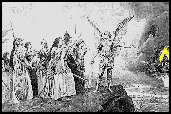
Wilhelm II.: "Völker Europas, wahrt Eure heiligsten
Güter!"
4. USA und Hawaii
4. Japanischer Buddhismus in Amerika
2. Chronik
1. Bis 1969
von Alois Payer
mailto: payer@payer.de
Zitierweise / cite as:
Payer, Alois <1944 - >: Materialien zum Neobuddhismus. --
4. USA und Hawaii. -- 4. Japanischer Buddhismus in Amerika. -- 2. Chronik.
-- 1. Bis 1969. -- Fassung vom 2005-07-14. -- URL:
http://www.payer.de/neobuddhismus/neobud04042.htm .
-- [Stichwort].
Erstmals publiziert: 1996-05-15
Überarbeitungen: 2005-07-14 [Ergänzungen]; 2005-07-07
[Ergänzungen]; 2005-06-30
[Ergänzungen]; 2005-06-24
[Ergänzungen]; 2005-06-22 [Aufteilung des Kapitels, Ergänzungen]; 2005-06-16
[Ergänzungen]; 2005-06-14
[Ergänzungen]; 2005-06-10
[Ergänzungen]; 2005-06-07
[Ergänzungen]; 2005-06-02
[Ergänzungen]; 2005-05-31
[Ergänzungen]; 2005-05-24 [Ergänzungen]; 2005-05-22 [überarbeitet]; 2005-05-20 [überarbeitet]; 2005-05-07 [überarbeitet
und erweitert]; 2005-04-30 [aufgeteilt und
überarbeitet]; 2005-04-29 [überarbeitet und stark erweitert]; 2003-06-28 [stark überarbeitet]
Anlass: Lehrveranstaltung Neobuddhismus, Univ. Tübingen, SS 1987, SS
2003, SS 2005
Copyright: Dieser Text steht der Allgemeinheit zur Verfügung. Eine Verwertung
in Publikationen, die über übliche Zitate hinausgeht, bedarf der ausdrücklichen
Genehmigung des Verfassers.

Diese Inhalt ist unter einer Creative Commons-Lizenz lizenziert.
Dieser Text ist Teil der Abteilung Buddhismus
von Tüpfli's Global Village Library
Chronik des japanischen Buddhismus in den USA
Zu Hawaii (erst seit 1898 US-Territorium) siehe:
Payer, Alois <1944 - >: Materialien zum Neobuddhismus. -- 4.
USA und Hawaii. -- 2. Buddhismus in Hawaii. -- URL:
http://www.payer.de/neobuddhismus/neobud0402.htm
Zu Soka Gakkai International USA siehe:
Payer, Alois <1944 - >: Materialien zum Neobuddhismus. --
4. USA und Hawaii. -- 4. Japanischer Buddhismus in Amerika. -- 3. Soka Gakkai
in Amerika. -- URL:
http://www.payer.de/neobuddhismus/neobud04043.htm
Zu den Buddhist Churches of America siehe:
Payer, Alois <1944 - >: Materialien zum Neobuddhismus. --
4. USA und Hawaii. -- 4. Japanischer Buddhismus in Amerika. -- 4. Buddhist Churches of America. -- URL:
http://www.payer.de/neobuddhismus/neobud04044.htm
Zum Beat-Buddhismus siehe:
Payer, Alois <1944 - >: Materialien zum Neobuddhismus. -- 4. USA und Hawaii.
-- 5. Beat-Buddhismus. -- URL:
http://www.payer.de/neobuddhismus/neobud0405.htm
1853
Commodore Matthew Calbraith
Perry (1794–1858) landet mit vier amerikanischen
Kanonenbooten vor Japan mit Schreiben des amerikanischen Präsidenten. Forderungen:
gastliche Aufnahme Schiffbrüchiger, Versorgung fremder Schiffe, Öffnung eines
japanischen Hafens für Handel mit USA. Russische Kriegsflotte vor Japan mit gleichen
Forderungen.
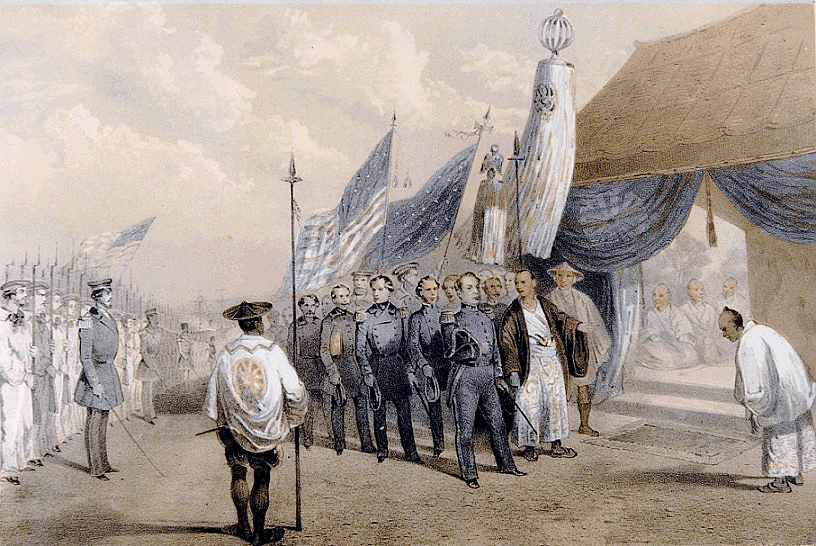
Abb.: Commodore Perry trifft die kaiserlich-japanischen Abgesandten in
Yokohama
[Bildquelle: Perry, Matthew Calbraith <1794–1858>:
Narrative of the Expedition of an American Squadron to the China Seas and
Japan. -- Washington : Nicholson, 1856. -- URL:
http://www.usna.edu/LibExhibits/SpecialCollections/Perry.htm. -- Zugriff
am 2003-05-06]
| "Perry, Matthew Calbraith, amerikan. Seefahrer, geb. 10.
April 1794 in Newport, gest. 4. März 1858 in New York, trat 1809 in die
Kriegsmarine der Vereinigten Staaten, focht 1812-14 im Kriege gegen
England, befehligte, 1837 zum Kapitän ernannt, im mexikanischen Kriege
das amerikanische Geschwader im Golf von Mexiko, führte 1852 die
Expedition der Vereinigten Staaten nach China und Japan und schloß 31.
März 1854 mit der japanischen Regierung den Vertrag von Kanagawa, durch
den die Häfen von Simoda und Hakodade den Amerikanern geöffnet wurden.
Er schrieb: »Narrative of the expedition to China and Japan 1852-1854
etc.« (Washingt. 1856-60, 3 Bde.). Vgl. Griffis, Life of Com. Matthew C.
P. (2. Ausg., Boston 1890)." [Quelle: Meyers großes
Konversations-Lexikon. -- DVD-ROM-Ausg. Faksimile
und Volltext der 6. Aufl. 1905-1909. -- Berlin :
Directmedia Publ. --2003. -- 1 DVD-ROM.
-- (Digitale Bibliothek ; 100). -- ISBN 3-89853-200-3. -- s.v.] |
1854
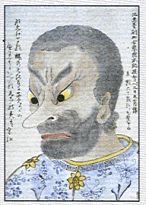
Abb.: Unbekannter japanischer Künstler: Commodore Perry
Commodore Perry kommt mit 10 Schiffen zurück, erhält die von
Japan geforderten Konzessionen.
|
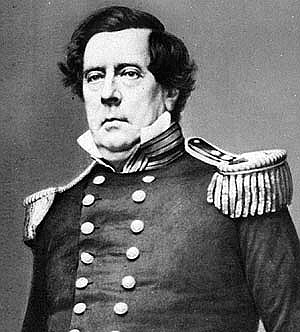
Abb.: Commodore Perry
"Matthew Calbraith Perry (April 10, 1794 – March 4, 1858)
was the
Commodore of the
U.S. Navy who forced the opening of Japan to the West with the
Convention of Kanagawa in 1854, under the threat of military force.
Early Life and Naval CareerBorn in
South Kingstown, Rhode Island, he was the son of Captain
Christopher R. Perry and the younger brother of
Oliver Hazard Perry. Matthew Perry obtained a midshipman's commission in the
Navy in 1809, and was initially assigned to Revenge, under
the command of his elder brother.
Perry's early career saw him assigned to several different ships,
including the President, where he was aide to Commodore
John Rodgers, which was in a victorious engagement over a
British vessel,
HMS Little Belt, shortly before the War of
1812 was officially declared. During that war Perry was transferred to
USS United States, and consequently saw little fighting in that war
afterward since the ship was trapped at
New London, Connecticut. After the war he served on various vessels in the
Mediterranean and Africa (notably aboard
USS Cyane during its patrol off Liberia in 1819-1820), sent to suppress
piracy and the slave trade in the West Indies. Later during this
period, while in port in Russia, Perry was offered a commission in
the Russian navy, which he declined.
Command Assignments, 1820s-1840sPerry commanded
Shark from 1821-1825, and from 1826-1827 acted as fleet captain for
Commodore Rodgers. Perry returned for shore duty to
Charleston, South Carolina in 1828, and in 1830 took command of
USS Concord. He spent the years of 1833-1837 as second officer of the New
York Navy Yard (later the
Brooklyn Navy Yard), gaining promotion to captain at the end of this tour.
Support for Naval Education and ModernizationPerry had a
considerable interest in naval education, supporting an apprentice
system to train new seamen, and helped establish the curriculum for
the
United States Naval Academy. Additionally, he was a vocal proponent of
modernization of the Navy. Once promoted to captain, he oversaw
construction of the Navy's second steam frigate,
USS Fulton, which he commanded after its completion. He was called "The
Father of the Steam Navy." He organized America's first corps of
naval engineers, and conducted the first U.S. naval gunnery school
while commanding Fulton in 1839-1840 off
Sandy Hook on the coast of New Jersey.
Promotion to CommodorePerry acquired the courtesy title of
commodore in 1841, and was made chief of the
New York Navy Yard in the same year. In 1843 he took command of the
African Squadron, whose duty was to interdict the slave
trade under the
Webster-Ashburton Treaty, and continued in this endeavor through 1844.
The Mexican-American WarDuring the
Mexican-American War Perry was in charge of the Gulf Fleet, and commanded the
force that captured
Frontera, Tabasco and
Laguna in 1846. In 1847 the forces under Perry's command supported the
siege of Veracruz.
The "Opening of Japan": 1852-1854First Visit, 1852-1853
In 1852, Perry embarked from
Norfolk, Virginia for Japan, in command of a squadron in search of a Japanese
trade treaty. Aboard a black-hulled steam frigate, he ported
Mississippi,
Plymouth,
Saratoga, and
Susquehanna at Uraga Harbor near Edo (modern Tokyo) on July 8, 1853, and
was met by representatives of the
Tokugawa Shogunate who told him to proceed to Nagasaki, where there was limited
trade with the
Netherlands and which was the only Japanese port open to foreigners at that
time. Perry refused to leave and demanded permission to present a
letter from President
Millard Fillmore, threatening force if he was denied. Japan had been living
reclusely apart from modern technology, and the Japanese military
forces could not resist Perry's modern weaponry; the "black ships"
would then become, in Japan, a symbol of threatening Western
technology and colonialism.
The Japanese government, so as to avoid naval bombardment, had to
accept Perry's coming ashore. Perry proceeded ashore at Kurihama (near
present Yokosuka) on July 14, presented the letter to delegates
present and left for the China coast, promising to return for a
reply.
Second Visit, 1854Perry returned in February, 1854 with
twice as many ships, finding that the delegates had prepared a
treaty embodying virtually all the demands in Fillmore's letter. Perry signed
the document on March 31, 1854 and departed, mistakenly believing
the agreement had been made with
imperial representatives.
On his way to Japan, Perry anchored off of Keelung in Formosa,
known today as Taiwan, for ten days. Perry and crew members landed
on Formosa and investigated the potential of mining the coal
deposits in that area. He emphasized in his reports that Formosa
provided a convenient, mid-way trade location. The island was also
very defensible. It could serve as a base for exploration in a
similar way as Cuba had done for the Spanish in the Americas.
Occupying Formosa could help the US counter European monopolization
of the major trade routes. The United States government failed to
respond to Perry's proposal to claim sovereignty over Formosa.
Return to the United States, 1855Upon Perry's return to
the United States in 1855,
Congress voted to grant him a reward of $20,000 in appreciation of his work in
Japan. Perry used part of this money to prepare and publish a report
on the expedition in three volumes, titled Narrative of the
Expedition of an American Squadron to the China Seas and Japan.
Last YearsPerry died three years later on March 4, 1858 in New
York City. His remains were removed to the Island Cemetery in
Newport, Rhode Island on March 21, 1866, along with those of his daughter, Anna,
who died in 1839.
MiscellanyPerry's middle name is often misspelled as Galbraith.
Among other mementos, Perry presented
Queen Victoria with a breeding pair of
Japanese Chin dogs, previously owned only by Japanese nobility.
Fictional depictionsThe story of the opening of Japan was
the basis of
Stephen Sondheim & John
Weidman's Pacific Overtures."
[Quelle:
http://en.wikipedia.org/wiki/Matthew_Perry_(naval_officer). --
Zugriff am 2005-04-27] |
1885
Ernest Francisco Fenollosa (1853 -
1908) und Dr.
William Sturgis Bigelow (1850-1926) (Wissenschaftler, die nach Japan gekommen
waren; Kunstgeschichtler) nehmen in Japan die 'Gebote' (san-ki-kai) des Tendai-Buddhismus
formell auf sich.
Siehe: Payer, Alois <1944 - >: Materialien zum
Neobuddhismus. -- 4. USA und Hawaii. -- 1. Anfänge des Buddhismus in
den USA. -- Fassung vom 2005-05-05. -- URL:
http://www.payer.de/neobuddhismus/neobud0401.htm
1888-08-14
Dr.
William Sturgis Bigelow (1850-1926) nimmt im Hiezan-Klosterdas
Bodhisattvagelübde des Tendai auf sich.
1893-09-11 bis 1893-09-27
The World's Parliament of Religions anlässlich der World's Columbian Exposition
Siehe: Payer, Alois <1944 - >: Materialien zum Neobuddhismus.
-- 2. International. -- 2. Das Weltparlament der Religionen in Chicago
1893. -- URL: http://www.payer.de/neobuddhismus/neobud0202.htm
1895-07-16
Dr.
William Sturgis Bigelow (1850-1926) in einem Brief an Rt. Rev.
Kanrio Naobayashi, Homoyin Temple, Otsu, Japan:
| "You ask if there are any other persons who would like to study
Buppo [Buddhism]. I think there would be a considerable number, but
not all from the best motives. Some from curiosity. Some from vanity.
Some in the hope of learning how to do miracles. And some from the
real spirit of kindness and help to others." [Zitiert in: Tweed, Thomas A.: The American encounter with Buddhism, 1844-1912 :
Victorian culture & the limits of dissent -- Chapel Hill, NC: University of
North Carolina Press, ©2000. -- 242 S. --
ISBN 0-8078-4906-5. -- [Originally published: Bloomington, Indiana University
Press, ©1992.]. -- S. 89.] |
1897
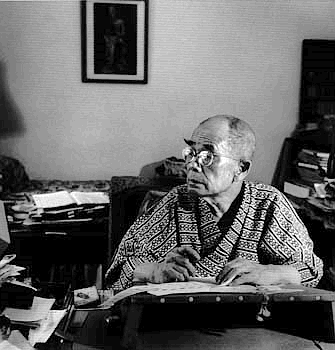
Abb.: D. T. Suzuki, 1950
[Bildquelle:
http://www.temple.edu/photo/photographers/morgan/photo9.html. -- Zugriff
am 2005-04-26]
Daisetz ("Große Einfachheit", Suzuki später: Große
Dummheit) Teitaro Suzuki (鈴木大拙) (1870-1966) kommt zu Paul Carus, um diesem - der kein
Chinesisch konnte - bei der Übersetzung des Tao Te king zu helfen.
| "Daisetz Teitaro Suzuki (1870, Kanazawa, Japan - 1966;
standard transliteration: Suzuki Daisetsu, 鈴木大拙) was a famous
author of books and essays on Buddhism and Zen that were
instrumental in spreading interest in Zen to the West. Early Life
The Samurai class into which Suzuki was born having declined with
the fall of feudalism in Japan, and his physician father having died,
Suzuki was raised in impoverished circumstances by his mother. When
he became old enough to reflect on his fate in being born into this
situation, he began to look for answers in various forms of religion.
His naturally sharp and philosophical intellect found difficulty in
accepting some of the cosmologies to which he was exposed.
His brother, a lawyer, financed his life and education in Tokyo
at
Waseda University. During this time (1891), he also entered spiritual studies at
Engaku-ji in Kamakura initially under
Kosen Roshi, then after Kosen’s death, with Soyen
Shaku. Soyen was an exceptional Zen monk. In his youth, his master, Kosen, and
others had recognized him to be naturally advantaged. Three years
after he had received “Dharma transmission” from Kosen at age 25,
Soyen took the unique step of traveling to Ceylon to study Pali and Theravada
Buddhism and live the alien life of the bhikkhu for three
years.
Under Soyen Shaku, Suzuki's studies were essentially internal and
non-verbal, including long periods of sitting meditation (zazen).
The task involved what Suzuki described as four years of mental,
physical, moral, and intellectual struggle.
During training periods at Engaku-ji, Suzuki lived the monk's
life. He described this life and his own experience at Kamakura in
his book The Training of the Zen Buddhist Monk. Suzuki was
invited by Soyen Shaku to visit the United States in the 1890s.
Suzuki acted as English-language translator for a book written by
him (1906). Though Suzuki had by this point done some translation
into English of ancient Asian texts, his role in translating and
ghost-writing aspects of this book was more the beginning of
Suzuki's career as a writer in English.
CareerWhile he was young, Suzuki had set about acquiring knowledge of Chinese, Sanskrit, Pali,
and several European languages. Soyen Shaku was one of the invited speakers at
the
World Parliament of Religions held in Chicago in 1893. When a German scholar
who had set up residence in Illinois, Dr. Paul Carus,
approached Soyen Shaku to request his help in translating and preparing Oriental
spiritual literature for publication in the West, the latter instead recommended
his disciple Suzuki for the job. Suzuki lived at Dr. Carus’s home and worked
with him, initially in translating the classic Tao Te
Ching from ancient Chinese. In Illinois, Suzuki began his early work
Outlines of Mahayana Buddhism.
Carus himself had written a book offering an insight into, and
overview of, Buddhism, titled The Gospel of Buddha. Soyen
Shaku wrote an introduction for it, and Suzuki translated the book
into Japanese. At this time, around the turn of the century, quite a
number of Westerners and Asians (Carus, Soyen, and Suzuki included)
were involved in the worldwide Buddhist revival that had begun
slowly in the 1880s.
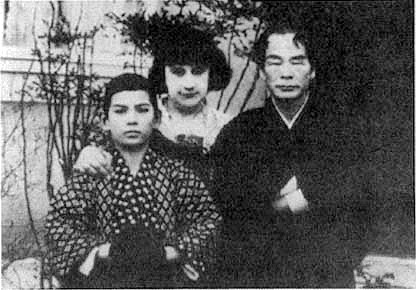
Abb.: D.T. Suzuki mit Frau Beatrice und Adoptivsohn Victor, 1925
[Bildquelle:
http://www.geocities.com/upakaascetic/lane.html. -- Zugriff am
2005-04-26]
Besides living in the
United States, Suzuki traveled through Europe before taking up a professorship
back in Japan. Suzuki married Beatrice Erskine Lane, a
Theosophist and Radcliffe graduate, in 1911. Dedicating themselves to spreading
an understanding of Mahayana Buddhism, they lived in a cottage on
the Engaku-ji grounds until 1919, then moved to Kyoto, where Suzuki
began professorship at
Otani University in 1921. While he was in Kyoto, he visted Dr.Hoseki Shinichi Hisamatsu,
a famous Zen Buddhist scholar and founder of the
FAS Society, and discussed Zen Buddhism together at
Shunkoin temple in
Myoshinji temple.
In the same year he joined Otani University, he and his wife,
Beatrice, founded the Eastern Buddhist Society; the Society is
focused on
Mahayana Buddhism and offers lectures and seminars, and publishes a scholarly
journal, The Eastern Buddhist. Suzuki maintained connections
in the West and, for instance, delivered a paper at the World
Congress of Faiths in 1936, at the
University of London.
Still a professor of Buddhist philosophy in the middle decades of
the
twentieth century, Suzuki wrote some of the most celebrated introductions and
overall examinations of Buddhism, and particularly of its Chinese Chan
school (though he usually referred to this sect by the term "Zen,"
which is the Japanese pronunciation of its name). Suzuki was
especially interested in the formative centuries of this Buddhist
tradition, in China. A lot of Suzuki's writings in English concern
themselves with translations and discussions of bits of the Chan
texts the Biyan Lu (Blue Cliff Record) and the Wumenguan
(Gateless Passage), which record the teaching styles and words of
the classical Chinese masters. He was also interested in how this
tradition, once imported into Japan, had influenced Japanese
character and history, and wrote about it in English in Zen and
Japanese Culture. Suzuki's reputation was secured in England
prior to the U.S.
In addition to his popularly oriented works, Suzuki wrote a
translation of the Lankavatara Sutra and a commentary on its
Sanskrit terminology. Later in his life he was a visiting professor
at
Columbia University. He looked in on the efforts of
Saburo Hasegawa,
Judith Tyberg, Alan Watts and the others who worked in the
California Academy of Asian Studies in San Francisco in the 1950s.
Suzuki is often linked to the Kyoto
School of philosophy, but he is not considered one of its official members.
Suzuki took an interest in other traditions besides Zen. His book
Zen and Japanese Buddhism delved into the history and scope of
interest of all the major Japanese Buddhist sects. He also wrote a
small volume about Shin
Buddhism. And he took an interest in Christian mysticism and some of the noted
off-beat mystics of the West.
D.T. Suzuki's books have been widely read and commented on by
many important figures. A notable example is An Introduction to Zen Buddhism,
which includes a thirty page commentary by famous
psychoanalyst
Carl Jung. Other works include Essays in Zen Buddhism (three volumes),
Studies in Zen Buddhism, and Manual of Zen Buddhism.
Additionally,
Willam Barrett has compiled many of Suzuki's articles and essays concerning Zen
into a volume entitled Studies in Zen.
Suzuki's Zen master, Soyen Shaku, who also wrote a book published
in the United States (English translation by Suzuki), had emphasized
the
Mahayana Buddhist outlook of the Zen tradition. Contrasting with this, to a
degree, was Suzuki's own view that in its centuries of development
in China, Zen (or Ch'an) had absorbed much from indigenous Chinese Taoism.
Suzuki believed that the Far-Eastern peoples had a sensitivity or
attunement to nature that was acute, by comparison with either the
people of Europe or the people of Northern India, generally speaking.
It was Suzuki's contention that a Zen satori (awakening) was the
goal of the training, but that what distinguished the tradition as
it developed, originally in China, was a way of life radically
different from that of Indian Buddhists. In India, the tradition of
the mendicant (holy beggar, bhikku in Pali) prevailed but, in
China, social circumstances led to the development of a temple and
training-center system in which the abbot and the monks all
performed mundane tasks. These included food gardening or farming,
carpentry, architecture, housekeeping, administration, and the
practice of folk medicine. Consequently, the enlightenment sought in
Zen had to stand up well to the demands and potential frustrations
of everyday life.
Despite Suzuki's pioneering efforts, today he is sometimes
considered a marginal figure, who was neither a formal Zen monk nor
a serious historian. This may be a somewhat harsh view, since some
clearly credible Western scholars, such as
Heinrich Dumoulin, have acknowledged some degree of debt to Suzuki's published
work. Nevertheless, Suzuki's view of Zen Buddhism, today judged to
be an idealized portrayal, as well as his ambivalent position toward
Japanese imperialism in the interwar years, have both come under
much scrutiny."
[Quelle:
http://en.wikipedia.org/wiki/Daisetz_Teitaro_Suzuki. -- Zugriff
am 2005-04-269 |
"Die von Kaiten Nukariya eröffnete Verwestlichung von Zen ist
dann aufs stärkste beschleunigt und intensiviert worden von Daisetz
Suzuki, der durch seine Bücher, durch seine langjährige Tätigkeit
als Professor der Columbia-Universität in New York und als
Gastprofessor an zahlreichen anderen amerikanischen und europäischen
Universitäten sowie durch seine Vortragsreisen Zen in seiner
englischen Sprachgestalt und in einer westlichen Interpretation in
der westlichen Welt verbreitet hat. Prof. Suzuki ist einer der
führenden Zen-Philosophen der Rinzai-Zen-Sekte und einer der besten
Kenner der Geschichte des Zen-Buddhismus. Trotzdem hat gerade er,
der so tief durch die buddhistische Mönchstradition des Rinzai-Zen
geprägt ist, aufs stärkste zur Loslösung des Zen von seiner
buddhistischen Wurzel beigetragen und gerade durch diese Loslösung
Zen für den Westen annehmbar gemacht.
Suzuki hat Zen zunächst einmal negativ abgegrenzt: Zen ist keine
Philosophie, es ist keine Metaphysik, es ist keine Religion. Gerade
der letzte Punkt wird von Suzuki nachdrücklich hervorgehoben und
gegen die traditionelle Selbstauffassung von Zen geltend gemacht:
»Zen behauptet, Buddhismus zu sein, aber alle buddhistischen Lehren,
wie sie in den Sûtras und Sâstras auseinandergesetzt werden, sind
für das Zen wertloses Papier, das zu nichts Besserem nutze ist, als
den Abfall des Intellekts aufzuwischen ... Zen ist frei von all
solchen dogmatischen und religiösem Lasten.« Damit wird Zen nicht
nur seiner buddhistischen Herkunft, der Bindung an jegliche positive
Religion entschränkt — es beansprucht, die Quintessenz aller
positiven religiösen oder philosophischen Systeme zu sein. »Zen
verkündet von sich selbst, dass es der Geist des Buddhismus ist, in
Wirklichkeit ist es der Geist aller Religion und Philosophie.«
Gerade durch diese These hat Suzuki das Zen besonders attraktiv
gemacht: denn damit wird auf der einen Seite behauptet, dass es von
jeder beliebigen positiven Religion, auch vom Christentum her, einen
Zugang zu Zen gibt, das bedeutet aber auch andererseits, dass man
keiner besonderen positiven Religion angehören muss, um einen Zugang
zu Zen zu finden. Zen wird hier allen freigegeben, den gläubigen
Christen wie den enttäuschten Christen. »Christen können Zen ebenso
ausüben wie Buddhisten, genau so, wie große und kleine Fische
zufrieden miteinander im selben Ozean leben;«
Ohne Zweifel hat Suzuki mit diesen Gedanken die weltweite Wirkung
von Zen gerade im christlichen bzw. entchristlichten Europa und dem
nicht minder christlichen und nicht minder entchristlichten Amerika
befördert. Zen ist damit an die Spitze der modernen Ersatzreligionen
getreten, die sich in der christlich-entchristlichten Welt heute
nach vorne drängen.
Diese Ablösung des Zen von seinen buddhistischen Grundlagen und die
dadurch geschaffene Voraussetzung für seine Verwestlichung ist noch
dadurch intensiviert worden, dass Suzuki zu seiner positiven Deutung
von Zen das zentrale Erlebnis der Erleuchtung, satori, psychologisch
interpretiert. Schon in seinem ersten Werk über Zen, den »Essays in
Zen Buddhism I«, London 1927, schreibt Suzuki: »Wie unser
gewöhnliches Bewusstseinsfeld ausgefüllt ist mit allen möglichen
Arten von Bildern, wohltuenden und schädlichen, geordneten und
verwirrenden, klaren und dunklen, sich aufzwingenden und schwach
dahinschwindenden, so ist das Unterbewusstsein ein Schatzhaus für
jegliche Form von Okkultismus und Mystizismus, darunter all das
verstanden, was latent oder abnormal oder psychisch oder
spiritualistisch ist. Auch mag hier die Kraft verborgen liegen, in
die Natur des eigenen Seins zu schauen und dies mag es sein, was das
Zen in unserer Bewusstheit aufweckt. Jedenfalls sprechen die Meister
figürlich vom öffnen eines dritten Auges.« In diesem Sinne nennt
Suzuki des satori, den Durchbruch zur Erleuchtung, »eine Einsicht in
das Unbewusste« (in dem zweiten Band seiner Essays in Zen Buddhism,
London 1933, deutsch: Der Weg zur Erleuchtung, Baden-Baden 1957, S.
46).
Pater Heinrich Dumoulin S. J. hat mit Recht in seinem Werk »Zen,
Geschichte und Gestalt«, Bern 1959, Sammlung Dalp, Bd. 7, auf die
epochale Bedeutung dieser psychologischen Interpretation des Zen
durch Suzuki hingewiesen: »Mit dem Begriff des Unterbewusstseins
führte Suzuki, wahrscheinlich ohne sich selbst von der Tragweite
seiner Entdeckung Rechenschaft zu geben, das Kennwort der modernen
Tiefenpsychologie in die Literatur über das Zen ein.« Sicher hat
Dumoulin recht, wenn er darauf hinweist, dass die Worte mancher
Zenmeister, in denen vom Schauen der eigenen Natur die Rede ist,
oder auch Erlebnisberichte, die das Aufplatzen einer unbekannten
Tiefenschicht in der Seele anzeigen, in diese Richtung weisen und
Suzuki »das Wort vom Unterbewusstsein geradezu eingegeben haben
mögen«. Doch ist die buddhistische Mystik nicht die einzige Wurzel
der Tiefenpsychologie; die Psychologie ist wohl überhaupt
wissenschaftsgeschichtlich ein Kind der Mystik. Die großen
christlichen Mystiker, von Augustin angefangen bis hin zu Johann vom
Kreuz und zur Heiligen Therese, waren durch die Gewalt ihrer
mystischen
Erfahrung selbst dazu genötigt, sich nachträglich bei dem Versuch
einer intellektuellen Deutung ihrer Erlebnisse die Frage zu stellen:
Wie ging dies zu? Wie hat sich dieses Erlebnis in der Seele
abgespielt, wie muss die Seele beschaffen und disponiert sein, damit
ihr dieses Erlebnis widerfährt? So führt die Besinnung auf den
Grund, den Vorgang und Ablauf der mystischen Erfahrung von selbst
zur mystischen Psychologie.
Auch die aus der christlichen Mystik hervorgegangene Psychologie hat
das Unterbewusste entdeckt, angefangen von den Reflexionen Augustins
über den »Bauch des Gedächtnisses«. Nicht nur bei den Buddhisten, in
deren Seelenlehre die Bewusstseinsschatzkammer mit ihren
aufgespeicherten Samen eine wichtige Rolle spielt, sondern auch bei
den christlichen Mystikern finden sich auffallende Gegenstücke zur
modernen tiefenpsychologischen Sicht des Unbewussten, und gerade in
Eduard von Hartmanns »Philosophie des Unbewussten« (1869) kommen
neben den ihm über Schopenhauer zuströmenden buddhistischen
Einflüssen solche Einflüsse von Seiten der christlichen Mystik
durchaus wieder zu Worte. Der entscheidende Unterschied ist jedoch,
dass die christliche Mystik bei all ihren Versuchen einer
psychologischen Deutung des mystischen Erlebens das Erleben selbst
nicht völlig psychologisierte, nicht als einen Ausbruch des
Unbewussten ins Bewusstsein hinein erklärte, sondern als eine
Begegnung mit dem Transzendenten verstand und seine metaphysischen
Wurzeln nie bestritten hat.
Suzuki bestreitet aber gerade diesen metaphysischen Charakter des
satori. Das Unterbewusstsein wird verstanden als das »eigene
Selbst«, in das der Mensch im satori hinabsteigt und Einsicht
gewinnt. »Nach der Grundidee des Zen sollen wir mit den innersten
Kräften unseres Wesens in Fühlung kommen, und zwar auf dem
kürzestmöglichen Wege, ohne Rückgriff auf irgend etwas Äußeres oder
Zusätzliches.« Das Zen-Leben ist ein »schlichtes und unmittelbares
Festhalten an der Wahrheit, die in unserem innersten Wesen ruht«.
»Schau hinab in Dein eigenes Wesen und suche es nicht durch andere.
Dein eigener Geist ist jenseits aller Form, ist frei, still und sich
selbst genügend.« In ähnlicher Weise sagt Suzuki in seinem Buch über
Zen und die Kultur Japans (rde 66 S. 12): »Was Zen erreichen will,
ist diese dritte Art Wissen (das intuitive Wissen), die tief in die
Wurzeln des eigenen Daseins hinabreicht, oder besser: die aus den
Tiefen unseres eigenen Wesens emporwächst.«
Ein bedeutender japanischer Religionspsychologe, Prof. Hideo
Kishimoto, hat die eigentümliche Psychologisierung, die Suzuki mit
Zen vorgenommen hat, genauer untersucht (in einer japanischen
Abhandlung: Shukyo to shinri no mondai to shite no Zen to Nembutsu
(Zen und Nembutsu als religiöses und psychologisches Problem), in:
Shukyo Kenkiu (Religionswissenschaftliche Abhandlungen) 1937, Jg.
XIV S. 133—144. Er hat dort nachgewiesen, dass Suzuki in seinen
Büchern versucht, Zen in seiner psychologischen Eigentümlichkeit
dadurch dem westlichen Leser begreiflich zu machen, dass er sich der
Kategorien der amerikanischen religionspsychologischen Schule
bedient. In Anlehnung an die vier Kennzeichen des mystischen
Zustandes, die der amerikanische Religionspsychologe William James
in seiner Religionspsychologie hervorgehoben hat —
Unaussprechlichkeit, noetische Qualität, Unbeständigkeit und
Passivität — führt er acht Merkmale des satori auf, die er dann im
einzelnen analysiert: Irrationalität, Intuitive Einsicht,
Autoritativer Charakter, Bejahung, Sinn für das Drüben,
Unpersönliche Färbung, Exaltationsgefühl, Augenblicklichkeit.
Dumoulin hat darauf aufmerksam gemacht, dass Suzuki dem Werk von
William James über die Mannigfaltigkeit der religiösen Erfahrung
wahrscheinlich noch eine andere wichtige Anregung für sein
psychologisches Verständnis des satori verdankt. James schreibt
einen Hauptantrieb zum religiösen Leben den aus dem Unterbewussten
einbrechenden verborgenen Kräften zu. Ohne den Bogriff des
Unterbewusstseins, oder, wie er es auch bezeichnet, des Subliminalen
klar zu umreißen, nennt er das Unterbewusste »den Wohnsitz für alles
Verborgene und das Reservoir für alles, was unverzeichnet und
unbemerkt bleibt«, »die Quelle unserer Träume« und den »Mutterboden
aller unserer mystischen Erfahrungen und übernormalen Erkenntnisse«.
Möglicherweise haben diese Ausführungen von William James und seine
Überzeugung, dass die stärksten gestaltenden Kräfte aus dem
unerforschten Bereich des »Subliminalen« in die Religionsgeschichte
eintreten, Suzuki bestimmt, das satori-Erlebnis als den Durchbruch
des Unterbewussten in das Bewusstsein zu interpretieren. Die Heilung
des im Widerspruch von Ja und Nein zerfetzten Bewusstseins kann nur
vom Unterbewusstsein her erfolgen.
Eben damit hat Zen die Aufmerksamkeit der modernen westlichen
Psychologie erregt, denn hier ist ja durch Suzuki das Stichwort für
den Auftritt der Psychologie und der Psychotherapie auf der Bühne
des modernen Geisteslebens in der Rolle der großen modernen
Ersatzreligion gegeben, die nicht nur den Sinn aller Religionen
psychologisch interpretiert, sondern auch in ihrer Therapie die
»Heilung« verspricht, die bisher die Religionen für ihren jeweiligen
Heilsweg in Anspruch genommen haben."[Quelle: Benz, Ernst
<1907 - 1978>: Zen in westlicher Sicht : Zen-Buddhismus -
Zen-Snobismus. -- Weilheim/Obb. : O. W. Barth,
1962. -- 107 S. ; 21 cm. -- (Zeichen und Symbole). -- S. 21 - 26.] |
1897
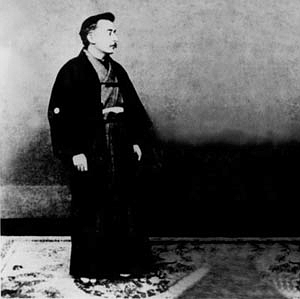
Abb.: Lafcadio Hearn, um 1890
[Bildquelle:
http://www.preoccupations.org/2004/03/. -- Zugriff am 2005-04-27]
Hearn, Lafcadio <1850-1904>: Gleanings in Buddha-fields : studies of
hand and soul in the Far East. -- Boston : Houghton, Mifflin, 1897. -- 296 S.
-- Online:
http://www.sacred-texts.com/bud/gbf/index.htm. -- Zugriff am 2003-04-25
Siehe: Payer, Alois <1944 - >: Materialien zum
Neobuddhismus. -- 4. USA und Hawaii. -- 1. Anfänge des
Buddhismus in den USA. -- Fassung vom 2005-05-05. -- URL:
http://www.payer.de/neobuddhismus/neobud0401.htm
| "Patrick Lafcadio Hearn (June 27, 1850 -
September 26, 1904), also known as Koizumi Yakumo (小泉八雲 Koizumi Yakumo)
after gaining Japanese citizenship, was an author, best known for
his books about Japan. He is especially well-known to the Japanese
for his collections of Japanese fairy tales, one of which was made
into a film by
Masaki Kobayashi (Kwaidan (1965)). Hearn was born in Lefkada (the
origin of his middle name), one of the Greek
Ionian Islands. He was the son of Surgeon-major Charles Hearn, of
King's County, Ireland, and Rosa Antonia Kassimati of Lefkada, Greece. His
father was stationed in Lefkada during the English occupation of the
Ionian Islands. Lafcadio Hearn moved to Dublin, Ireland at the age of 6.
Artistic and rather bohemian tastes were in Lafcadio Hearn's blood.
His father's brother Richard was at one time a well-known member of
the
Barbizon set of artists, though he made no mark as a painter through his lack of
energy. Young Hearn had rather a casual education, but was for a
time (1865) at
Ushaw Roman Catholic College, Durham.
The religious faith in which he was brought up was, however, soon
lost and, at 19, he was sent to live in the
United States of America where he settled in
Cincinnati, Ohio. There he developed a lifelong friendship with the English
printer, and radical utopian, Henry
Watkin. With Watkin's help, Hearn picked up a living in the lower grades of
newspaper work. Through the strength of his talent as a writer,
Hearn quickly advanced through the newspaper ranks and became a
reporter for the
Cincinnati Daily Enquirer, working for the paper from 1872 to 1875. With
creative freedom in one of Cincinnati's largest circulating
newspapers he developed a reputation for sensitive, dark, and
fascinating accounts of Cincinnati's disadvantaged. He continued to
occupy himself with journalism and with out-of-the-way observation
and reading, and meanwhile his erratic, romantic and rather morbid
idiosyncrasies developed. While in Cincinnati, he married Mattie, an
black woman, an illegal practice at the time. When the scandal was discovered
and publicized, he was fired from the Enquirer and went to work for
the rival Cincinnati Commercial. But the smoke and pollution in
Cincinnati bothered his sensitive eyes, so he left the city in 1877
for New Orleans.
He was from 1877 through 1888 in
New Orleans, Louisiana writing for the
Times Democrat newspaper. His writings about New Orleans focused on the city's Creole
history, distinctive cuisine, underworld, and Voodoo. His writings
for national publications like Harper's Weekly and Scribner's Magazine
helped mold the popular image of New Orleans as a colorful place of
decadence and hedonism. His best known book on Louisiana is Gombo Zhebes
(1885).
The Times Democrat sent Hearn to the West
Indies as a correspondent in 1889. He spent two years in the islands and
produced Two Years in the French West Indies and Youma,
The Story of a West-Indian Slave (both 1890).
In 1891 Lafcadio Hearn went to Japan with a commission as a
newspaper correspondent, which was quickly broken off. It was in
Japan, however, that Hearn found his home and his greatest
inspiration.
Books written by Hearn on Japanese subjects:
- Glimpses of Unfamiliar Japan (1894)
- Out of the East: Reveries and Studies in New Japan (1895)
- Kokoro: Hints and Echoes of Japanese Inner Life (1896)
- Gleanings in Buddha-Fields: Studies of Hand and Soul in
the Far East (1897)
- Exotics and Retrospectives (1898)
- Japanese Fairy Tales (1898) and sequels
- In Ghostly Japan (1899)
- Shadowings (1900)
- A Japanese Miscellany (1901)
- Kottō: Being Japanese Curios, with Sundry Cobwebs (1902)
-
Kwaidan: Stories and Studies of Strange Things (1903)
- Japan: An Attempt at Interpretation (1904; published
just after his death)
- The Romance of the Milky Way and other studies and
stories (1905; published posthumously)
During the 1890s, he became a teacher of English literature at
the
Tokyo Imperial University, and soon fell completely under the spell of Japan. He
married a Japanese wife, the daughter of a samurai, became a
naturalized Japanese under the name of Koizumi Yakumo, and
adopted the Buddhist religion. His health was failing for the last
two years of his life and he was deprived of his lecturership at the
University.
In the late 19th
century Japan was still largely unknown and exotic to the Western world. With
the introduction of Japanese aesthetics, however, particularly at
the Paris World's
Fair in 1900, the West had an insatiable appetite for exotic Japan, and Hearn
became known to the world through the depth, originality, sincerity
and charm of his writings. In later years, some critics (such as
George Orwell) would accuse Hearn of transferred nationalism and
exoticizing Japan, but as the man who offered the West some of its first
glimpses into pre-industrial and Meiji Era Japan, his work still
offers valuable insight today."
[Quelle:
http://en.wikipedia.org/wiki/Lafcadio_Hearn. -- Zugriff am
2005-04-27] |
1898-07-06
Eryu Honda und Ejun Miyamoto kommen als geistliche Vertreter
von Hompa Hongwanji nach San Francisco. Kurz darauf erfolgt die Gründung der Young Men's Buddhist Association
(YMBA) (Bukkyo Seinen Kai)
in San Francisco.
| "The history of the Buddhist Churches of
America traces itself back to the formation of the San Francisco Young Men's
Buddhist Association (YMBA) in 1899. The original association not only motivated
the Honganji in Japan to send over two priests, but also became the inspiration
for other groups to organize themselves including the Young Women's Buddhist
Association. Perhaps largely due to the youthful zeal of these individuals, the
local "Young Buddhist Association (YBA)" movement continued to grow until on
January 15-16, 1926 the League of Young Men's Buddhist Associations of North
America was founded, organizing all the different YBA's into a unified
organization. The following year, the North American Federation of Young Women's
Buddhist Association League held its first annual conference in San Pedro,
California. In 1930, 10 delegates representing the Jodo Shinshu young adults of
the continental United States would attend the first Pan-Pacific Federation of
Young Buddhist Leagues General Conference held in Honolulu from July 21-31. In
1936 the YBA would again re-organize,
this time combining the YMBA and the YWBA to form the California Young Buddhist
League (CYBL). In 1937, the newly formed held its first conference in Sacramento
drawing more than 800 delegates. It was during this conference that plans for a
truly national organization was discussed. In 1939, the dream of a national
conference became a reality when the first national YBA conference was held from
March 31-April 3, 1939 in San Francisco. Over 1,000 delegates from California,
Arizona, the Northwest States and Inter-Mountain districts attended.
The momentum created by these conferences,
however, came to an abrupt halt with the bombing of Pearl Harbor and the
subsequent internment of all Americans of Japanese Heritage. The YBA would not
be able to organize again until 1947 when the CYBL became the Western Young
Buddhist League (WYBL). The new WYBL included chapters from California and
Arizona. The first post-war conference was held in 1948 in Los Angeles. Also in
1948 an ambitious attempt to organize all the different Young Adult Buddhist
groups in the United States, not limited to Jodo Shinshu, into a national
organization was started as the National Young Buddhist Coordinating Committee (NYBCC).
However, the NYBCC was never fully able to organize and the same body became the
National YBL in 1950 with the goal of organizing all the different Jodo Shinshu
Buddhist Young Adult groups into a national body.
Since that time, the WYBL has had the
motivation, enthusiasm, determination, and organization to host a conference
every year." [Quelle:
http://www.geocities.com/Athens/5443/bcacent_morehistory.htm. --
Zugriff am 2003-06-14] |
1898-09-17
In Mason Street San Francisco eröffnet die Young Men's Buddhist Association
den ersten rein buddhistischen Tempel in den kontinentalen USA.
1899
Es erscheint:
Fenollosa, Mary McNeil <1865 - 1954>:
Out of the
nest : a
flight of verses. -- Boston : Little, Brown, 1899. -- ix, 110 S. 18
cm.
Die Autorin ist in zweiter Ehe die zweite Ehefrau von Ernest Fenollosa.
Viele der hier veröffentlichten Gedichte spiegeln ihre Begegnung mit
japanischem Buddhismus.
1899-09
Dr. Shuye Sonoba und Rev. Kahuryo Nishijima kommen als
Jodo-Shinshu-Missionare nach San Francisco. Sie gründen das, was 1914 als
Buddhist Mission of North America als Körperschaft registriert wird.
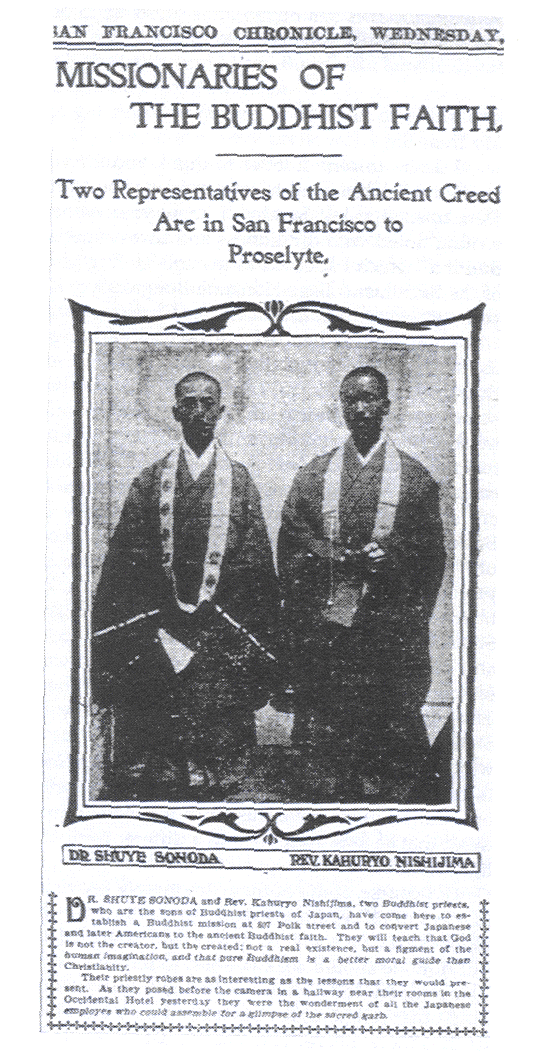
Abb.: Bericht im San Francisco Chronicle
[Bildquelle: Asian religions in America : a documentary history / edited by
Thomas A. Tweed, Stephen Prothero. -- New York : Oxford University Press,
©1999. -- 416 S. : Ill. -- ISBN
0-19-511339-X. -- S. 79]
Text des Artikels im San Francisco Chronicle vom 1899-09-12:
"Two Buddhist priests from Japan, Dr. Shuye Sonoda and the Rev.
Kahuryo Nishijima, have come to San Francisco to minister to the
spiritual wants of their countrymen and at the same time to
undertake the work of converting the Christians of this city to
their faith. On Wednesday they will open a Buddhist mission at 807
Polk Street. Here religious services will be held every Sabbath, for
they are willing to conform to the national day of worship, and from
this as a center it is proposed to circulate printed tracts which
shall set forth the merits and beauties of the ancient Buddhist
faith, as compared to the doctrines of Christianity. Last evening
Dr. Sono-da, who holds the degree of doctor of philosophy from the
Imperial University of Japan, candidly stated his intentions and
hopes.
"Our primary object is to instruct the Japanese who are here,"
he said earnestly, "but that is not our goal, but merely a
preliminary step, which we shall follow with the circulation of
pamphlets among Americans, setting forth the meaning of Buddhism.
We believe that we are governed only by law, not by any
personified God. We have within us the highest guidance, the
Kharma [sic]. Before people can comprehend the truth they must
be freed from delusion. God is not the creator, but the created.
We ourselves create God. He is not a real existence, but a
figment of the human imagination. We discover our true nature;
we ourselves are Buddha. Buddha and we are not heterogeneous,
but only represent differences in degree. We ought not to ask
benefits for our external being. We should seek the highest
development of our inner nature, and we must remove our own
imperfections, relying on no other power. I firmly believe that
Buddhism is a better moral guide than Christianity. Our plan
here is first to establish a church, then an evening school for
our own people, and as we become more proficient in English, to
communicate with those among Americans who wish to investigate
Buddhism."
Both Dr. Sonoda and his assistant, Mr. Nishijima, are sons of
Buddhist priests. They belong to that branch of their religion which
is known as the Shin-shu, or "true sect," and is the most powerful
in Japan, having the largest and most elegant temple, called the
West-em, or Honguwangi."
[Quelle: San Francisco Chronicle. -- 1899-09-12] |
Shuye Sonoda schreibt am 14. September (?) 1899 an Paul
Carus (1852-1919), den Herausgeber der Zeitschrift The Open Court:
| "San Francisco September [?] 14, 1899
My Dear Sir,
I desire to send a letter to thank you for your kindness shown to my
assistant Mr. Nishijima and to inform you of our public lectures on
Buddhism which were opened at last Sunday. I knew your name at home
through your excellent writing tinted with candidness and I was especially
interested in your "Gospel of Buddha" which I adopted as my college
English text when I became the principal of the Buddhist college Honganji
Bungakuryo, Kioto. On landing here I met with your late essay "Buddhism
and its Christian critics" and was astonished. . . .
Though weak handed, we are now carrying on our work trusting to the
protection of the merciful Buddha. My opening remarks at the first meeting
read thus: My dear sisters and brethren I am very happy to see here all
who wish to search earnestly after truth, but I am afraid you can not
understand me well for my English is very poor and the oriental framework
of thought widely differs from the occidental one. So I beg [you] to
listen to me patiently a little while. I came here with my assistant Mr.
K. Nishijima to instruct our countrymen who are staying here and to
propagate gradually our doctrine among Americans. Buddhism is richly
suited to expansion and propagation. It is destined to be the universal
religion. We must propagate it throughout the world. Why have we preferred
the New World? As you know, the United States was established by liberty
and is governed by liberty. Liberty is the soul of the States. The United
States is the kingdom of liberty. The people are very liberal. They are
very tolerant. They are free from the prejudice which always accompanies
the people of an old country. They are fond of seeking truth. They welcome
the truth in any form. Their want is not form but essence. So every
religion may find its way in the States. In the universe there is one and
only one truth, and it is the common stock which ought to be equally
enjoyed by mankind as a whole, free from the distinctions of race,
nationality, age, sex, etc.. ., and can not be monopolized by any one. All
religions have this truth for their ultimate end, but it must be borne in
mind that each represents it in a different way. So from one point of view
the religious differences are considered as the different methods of
arriving at the truth.
Of course, some of them are merely provisional, while some are real,
yet the masters of all religions made equal efforts for the benefit of
humanity, and their merit must be recognized to a certain extent. Mankind
is destined to seek the truth but how he should seek it is left to himself.
So he is not restricted to any particular religion. If he thinks one
religion inadequate to reach the goal, then he may hold other religions,
for the truth is only our object and the method of finding the truth is
mere means. The object must be constant but the means may be variable. If
you have the privilege of believing Christianity, you also have the
privilege of believing Buddhism. You are not bound to be Christians but
bound to search for truth. Christianity may be the perfect way, but no
Christian has any right to call Buddhism heretical, unless he thoroughly
understands Buddhism and finds
faults in it, for without tasting the meat we can not judge whether it is
good or bad. There are some Christians who are accustomed to say that
Christianity only is orthodoxical, that it alone reveals the truth, and to
call Buddhism heretical, but such Christians only expose their ignorance
of Buddhism.
To search for truth one must get rid of prejudice. If one will
carefully and honestly look on Buddhism, he will surely find it very
praiseworthy. This is not merely my supposition but many authorities
support me. For instance, the learned Fausböll declares [?] as follows:
"The more I learn to know Buddha the more I admire him and the sooner
all mankind shall have been made acquainted with his doctrines the
better it will be, for he is certainly one of the heroes of humanity" (The
Jatakas, iv of Romantic Legend of Sakya Buddha).
Professor Müller says:
"The moral code of Buddhism is one of the most perfect the
world has ever known."
Dr. Paul Carus also remarks:
"Whatever Buddha's doctrines may have been, this much is sure, that
the principle of Buddhism is the same as the principle of the religion
of Science; for Buddhism is the religion of enlightenment, and
enlightenment means a perfect comprehension of the significance of life
in matters of religion. How it is strange that in those two points which
constitute the main difference between Buddhism and Christianity, viz.,
creation and the nature of the soul, modern science, represented
exclusively by scientists educated in Christian schools and with a
Christian tradition of two millenniums, will certainly side with
Buddhism."
It is very remarkable that we find the Christian missionary Bishop
Bigandet speaking thus:
"The Christian system and the Buddhist one, though differing from
each other in their respective object and ends as much as truth from
error, have it must be confessed, many striking features of an
astonishing resemblance. There are many moral precepts equally commanded
and enforced in common by both creeds. It will not be considered rash to
assert that most of the moral tenets prescribed by the gospel are to be
met with in the Buddhistic scriptures. In reading the particulars of the
life of the last Buddha Gautama, it is impossible not to be reminded by
many circumstances relating to our Savior's life as it has been sketched
by the Evangelists" (p. 424, Life and Legend of Gautama).
Thus one who has studied Buddhism admires it; and one who has studied
Buddhism much, admires it much.
So it is very evident that Buddhism is excellent. I do not come here to
compel you to believe Buddhism blindly, but I come to ask you to
investigate Buddhism honestly and earnestly. Buddha's mercy brings comfort
to the weary ones of the world. It is his wish to deliver all creatures in
all directions.
To realize this idea is my duty. How is it possible for me to remain idle?
So I came here to explain his doctrine under his command. As Buddha taught,
the truth had existed before he was born into this world, but at his birth
it took its abode in his body. It was revealed by him. He is the bodily
incarnation of the truth. Truth alone is the savior from mercy. Let us
take refuge in Buddha.
After these few remarks I described the essential points of our
doctrine as our introduction. After my lecture some questions were raised
by the audience which Mr. Nishijima and I explained away. The first
meeting was pretty satisfactory. This is the first attempt at the
propagation of the new light of the truth in the New World, though our
doctrine has been brought here in books by the endeavours of such learned
scholars as you. I find much difficulty in conveying the oriental faith to
occidental people. So we require your valuable aid.
I can not close my letter without expressing our indebtedness to you
for your noble effort to cause the Christian people to understand Buddhism.
Yours very sincerely, S. Sonoda"
[Zitiert in: Asian religions in America : a documentary history / edited by
Thomas A. Tweed, Stephen Prothero. -- New York : Oxford University Press,
©1999. -- 416 S. : Ill. -- ISBN
0-19-511339-X. -- S. 80-82] |
1899-11-28
In San Francisco gründet die Buddhist Mission of North America eine Gruppe
zur Missionierung von Weißen ("Kaukasier"), später (1900-04)
Dharma Sangha of Buddha genannt. Eine der ersten Funktionäre war
Eliza R. H. Stoddard, die auch als Medium wirkte.
1900
Honganji in Kyoto (Japan) publiziert die
Zeitschrift Beikoku Bukkyo (US Buddhism) für japanische Shin
Buddhisten in den USA.
1900-04-08
In San Francisco halten die Revds. Nishijima und Sonoda anläßlich der Feier
von Buddhas Geburtstag einen
buddhistischen Gottesdienst für Weiße ab. Sie predigen in English zu 150
Weißen.
Im Laufe der Zeit gibt die Buddhist Mission japanisch-buddhistische
Wörter durch englische aus der christlichen Tradition wieder, z.B..:
- socho - bishop
- gatha (偈・伽陀) - hymn
- kaikyoshi / jushoku (住職 ) - minister
- Bukkyokai / otera (お寺)
- church / temple
- dana (布施) - gift
- sangha (僧伽) - brotherhood of Buddhists
Ritualtermini dagegen behielt man bei, z.B.:
- shoko (焼香)
- incense offering
- juzu (数珠)
/ nenju - rosary
- koromo (法衣)
- colored robe
1900-05-16
Nichtjapanisch Mitglieder der Buddhist Mission of North America gründen den
Dharma Sangha of Buddha "for any
person, regardless of race or gender, interested in learning about the
Buddhadharma.”
1900
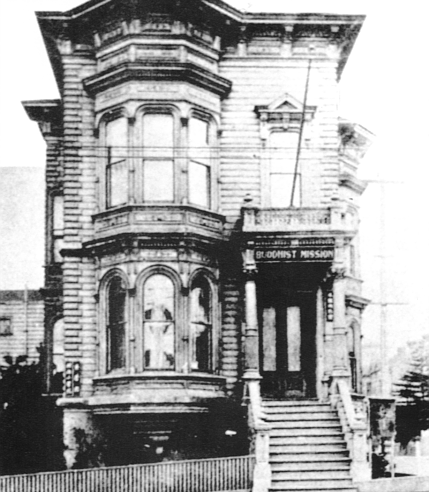
Abb.: Buddhist Church of Sacramento, 1900
[Bildquelle: Tricycle : the Buddhist review. -- ISSN 1055-484X. --
Vol. XI, No. 1 (Fall 2001). -- S. 82.]
1901 - 1907
The Light of Dharma. -- San Francisco, CA. : Buddhist Mission, .
-- Vol. 1, no. 1 (April 1901) - 1907 -- :"A religious magazine devoted
to the teachings of Buddha". -- Published bi-monthly
Thomas A. Tweed gibt folgende Analyse der Subskriptionsliste
dieser Zeitschrift:
Analysis of the "List of Subscription, Contribution, and
Exchange" for The Light of Dharma, 1901-1907
I. United States and Foreign
| Category of Listing |
Country |
| |
U.S. |
Foreign |
| Subscriptions (Paying subscribers) |
101 |
24 |
| Contributions (Persons/institutions sent the
magazine without charge) |
48 |
65 |
| Exchanges (Periodicals that sent their own
publication in exchange for a copy of LD) |
31 |
5 |
| Total Persons Listed |
204 |
| Total Institutions Listed |
99 |
II. United States and Its Possessions
Total Persons and Institurions Listed with Addresses in U.S. and Its
Possessions: 199
Gender of Subscribers
- 60% male (61/101)
- 40% female (40/101)
Ethnicity of Subscribers
- 97% non-Asians (98/101)
- 3% Asian descent (3/101)
Urban vs. Rural Subscribers: 65% urban"
[Quelle: Tweed, Thomas A.: The American encounter with Buddhism, 1844-1912 :
Victorian culture & the limits of dissent -- Chapel Hill, NC: University of
North Carolina Press, ©2000. -- 242 S. --
ISBN 0-8078-4906-5. -- [Originally published: Bloomington, Indiana University
Press, ©1992.]. -- S. 163] |
| "There were about three hundred to four hundred copies of Light
of Dharma circulated before 1904 since many of the institutions who
received the magazine got multiple copies (usually 5), and starring
in October of 1904 they added two hundred copies of each issue.
These are conservative estimates based on the figures contained in
the subscription list and information given in the pages of the
magazine. According to the subscription list, Japanese Buddhist
Churches on the Pacific Coast and in Hawaii received multiple copies
of the magazine. At least nine university libraries were sent the
magazine, including most of the major institutions of the time:
Harvard, Yale, Columbia, Johns Hopkins, Pennsylvania, Stanford, and
Berkeley. The magazine also had an exchange agreement with at least
thirty-six other magazines and newspapers in the United States and
abroad." [Quelle: Tweed, Thomas A.: The American encounter with Buddhism, 1844-1912 :
Victorian culture & the limits of dissent -- Chapel Hill, NC: University of
North Carolina Press, ©2000. -- 242 S. --
ISBN 0-8078-4906-5. -- [Originally published: Bloomington, Indiana University
Press, ©1992.]. -- S. 183, Anm. 40.] |
1901
Es erscheint:
Frank Graeme Davis to Rev. Nishijima, 27 April 1901. -- In: Light
of Dharma. -- 1 (June 1901)
"The self-proclaimed Buddhist in Vermillion, for instance, was
Frank Graeme Davis, a student at the University of South
Dakota. He corresponded with Japanese Buddhists in San Francisco and
subscribed to the magazine they published. In one letter he
proclaimed his allegiance to Buddhism and encouraged missionary
efforts in America:
"You say you do not attempt to make converts among
Christians, but surely there are persons innumerable in this
land, that would joyfully receive the teachings of the Lord
Buddha, if they could but be reached. My sympathies are
altogether with you and your work; it is my hope that I may
sometime be able and worthy to aid in working for the same
cause, for I believe Buddhism to be the religion of humanity."
But being a Buddhist in South Dakota had its difficulties.
"You cannot know how utterly alone I have felt during the
past years," he wrote to a Buddhist priest, "knowing of no other
person in America attempting to follow the teachings of the Lord
Buddha, and how I desire to be of service to His cause." Davis
sought the Buddhist community he longed for by organizing a
small and informal group of his own: four students at the
University of South Dakota met every Friday evening in the room
of one of Davis's friends "for the purpose of studying Buddhism."
[Quelle: Tweed, Thomas A.: The American encounter with Buddhism, 1844-1912 :
Victorian culture & the limits of dissent -- Chapel Hill, NC: University of
North Carolina Press, ©2000. -- 242 S. --
ISBN 0-8078-4906-5. -- [Originally published: Bloomington, Indiana University
Press, ©1992.]. -- S. 44.] |
1902
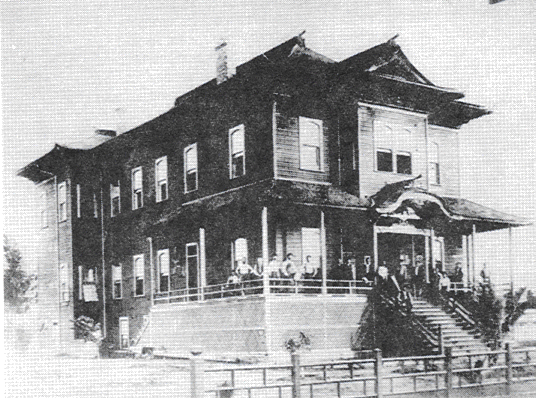
Abb.: Shin-buddhistischer Tempel, Fresno, Kalifornien, 1902
[Bildquelle: Spring wind : Buddhist cultural forum. --
ISSN 0825-799X. -- Vol. 5, No. 4 (Winter 1985/86). -- S. 43]
1902
Eröffnung des ersten Nichiren-Shu-Tempels in Hawaii.
1902-10-21
Dr.
William Sturgis Bigelow (1850-1926) in einem Brief an Naobayashi
Kanryo Ajari, Homoyin Temple, Otsu, Japan:
|
"If all religions have the same goal, why is it better
to study one rather than another? If a man takes the kai of more
than one religion, what happens! Suppose I received the sacraments
of the Romakyo [Catholicism], would it interfere with my Buppo [Buddhism]?"
[Zitiert in: Tweed, Thomas A.: The American encounter with Buddhism, 1844-1912 :
Victorian culture & the limits of dissent -- Chapel Hill, NC: University of
North Carolina Press, ©2000. -- 242 S. --
ISBN 0-8078-4906-5. -- [Originally published: Bloomington, Indiana University
Press, ©1992.]. -- S. 95.] |
1903
Paul Carus (1852-1919) finanziert eine Vortragsreise von Daisetz Teitaro Suzuki (鈴木大拙)
(1870-1966) zur Buddhist Mission in San Francisco.
Die Buddhist Mission hatte versucht,
Carus Paul: Sacred tunes for the consecration of life : hymns
for the religion of science. -- Chicago : Open Court, 1899
in der Liturgie zu verwenden, fand diese Lieder aber "zu philosophisch".
Dagegen hat
Carus, Paul: The gospel of Buddha according to old records.
-- Chicago
: The Open court publishing company, 1894. -- xiv, 275 p. 21 cm.
die Position der Bibel in der Liturgie der Buddhist Mission eingenommen.
Daraus wurde bei jeder liturgischen Feier vorgelesen.
1904
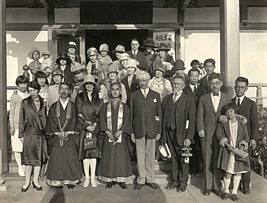
Abb.: Photo aus der Anfangszeit
[Bildquelle:
http://www.hhbt-la.org/CentennialHistory.html. -- Zugriff am 2005-04-29]
Rev. Junjyo Izumida von Higashi Hongwanji (Jodo Shinshu) gründet
die Los Angeles Buddhist Mission
Webpräsenz: http://www.hhbt-la.org/.
-- Zugriff am 2005-04-28
| "The origins of the Temple trace back to 1904 and the vision of
Reverend Junjyo Izumida, the founding priest from Japan. He saw Jodo Shinshu
Buddhism as open not only to Japanese immigrants, but also to all people in Los
Angeles, and his bilingual skills enabled him to follow through on his idea.
The Temple was eventually located on 4th Street in Little Tokyo
and named the Rafu Bukkyokai, originally translated as the Los Angeles Buddhist
Mission. It became a Higashi Honganji branch Temple in 1921.
In the roaring 20’s as the Japanese population grew in response
to the coming legal restrictions on Japanese immigration, Rev. Izumida drove
around LA in a Model-T conducting howakais, or Dharma gatherings, to bring the
teachings beyond the downtown Temple into the city’s neighborhoods, enlarging
the Sangha.
In 1911 the Temple moved to Boyle Heights and by 1930, with the
Japanese population numbering 35,000, the needs of young families grew, and
Higashi Honganji’s activities expanded to include Sunday School, day care and an
informal women’s association. With the Great Depression When Temple finances
were hard hit, the Temple leadership and the membership held together, with the
Issei continuing the Japanese tradition of supporting the Temple through
individual donations.
During World War II when the Issei and their families were
uprooted and sent to America’s concentration camps, the Temple played a
significant role in safe keeping members possessions while they were forced out
of their homes. Even from the camps members still contributed, sending what
funds they could to keep the Temple going. Many members went to Manzanar and
held services to maintain the Buddhist traditions.
Temple life flourished in the post-War years as Higashi Honganji
helped the community get back on its feet, serving as a hostel for members until
they found their own homes and starting new activities such as sewing and
cooking classes. The Junior YBA (Young Buddhist Association) grew; the Fujinkai,
or women’s association, was formalized; and the first carnival was held to raise
funds for improvements to the temple building. The Issei made plans to keep
Buddhism alive for future generations, and the Eitaikyo Fund was established
thereby endowing the Temple with a long-term, or perpetual, fund meant to last
forever.
As the Nisei grew into adulthood during a period of greater
acceptance of Japanese Americans into the mainstream, they were able to play a
critical role that furthered this goal. The kenchiku (temple building) project
was created to build not only a new structure but also a revitalized program of
activities to invigorate the Temple and meet the challenges of the time. Their
vision led to the construction in 1976 of the architecturally inspired Temple
and garden at its present day location on 3rd Street and Central Avenue. The
Lumbini Child Development Center, named after
the garden in which Buddha was born, was included in the
building plans.
With the backdrop of the major social change movements in America
during the 60’s and 70’s, scholarly developments laid the groundwork that would
affect the future of Higashi Honganji. Major sutras and other historical texts
from the Jodo Shinshu tradition were translated into English for the first time.
Temple leaders planned retreats and lectures on the teachings of Shinran Shonin,
incorporating English for those in the Sangha who had grown up in America.
The last two decades of the 20th century at Higashi Honganji were
a time of adjustment to a rapidly changing society where Japanese Americans
found greater freedom and more choices. Buddhism in all its forms found broader
receptivity, particularly in Los Angeles.
Higashi Honganji remains true to its origins as an open Sangha
welcoming anyone who wishes to learn more about the Jodo Shinshu tradition of
Buddhism. It also continues to serve as an active community center where the
cultures of Japan and Japanese America commingle and thrive.
Looking to the next 100 years, the Sangha has much to anticipate
as the teachings become more widely shared through not only more numerous
publications but also the possibilities for learning through the Internet and
other electronic forms of communication. The Dharma is characterized by
adaptability to different cultures and times, as Buddhist history demonstrates,
inviting all to Walk the Path of the Nembutsu. "[Quelle:
http://www.hhbt-la.org/CentennialHistory.html. -- Zugriff am
2005-04-29] |
"History
The Los Angeles Higashi Honganji Buddhist Temple has served the Buddhist
community since the turn of the 20th Century. In 1904, Rev. Junjyo Izumida
established the first Japanese Buddhist temple in Los Angeles, located at 229
1/2 East Fourth Street. The temple was relocated several times, to San Julian
Street in Little Tokyo (1907), to Savannah Street (1911), and in 1926, the
temple was moved to 118 North Mott Street in the Boyle Heights area of East Los
Angeles, where it remained for the next fifty years. The present temple built in
1976 marked the return of the Higashi Honganji to its roots in Little Tokyo.
Community Service
Though the primary function of the temple has been to fulfill the religious
needs of the community, the temple has also served as a center for a variety of
other activities as well. It was, for instance, the home of the first judo-kendo
dojo in Los Angeles, in addition to having served as an orphanage, a Japanese
language school, and as a facility for a variety of cultural classes. Today, the
Higashi Honganji houses the Lumbini Child Development Center, a fully accredited
pre-school and kindergarten with a full capacity 75 children in its care.
Architecture
Built in 1976, the temple’s architecture includes a traditional roof with over
30,000 tiles imported from Japan, lanterns which adorn the ceiling of the main
chapel, and a magnificent statue of Amida Buddha on the altar. The temple
reveals itself as a magnificent repository of Buddhist art and architecture.
Then beautiful Japanese garden was landscaped and continues to be maintained by
temple members.
Temple Organizations
The Dharma School is for children
from pre-school age through the 5th grade. The children learn about their
religion and culture through stories, discussions, skits, arts-and-crafts
projects, and special trips throughout the year. Many of the students are also
active members of Lumbini Children’s Choir.
The Sangha Teens is a
group for Junior High School youth, expanding upon the foundations learned in
Dharma School. In addition, they also interact with similar groups from other
temples in the area.
The Junior YBA (Young Buddhist
Association) is composed primarily of High School students. In addition to
religious, social and service activities within the temple, the group also
participates in regular activities of the Southern District, a league of over
ten temples in the Southern California region.
The Senior YBA is college and
young adult extension of Jr. YBA. Their focus is more educational, being
involved in monthly gatherings and various seminars. Members also participate in
events sponsored by the Western Young Buddhist League, a federation of chapters
spread throughout the West Coast.
The YABA (Young Adult Buddhist Association) is an organization for over-30 group. They
not only gather to deepen their understanding of the teachings, but also focus
on giving service to the temple.
The ABA (Adult Buddhist Association) is a core group of the temple. They sponsor monthly
religious gatherings and meetings to discuss how they may serve the temple.
The
Fujinkai (Women’s Group) provides for the needs of the Temple Sangha. Traditionally, this
has been accomplished through providing refreshments and lunches after services,
visiting retirement homes, and so forth. In addition, they are active
participants in retreats and other educational programs.
The
Los Angeles Otani Gakuen,
the temple’s choral group, practices weekly. Approximately 25 men and women
comprise the organization, performing regularly at various events throughout the
year. The group is one of the few Buddhist Temple choirs in the United States,
singing in both English and Japanese.Newsletters
The Way is our temple newsletter which is distributed monthly. The first
issue was published in 1947, soon after the end of World War II. It has served
as an important vehicle in the introduction of Shin Buddhism through ministers’
monthly messages. It also serves as the main source of information regarding
upcoming activities of the temple.
Our Altar
Amida Buddha (A) - The Buddha enshrined as the central figure in our altar
is Amida Buddha, who symbolizes the wisdom and compassion inherent in the
enlightenment of the Sakyamuni Buddha.
Shinran Shonin (B) Rennyo Shonin (C) - The image of Shinran Shonin
(1173-1262), the founder of the Jodo Shinshu tradition, hangs to the right of
Amida Buddha. To the left is the image of Rennyo Shonin (1415-1499), the 8th
Abbot of the Honganji Temple, remembered for his invaluable contributions in the
history of our tradition.
On the far right, there hangs a scroll with the characters, Namu Amida Butsu, (I
Take Refuge in Amida Buddha), the phrase members are encouraged to recite that
serves as a spiritual mirror for our awakening.
To the right of the scroll is a statue of a bodhisattva, one who has entered the
path of Buddhism and is diligently pursuing the goal of enlightenment.
In the area to the far left hang two scrolls. One depicts an image of Prince
Shotoku (574-621), recognized to be the father of Japanese Buddhism. The scroll
beside it depicts the Seven Patriarchs of our Honganji tradition, the seven
masters in history that our founder, Shinran Shonin considered to be essential
in his understanding of the Buddhadharma. They are Nagarjuna (c. 150-250) and
Vasubandhu (c. 320-400) of India, T’an Luan (476-542), Tao-ch’o (562-645), and
Shan-tao (613-681) of China, Genshin (942-1017) and Honen (1133-1212) of Japan.
Incense (D) - There are several urns in the altar used to burn incense.
Incense diffuses a sweet fragrance, transcending its shape and color. The
burning of incense symbolizes the transcending of selfishness or ego to become
one with others. It represents a symbolic cleansing of mind and body to prepare
oneself to receive the Dharma.
Flowers (E) - Flowers adorn the altar. They are appreciated not only for
their beauty, but as a symbol of impermanence... they are beautiful in the
morning, but fade in the heat of the day. They remind us of the continuous
change within and around us.
Candlelight (F) - The lights burning in the altar symbolize wisdom, the
light through which we understand truth. For Buddhists, wisdom is realized only
through experience. Other lamps that adorn the altar also symbolize the
illumination that the Dharma brings to our lives.
Obuppan (G) - In addition to the flowers, there is also an offering of
food in the altar. Rice, being the staple of the Japanese diet, is the
traditional offering called obuppan. On other occasions, fruit and other foods
may supplement the obuppan. This custom symbolizes our appreciation for the food
we receive, and serves as a reminder that we should share what we have with
others.
Services
We invite you to join us at our weekly services, conducted in
both English and Japanese, for all ages, providing an opportunity to further an
understanding of Jodo-Shinshu Buddhism. Services are held every Sunday from
10:00 AM (except for a one-month break in August). Please refer to the calendar section or call/e-mail
for more detailed information."
[Quelle:
http://www.hhbt-la.org/AboutUs.html. -- Zugriff am 2005-04-29]
|
1905-09-05
Unter Vermittlung von US-Präsident Theodore Roosevelt unterzeichnen die
Vertreter Japans und Russland in Portsmouth den Friedensvertrag zum
japanisch-russichen Krieg. Der Vertrag anerkennt die Korea und Sachalin als
japanisches Protektorat. Damit hat der japanische Imperialismus einen
entscheidenden Sieg gewonnen.
1905
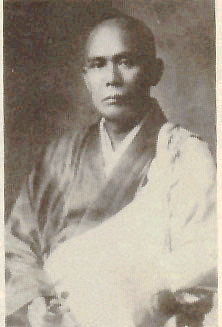
Abb.: Soyen Shaku [Bildquelle:
http://www.thuvienhoasen.org/pgtg-208-nhasuchau%20a.htm. -- Zugriff am
2003-05-08]
Zenmeister Soyen Shaku (1859-1919), der schon am Weltparlament der
Religionen teilgenommen hat, kommt wieder in die USA und unterrichtet in der
Nähe von San Francisco Alexandra Russel.
Er äußert sich sehr befriedigt über den japanisch-russischen Krieg:
| "Fortunately, Japan had just won the war, and that made people
everywhere sit up and take note of her. In fact, the whole world was
surprised that Japan had defeated Russia. It was impossible to explain
Japan's string of military victories in terms of military equipment and
logistics. . . . [It] was due to the samurai spirit, the Spirit of Japan,
nurtured by the country over the past two thousand years." [Zitat in: Victoria,
Brian (Daizen) A. <1939 - >: Zen at war / Brian (Daizen) A. Victoria.
-- New York : Weatherhill, 1997. -- 227 S. -- S. 59. -- Dort
Quellenangabe] |
Bei einem Zusammentreffen mit US-Präsident Theodore Roosevelt sagt Soyen
Shaku, dass der buddhistische Beitrag zum Geist Japans sich auf die Idee der
Aufopferung des Selbst konzentriere:
"To sacrifice the self, seen from the inside, is centered around the
abandoning of what Buddhism calls the small self, so as to serve the
greater cause___I believe that the readiness for self-sacrifice is
found in the peoples of all other countries, but never is it so clearly
manifest as in the Japanese. This spirit is one of the factors
contributing to the Japanese victory in the Russo-Japanese War. There are
many other factors, but among the more intangible ones is this readiness
to give up one's life."[Zitat in: Victoria, Brian (Daizen) A. <1939 -
>: Zen at war / Brian (Daizen) A. Victoria. -- New York : Weatherhill,
1997. -- 227 S. -- S. 59f. -- Dort Quellenangabe] |
| "Soyen Shaku (1859 – 1919; sometimes written as Soen
Shaku or Kogaku So’en Shaku) was the first Zen
Buddhist master to teach in the
United States. He was a Roshi of the Rinzai school and was abbot of both
Kencho-ji and
Engaku-ji temples in Kamakura, Japan. Shaku was a disciple of
Imakita Kosen. Soyen Shaku was an exceptional Zen monk. In his youth, his
master, Kosen, and others had recognized him to be naturally
advantaged. Three years after he had received “Dharma transmission”
from Kosen at age 25, Soyen took the unique step of traveling to
Ceylon to study Pali and Theravada Buddhism and live the alien life
of the bhikkhu for three years.
In 1893 Shaku was invited by
John Henry Barrows to attend the
World Parliament of Religions in Chicago. Along with
Anagarika Dharmapala and others, Shaku was considered authoritative to speak to
the West on behalf of the world's Buddhist community. He addressed
the conference that September with a series of talks, notably about karma,
nonviolence, an end to war and tolerance of other religions.
At this conference he met Dr. Paul
Carus, a publisher from Open Court Press in La Salle, Connecticut. Before Shaku
returned to Japan, Carus asked him to send an English-speaker
knowledgeable about Zen Buddhism to the United States. Shaku, upon
returning to Japan asked his student and
Tokyo University scholar
D. T. Suzuki to go to the United States, where he would eventually become the
leading academic on Zen Buddhism in the West.
Despite his anti-war statements, Soyen served as a chaplain to
the Japanese army during the
Russo-Japanese War, which he believed to be a just cause. In 1904, the Russian
author and pacifist Leo
Tolstoy wrote Shaku in the hopes that he would join him in denouncing the war.
Shaku refused, concluding that "... as a means of bringing into
harmony those things which are incompatible, killing and war are
necessary." (quoted in Victoria, 1997) After the war, Shaku would
attribute Japan's victory to its samurai culture, which he traced
back to the nation's amalgamation of Buddhism,
Confucianism, and Shinto.
In 1905, Soyen Shaku returned to America to help establish Zen in
the West, staying for roughly one year in San
Francisco and Seattle. Shortly after arriving, he was joined by his student
Nyogen Senzaki. Ultimately, Senzaki would became a permanent resident and Zen
teacher in Los
Angeles.
Soyen Shaku died 29 October 1919 in Kamakura."
[Quelle:
http://en.wikipedia.org/wiki/Soyen_Shaku. -- Zugriff am
2005-04-27 |
Die von Soyen Shaku ausgehende Traditionslinie:
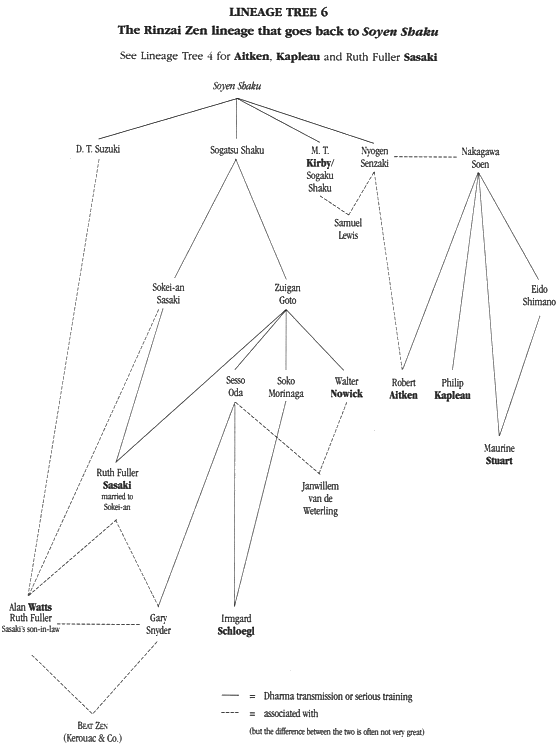
[Quelle der Abb.: Rawlinson, Andrew <1943 - >: The
book of enlightened masters : western teachers in eastern traditions. --
Chicago : Open Court, ©1997. --
xix, 650 S. : Ill. ; 25 cm.. -- ISBN: 0812693108. -- S. 534]
Mit Soyen Shaku kommt Nyogen Senzaki (1876 - 1958)
(siehe unten!).
1906
IIn den USA leben 3.150 japanische Buddhisten. Es gibt neun Gruppen des Reines-Land-Buddhismus (Jodo Shinshu) in Kalifornien, Oregon und
Washington. 14 Pure-Land-Geistliche leben in den USA, aber nur ein
chinesischer Geistlicher.
1906
Es erscheint das erste Buch in englischer Sprache über Zen:
Shaku, Soyen [Shaku Soên] <1859-1919>: Sermons of a Buddhist abbot;
addresses on religious subjects / by the Rt. Rev. Soyen Shaku, lord abbot of
Engaku-ji and Kencho-ji, Kamakura, Japan, including the sutra of forty-two
chapters; translated from the Japanese ms. by Daisetz Teitaro Suzuki. With
portrait of the author. -- Chicago, The Open Court Publishing Company; [etc.,
etc.], 1906. -- 220 S.
Siehe: Payer, Alois <1944 - >: Materialien zum
Neobuddhismus. -- 4. USA und Hawaii. -- 1. Anfänge des
Buddhismus in den USA. -- URL:
http://www.payer.de/neobuddhismus/neobud0401.htm
| "The first book to appear in English on the subject of Zen was
published in 1906 under the title Sermons of a Buddhist Abbot by Shaku
Soen (1859-1919). Soen Roshi came to play a pivotal role in the export of
Zen to the West, not only through his own efforts—his participation at the
1893 World Parliament of Religions, his subsequent lecture tour of America
and Europe, and the English publication of his lectures—but also through
the efforts of some of his students, notably D. T. Suzuki (1870-1966) and
Nyogen Senzaki (1876-1958). Given Soen's role in the trasmission of Zen to
the West, it is important to note that Soen was far from a typical Zen
master or roshi: he was a university-educated intellectual who traveled
extensively through much of America, Europe, and Asia. Moreover, Soen was
an avowed religious reformer who devoted much of his mature career to
training Buddhist laymen rather than Zen priests. Soen's modernist
outlook reflects in part the influence of his own teacher, Kosen Soon (better
known as Imagita (or Imakita] Kosen, 1816—92), the highly respected if
somewhat unorthodox Rinzai leader who served as chief abbot (kancho) of
Engakuji from 1875 until his death in 1892, Kosen Roshi was himself a
widely educated man of letters interested in Chinese and Western
philosophy, who served the Meiji government in a number of different
capacities including that of "national evangelist" (kyodoshoku) under the
Ministry of Doctrine in the 187()s Kosen was very much part of the early
Meiji Buddhist reform movement briefly discussed above, and as such he was
an enthusiastic advocate of "nonsectarian," "universal," and "socially
engaged" Buddhism. Kosen actively encouraged lay participation in Buddhist
practice, opening the newly constructed Zen hall at Engakuji to lay
students wishing to practice Zen meditation.
Soen had been ordained as a novice at the age of twelve, and had
already studied Zen at Myoshinji in Kyoto and Sogcnji in Okayama before he
came to train in Kamakura. In Kamakura Soen finished his formal training
under Kosen at Engakuji, and received inka-shomei (certification of the
seal [of dharma transmission]) at the remarkably young age of twenty-four.
He then took the unusual step of entering the prestigious Keio University
in Tokyo, a university established in 1866 primarily for the study of
Western culture." Upon graduation in 1885, while still in his twenties,
Soen traveled to India and Ceylon to pursue his study of Buddhist
languages. He returned to Japan after two years of Pali studies in Ceylon
(1887-89), and was installed as chief abbot of Engakuji following his
master's death in 1892. As abbot, Soen continued his teacher's practice of
welcoming lay Zen practitioners into the monastery confines. Soen also
revived a zazen society in Tokyo established by Kosen exclusively for the
training of lay men and women. D. T. Suzuki reports that "the number of
people, monks and laymen alike, who came for sanzen [private instruction]
with Soen Roshi during that time was amaz-ing."In 1893 Soen became the
first Zen master to travel to America, where he made a favorable and
lasting impression as the representative of the Zen school at the Chicago
World Parliament of Religions. The English translation of Soen's address
to the World Parliament had been prepared by the then unknown D. T. Suzuki
(with the help of the writer Natsume Soseki), and following the World
Parliament Soen arranged for Suzuki to travel to America to study with
Paul Carus (1852—1919, see below). In retrospect, Suzuki may well have
been Soen's greatest contribution to the spread of Zen in the West.
Soen also made tours of the Japanese colonial territories on the Asian
continent, traveling first to Manchuria during the early months of the
Russo-Japanese war as a chaplain to the army. Following the Japanese
victory he embarked on a circumambulation of the globe, lecturing on
Buddhism and Zen in America, England, Erance, Germany, Italy, Ceylon, and
India. Upon returning to Japan in 1906, Soen refused to take up an abbot's
post for many years, choosing instead to devote his full energies to
teaching Zen to laymen. Consequently, he spent several years traveling
throughout Japan giving lectures and instruction in Zen practice. In 1912
Soen traveled once again to Manchuria and Korea at the invitation of the
Southern Manchurian Railways Company, where he lectured on Zen and
Japanese culture to members of the Japanese colonial administration.
Soen's approach to Buddhism was typical of the new breed of
cosmopolitan and intellectual religious leaders emerging in the Meiji
period. His address to the World Parliament in 1893 was ecumenical in
spirit, portraying Buddhism as a "universal religion" in harmony with
other world faiths, as well as with science and philosophy. But the
collection of sermons delivered during his second trip to America betrays
Soen's sympathy for the nationalistic and xenophobic sentiments
characteristic of the time. Indeed, the title of his 1912 series of
lectures delivered in Korea and Manchuria—"The Spirit of the Yamato Race"—speaks
for itself. Nor were his nationalist leanings kept secret from his Western
admirers—the collection of essays published in Sermons of a Buddhist Abbot
concludes with three short pieces that, while deploring the grisly horrors
of war, defend the honor and justice of Japanese military aggression in
Manchuria:
«War is not necessarily horrible,
provided that it is fought for a just and honorable cause, that it is
fought for the maintenance and realization of noble ideals, that it is
fought for the upholding of humanity and civilization. Many material
human bodies may be destroyed, many humane hearts be broken, but from a
broader point of view these sacrifices are so many phoenixes consumed in
the sacred fire of spirituality, which will arise from the smoldering
ashes reanimated, ennobled, and glorified.»
In addition to Soen's concern to justify Japanese military aggression,
his Western lectures on Buddhism also reveal an interest in a
quintessential nihonjinron theme, the difference between "Oriental" and "Occidental"
mentalities. Westerners, we are told, are noisy, restless, boastful of
their possessions, wasteful of their energies, and generally unstated to
the mystical teachings of the East. Orientals, on the other hand, are
raised with a "strong emphasis placed upon the necessity of preserving the
latent nervous energy and of keeping the source of spiritual strength well
fed and nourished." The Oriental's ideal "is to be incomprehensible,
immeasurable, and undemonstrative even as an absolute being itself," and
thus, claims Soen, the Oriental is naturally drawn to meditation. Soen's
musings on the Japanese ethnos are of a type with those of other early
nihonjinron theorists, including Okakura Kakuzo (1862-1913), Watsuji
Tetsuro (1889-1960), Kuki Shuzo (1888-1941), D. T. Suzuki, and Tanabe
Hajime (1885-1962). All these men were moved to extemporize on the gap
between the Oriental and the Occidental during or following their sojourns
in the West. "
[Sharf, Robert H.: The Zen of Japanese nationalism. -- In:
Curators of the Buddha : the study of Buddhism under colonialism /
edited by Donald S. Lopez, Jr. -- Chicago, Ill. : University of Chicago
Press, ©1995. -- 298 S. -- ISBN
0-226-49309-1. -- S. 112-114.] |
nach 1906
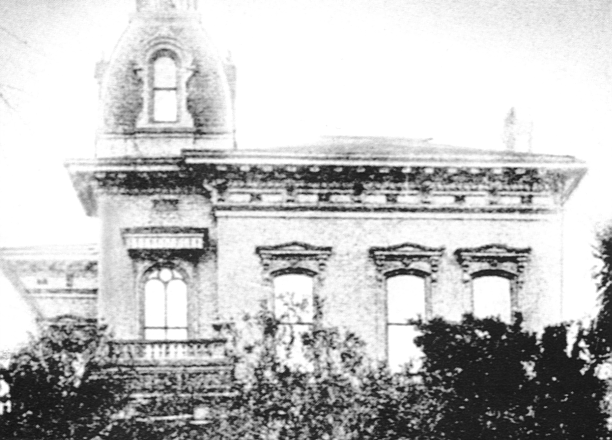
Abb.: Buddhist Church of San Francisco, 1617 Gough Street, nach dem Erdbeben
1906
[Bildquelle: Tricycle : the Buddhist review. -- ISSN 1055-484X. --
Vol. XI, No. 1 (Fall 2001). -- S. 82.]
1907
Suzuki, Daisetz Teitaro <1870-1966>: Outlines of Mahâyâna Buddhism,
-- London : Luzac and Company, Publishers to the University of Chicago, 1907.
-- 420 S. -- [Appendix: Hymns of Mahâyâna faith.]
| "Thus Suzuki's first major book in English, Outlines of Mahâyâna
Buddhism, published in 1907 as he was about to leave La Salle, makes no
mention of Zen whatsoever, and places no particular emphasis on experience
per se. (This absence of any discussion of religious experience is notable
not only because the experience of satori would become the hallmark
of Suzuki's later Buddhist exegesis, but also because Suzuki, according to
his later recollections, had had a satori experience during his
last rôhatsu sesshin at Engakuji shortly before he left for
America.)
What we find instead is a rambling and highly idealized introduction to
Mahâyâna doctrine—a curious blend of scholarship and apologetics—that
effectively renders Mahâyâna fully commensurate with Carus's Religion of
Science.
Like other exponents of Japanese New Buddhism, Suzuki insists that
Buddhism is not a dogmatic creed but rather a mysticism that responds to
the deepest yearnings in man and yet remains in full accord with the
findings of modern science:
"It is wonderful that Buddhism clearly anticipated the outcome of
modern psychological researches at the time when all other religious and
philosophical systems were eagerly cherishing dogmatic superstitions
concerning the nature of the ego" (p. 40).
Not only is there no fundamental discord between Buddhism and science,
but there is no ultimate conflict between the teachings of Christ and
those of the Buddha:
"My conviction is: If the Buddha and the Christ changed their
accidental places of birth, Gautama might have been a Christ rising
against the Jewish traditionalism, and Jesus a Buddha, perhaps
propounding the doctrine of non-ego and nirvana and Dharmakâya" (p. 29);
and
"Those who are free from sectarian biases will admit without
hesitation that there is but one true religion which may assume various
forms according to circumstances" (p. 365, n. 1).
This profession of faith in the unity of religious truth, written at
the end of Suzuki's long apprenticeship with Cams, could have come from
the pen of Carus himself."
[Sharf, Robert H.: The Zen of Japanese nationalism. -- In:
Curators of the Buddha : the study of Buddhism under colonialism /
edited by Donald S. Lopez, Jr. -- Chicago, Ill. : University of Chicago
Press, ©1995. -- 298 S. -- ISBN
0-226-49309-1. -- S. 122f.] |
1907-08
"Gentleman' Agreement" zwischen den USA und Japan schränkt die Einwanderung
japanischer Arbeiter ein.
1909
Daisetz Teitaro Suzuki
(1870-1966)
kehrt nach Japan zurück
1910-08-22
Nach dem Einmarsch in Korea gliedert Japan Korea dem
japanischen Reich ein. Es beginnt eine japanische Schreckensherrschaft in
Korea. Japanische Buddhisten beginnen gegen den koreanischen Buddhismus durch
japanische Tempelgründungen zu wirken.
1910-09-15
Schlagzeile des San Francisco Examiner: BUDDHA SHRINE WORSHIPPED
IN HOUSE OF MYSTERY
bezieht sich auf Ida E. Russell
1913
Nukariya, Kaiten [忽滑谷快天 ] <1867 - 1934>: The religion of the Samurai; a study of Zen
philosophy and discipline in China and Japan. -- London : Luzac, 1913. -- 253
S. -- Online:
http://www.gutenberg.org/etext/5173. -- Zugriff am 2005-04-27. -- ["Kaiten Nukariya, Professor of Kei-O-Gi-Jiku
University and of So-To-Shu Buddhist College, Tokyo" ]
| "The second English book to appear on Zen was entitled Religion of the
Samurai: A Study of Zen Philosophy and Discipline in China and Japan,
authored by Nukariya Kaiten (1867-1934), a Soto priest, university
professor, and personal friend of D. T. Suzuki. Nukariya wrote
Religion of the Samurai, which appeared in 1913, while living and
lecturing at Harvard University. Here we learn that only in Japan is
Buddhism still alive; that Zen is an ancient, if not the most ancient,
form of Buddhism (pp. xviii-xix); that "pure Zen" can be found only in
Japan (p. 1); that the ideas of Zen are "in harmony with those of the New
Buddhists" (p. xix, n. 2); and that Zen is an ideal doctrine for a newly
emergent martial Japan: "It is Zen that modern Japan, especially after the
Russo-Japanese War, has acknowledged as an ideal doctrine for her rising
generation" (p. xxii). Nukariya further argues that the spirit and ethic
of Zen is essentially identical with that of the samurai (pp. 35-40), and
he waxes poetic on the great generals of old Japan, whose "loyalty, wisdom,
bravery, and prudence are not merely unique in the history of Japan, but
perhaps in the history of man" (p. 43).
«After the Restoration of the
Mei-ji the popularity of Zen began to wane, and for some thirty years
remained in inactivity; but since the Russo-Japanese War its revival has
taken place. And now it is looked upon as an ideal faith, both for a
nation full of hope and energy, and for a person who has to fight his
own way in the strife of life. Bushido, or the code of chivalry, should
be observed not only by the soldier in the battle-field, but by every
citizen in the struggle for existence. If a person be a person and not a
beast, then he must be a Samurai—brave, generous, upright, faithful, and
manly, full of self-respect and self-confidence, and at the same time
full of the spirit of self-sacrifice. We can find an incarnation of
Bushido in the late General Nogi, the hero of Port Arthur, who, after
the sacrifice of his two sons for the country in the Russo-Japanese War,
gave up his own and his wife's life for the sake of the deceased Emperor.
He died not in vain, as some might think, because his simplicity,
uprightness, loyalty, bravery, self-control, and self-sacrifice, all
combined in his last act, surely inspire the rising generation with the
spirit of the Samurai to give birth to hundreds of Nogis.
»(Pp. 50-51)
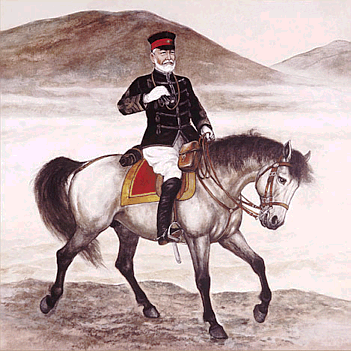
Abb.: Nogi Maresuke [Bildquelle:
http://horse.shrine.net/samurai/image/nogi.jpg. -- Zugriff am
2003-06-23]
This eloquent eulogy to General Nogi, in an introductory book on Zen
published in 1913, is telling indeed. Less than a year had passed since
Nogi Maresuke (1849-1912), Japanese war hero and mentor to the future
Showa Emperor, shocked the nation by committing seppuku with his wife
during the funeral ceremonies for Emperor Meiji. Despite some praise in
the foreign press for this spectacular display of bushido spirit, news of
Nogi's suicide was met with considerable confusion and distress by
intellectuals in Japan, who felt that the practice of junshi (following
one's lord into death) was outmoded, unduly theatrical, and an
embarrassment to a nation seeking international recognition as a modern
world power.
Yet Nukariya, for one, does not hesitate to laud Nogi's suicide. This
should not surprise us. Nogi himself was known to have taken an interest
in Zen practice, receiving instruction and koan training from the
celebrated master Nantenbo (1839-1925). In his personal remembrances,
Nantenbo Roshi, himself a staunch nationalist and partisan to the Japanese
military, recalls instructing Nogi on the meaning of Zen.
The essence of Zen, explained Nantcnbo, lies in the single word jiki (direct),
which has three distinct but interrelated meanings:
- going forward without hesitation,
- direct mind-to-mind transmission, and
- "the spirit of Japan" (yamatoda-mashii).
It clearly served the interests of late Meiji Zen apologists to
identify the "essence of Zen" with both the "spirit of bushido" and the "spirit
of Japan," notions then replete with connotations of imperial conquest and
unconditional obedience to the emperor."
[Sharf, Robert H.: The Zen of Japanese nationalism. -- In:
Curators of the Buddha : the study of Buddhism under colonialism /
edited by Donald S. Lopez, Jr. -- Chicago, Ill. : University of Chicago
Press, ©1995. -- 298 S. -- ISBN
0-226-49309-1. -- S. 114 - 116] |
"Die westliche Umdeutung des Zen hat eine lange Vorgeschichte in Japan
selbst. Sie macht sich bereits bei der ersten Darstellung des Zen in
englischer Sprache bemerkbar, in dem Werk von Kahm Nukariya, Professor
der Kei-ô-gi-jiku Universität und des Sô-tô-shû Buddhist College in
Tokio, das unter dem Titel: The religion of the Samurai, A study of Zen
Philosophy and Discipline in China and Japan, London, Luzac & Co. 1913
erschienen ist (in Luzac's Oriental Religions Series vol. IV). Dieses
Werk gibt zwar eine vorzügliche Übersicht über die geschichtliche
Entwicklung von Zen in China und Japan, zeigt aber doch in der
Darstellung des Wesens von Zen den sicher gut gemeinten, aber zum Teil
sehr krampfhaften Versuch, Zen in die Kategorien der zeitgenössischen
europäischen Philosophie zu übersetzen. Der Verfasser kokettiert mit dem
»Liberalismus« von Zen und der Ablehnung jeglicher autoritativen
Bedeutung einer heiligen Schrift, mit kräftigen Seitenhieben auf die
»christliche Intoleranz« im Stile des westlichen Freidenkertums. »Zen
ist völlig frei von den Fesseln veralteter Dogmen, toter
Glaubensbekenntnisse und Schablonen einer erstarrten Vergangenheit, die
die Entwicklung eines religiösen Glaubens hindern und sich der
Entdeckung einer neuen Wahrheit in den Weg stellen. Zen hat keine
Inquisitionsbehörde nötig. Es hat niemals einen Galilei oder einen
Descartes zu einem Widerruf gezwungen und wird es auch in Zukunft nicht
tun. Für Zen ist die Exkommunikation eines Spinoza ebenso unmöglich wie
die Verbrennung eines Bruno.«
Dementsprechend wird auch der ikonoklastische Charakter von Zen und
seine antidogmatische Haltung auch gegenüber der buddhistischen
Lehrüberlieferung in einer einseitigen Weise hervorgehoben. »Buddha ist
nichts als eine geistliche Kette oder eine moralische Fessel.. . Wenn Du
auch nur an einen Namen Buddhas dächtest, so würde dich dies der
Reinheit des Herzens berauben. Mag die konventionelle oder orthodoxe
Buddha-Idee oder Gottesidee auch glatt und hübsch erscheinen wie eine
goldene Kette, die generationenlang durch religiöse Goldschmiede poliert
und gehämmert wurde, so besitzt sie doch zu viel Starrheit und Kälte,
als dass wir sie tragen wollten.«
Zur Verdeutlichung der Zen-Anschauung von der Einheit des Lebens im
Universum müssen ihm Haeckel und Darwin als Hauptzeugen dienen. Die
naturwissenschaftliche Entwicklungstheorie wird unbedenklich von der
Physik auf die Botanik und Zoologie und von dort auf die Geschichte
übertragen. Die »schöpferische Kraft in Natur und Menschheit« wirkt den
Keim der organischen Natur und entwickelt, »von Stufe zu Stufe auf der
Leiter der Evolution aufsteigend, die Sinnesorgane und das Nervensystem«
und bringt schließlich Sprachen und Wissenschaften und »zu ihrer
abschließenden Bereicherung« Moralität und Religion hervor. Ebenso wird
der technische und der soziale Fortschritt in einer kühnen Zusammenschau
zur Erhellung der optimistischen Lebensauffassung von Zen in Anspruch
genommen«. Auf der einen Seite bekunden sich die Zeichen des sittlichen
Fortschritts in jeder Richtung in Form von Waisenhäusern, Armenhäusern,
Erziehungshäusern, Herbergen und Asylen für die Armen, kostenlosen
Hospitälern, Asylen für Haustiere, Tierschutzvereinen, Blinden- und
Taubstummenschulen, Irrenhäusern usw., auf der anderen Seite wurden die
verschiedenartigsten Entdeckungen und Erfindungen gemacht, die zu dem
sozialen Fortschritt beitragen, wie z. B. die Entdeckung der X-Strahlen
und des Radiums, die Erfindung der drahtlosen Telegraphie und der
Flugzeuge und anderer Maschinen. Weiter weisen uns spirituelle Wunder
wie Clairvoyance, Clairaudience, Telepathie usw. auf die Möglichkeiten
einer weiteren Entfaltung des Geistes, an die wir bisher nicht einmal im
Traume zu denken wagten. So wird das Leben Schritt für Schritt reicher
und edler und wird immer hoffnungsvoller, je mehr wir auf dem Weg des
Buddha fortschreiten.«
Die traditionelle buddhistische Endzeiterwartung wird in einen
Fortschrittsglauben umgedeutet, der um so eindrucksvoller ist, als die
buddhistische Heilszeit eine Periode von mehr als fünfeinhalb Milliarden
Jahren umfasst. »Die Welt ist auf dem Fundament der Moralität aufgebaut
und das ist nur ein anderer Name für den Universalgeist, und das
Sittengesetz hält sie aufrecht. Wir menschlichen Wesen waren, sind und
werden bewusst oder unbewusst am Werke sein, die Welt zur Vollkommenheit
zu führen. Diese Idee findet ihren allegorischen Ausdruck in dem
buddhistischen Sutra, der von der Ankunft eines gnadenvollen Buddha
Maitreya in ferner Zukunft berichtet. In dieser Zeit, heißt es, wird es
keine steilen Hügel, keine schmutzigen Plätze, keine Epidemien, keine
Hungersnot, keine Erdbeben, keine Stürme, keine Kriege, keine
Revolutionen, kein Blutvergießen, keine Grausamkeit und kein Leiden mehr
geben. Die Wege wer-
den glatt und eben sein, Bäume und Wiesen in ständiger Blüte, Vögel
singen unentwegt ihre Lieder und die Menschen sind zufrieden und
glücklich, alle lebenden Wesen werden den Buddha der Barmherzigkeit
verehren, seine Lehre annehmen und Erleuchtung erlangen. Diese Prophetie
will nach dem Bericht des Sutra 5 670 000 000 Jahre nach dem Tod von
Shakyamuni (dem historischen Buddha) sich erfüllen. Dies zeigt uns klar,
dass die Mahâyâna-Weltanschauung darauf abzielt, im Menschen das
eingeborene Licht der Buddhanatur zur Erleuchtung der Welt zu entfalten,
die universale Bruderschaft aller empfindenden Wesen zu verwirklichen,
Erleuchtung zu erlangen und den Frieden und die Freude zu genießen, zu
denen der Universale Geist uns hingeleitet.«
Der europäische Fortschrittsglaube ist hier durch seine japanische
Zen-Variante, die von diesem moralischen und geistigen Fortschritt der
Menschheit erwartet, dass er einige hundert Millionen Jährchen so
weitergeht, bei weitem übertroffen.[Quelle: Benz, Ernst <1907 -
1978>: Zen in westlicher Sicht : Zen-Buddhismus - Zen-Snobismus. --
Weilheim/Obb. : O. W. Barth, 1962. -- 107 S. ; 21 cm. -- (Zeichen
und Symbole). -- S. 18 -21.] |
1914 - 1918
Erster Weltkrieg. Japan ist mit Großbritannien, Frankreich und den USA
gegen Deutschland usw. verbündet.
1914
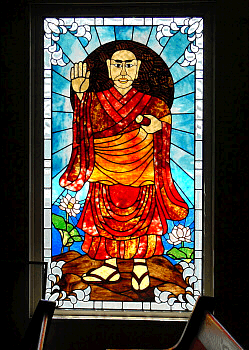
Abb.: Glasfenster
[Bildquelle:
http://la.nichirenshu.org/archive/laimgs/hnsg.htm. -- Zugriff am
2005-04-29]
Erster Nichiren Tempel in Los Angeles
Webpräsenz:
http://la.nichirenshu.org/index.html. -- Zugriff am 2005-04-29
|
"The History of Los Angeles
Nichiren Buddhist Temple
-- Minobusan Betsuin of North America
After the turn of the
century, local Nichiren Buddhists in the Los Angeles organized the White Lotus
Club to study the teachings of Nichiren Shonin. On May 23, 1914, the White Lotus
Club rented a room at the Federal Hotel on East Second Street. Under the
founding priest, REV. KANJO ASAHI, the White Lotus Club established the first
Nichiren Temple in North America, naming it the Nichiren Buddhist Temple of Los
Angeles.
During the
following year, under the guidance of REV. NISSHO KITAGAWA, second
chief priest, the temple diligently and vigorously labored to
promote the Buddhism of Nichiren Shonin through side walk preaching,
public lectures, study classes and the formation of what would later
become the largest Japanese women's organization of the era.
The propagation
of the doctrine was furthered by the publication of a periodical
called the "Ten Sei" during the years of succeeding ministers, REV.
GIJYO YAMASHITA and REV. CHOTOKU TOYAMA. Even today, there is a 94
year old member who was converted to the Nichiren faith after
listening to Rev. Toyama's street preaching,
In 1930, the
fifth resident minister REV. JUNKYO IKEDA, while enduring enormous
hardship during the depression years, moved to 2800 East Third
Street, Los Angeles, and built a one hundred capacity new temple. He
was appointed the first director of the Nichiren Buddhist Order of
North America in 1933.
In 1939 REV.
RYUSHIN OKIHARA, the sixth resident minister, traveled to the war
front to comfort the Japanese soldiers involved in the Manchurian
incident.
In 1940, Chief
Abbot of Kuonji Temple at Mt. Minobu, the Very Rev. Nikken
Mochizuki, honored the temple with the name of Minobu-san Betsuin
(Mt. Minobu Branch temple) of North America. However, the temple
soon afterwards encountered a very sad time in its history. With the
outbreak of World War II in 1941 and the forced relocation of
Japanese and Japanese-American West Coast residents to concentration
camps, the temple had to be closed for a period of four years. At
the end of the war, seventh chief priest, REV. JITEI ISHIHARA,
returned to re-open the temple and used it to help returning
evacuees from the camps as a temporary lodging.
In 1953, REV.
YOSHINORI FUJIWARA, became the eighth resident minister and in 1970
the temple was enlarged with the dedication of a new building at the
present location. The temple enjoyed a variety of activities and
groups, such as Japanese and English Buddhist study classes,
Japanese culture classes and sports teams. The temple later began to
experience a number of difficulties, resulting in a decrease in
membership and financial hardship. It became increasingly
complicated to maintain the temple and a minister, so the members
finally requested financial and other assistance from Ikegami
Honmonji Temple in Tokyo.
On May 31,
1992, REV. RYUSHIN KIDA was sent from Ikegami Honmonji Temple.
However, since his responsibilities laid primarily with Ikegami
Honmonji, he was not able to stay long in Los Angeles. During Rev.
Kida's absence, Rev. Gyoken Kuroyanagi was assigned to the temple
and with the support of Ikegami Honmonji, Rev. Kuroyanagi remodeled
the kitchen, office, and other places, and also constructed a guest
shower room and a two car garage.
On September 8,
1994, REV. SHOKAI KANAI was installed as the tenth chief priest of
the temple. Rev. Kanai had originally trained at this temple from
the Spring of 1964 until the Fall of 1970, before being transferred
to Salt Lake City, Seattle and then back to Japan. Upon his return
to the Los Angeles temple, he was therefore able to renew a number
of old acquaintances and cherished friendships. Since Rev. Kanai's
return to the temple, the congregation and its membership has
steadily increased, together with a renewed effort to propagate the
Lotus Sutra and Nichiren's Buddhism, in the spirit of the temple's
founding priest and members."
[Quelle:
http://la.nichirenshu.org/hello/historyla.htm. -- Zugriff am
2005-04-299
|
|
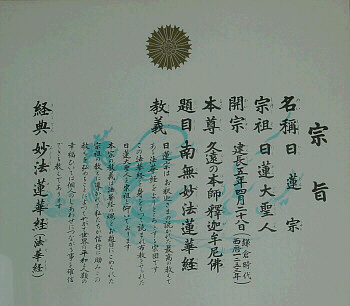
Abb.: Gelübde
"PLEDGE
We believe in Shakyamuni Buddha. He is Eternal. He lives
in the world. He is the Savior of the world.
We express our faith by chanting the Daimoku (Sacred
Title): Namu Myohorengekyo. Namu Myo Ho Ren Ge Kyo represents not only the title
of the Sutra (called Hokekyo, the Sutra of the Lotus Flower of the Wonderful
Law, the Lotus Sutra) in which Shakyamuni Buddha declares his eternity but also
the Law (teachings) expounded in the Sutra.
We believe that Nichiren (1222-1282)was the messenger of Shakyamuni Buddha.
He never gave up propagating the Daimoku after he founded
the Nichiren Shu on the twenty-eighth day of the fourth month of the fifth year
of Kencho (1253) although he was persecuted many times by arrogant people. The
persecutions were just as those prophesized in the Lotus Sutra.
We vow to the Buddha and Nichiren that we will make efforts to secure the
peace of the world as well as ours by disseminating the teachings expounded in
the Lotus Sutra.
--Nichiren Shu"
[Quelle:
http://la.nichirenshu.org/archive/laimgs/kangipledgeclose.htm.
-- Zugriff am 2005-04-29] |
1920er-Jahre
In manchen englischsprachigen Gottesdiensten von Hongwanji singt man "Onward
Buddhist Soldiers", eine Adaption des christlichen Kirchenlieds "Onward
Christian Soldiers"

Quelle der midi-datei:
http://www.cyberhymnal.org/htm/o/n/onwardcs.htm. -- Zugriff am
2005-06-25
Auch "Buddha Loves Me, This I Know"
nach dem Kirchenlied "Jesus Loves Me, This I Know"

Quelle der midi-Datei:
http://www.cyberhymnal.org/htm/j/e/jesuslme.htm. -- Zugriff am
2005-06-25
1920
M. T. Kirby, ein Brite, der in Kanada aufgewachsen ist,
wird Geistlicher an einem Pure Land Tempel in San Francisco. 1921 wird er
von Bishof Imamura in Hawaii mit dem Aufbau eines English Departement des
dortigen Hongwanji beauftragt.
| "An obscure figure who may have gone to Japan in 1913 and become
a Pure Land Buddhist and then moved to Engakuji, Soyen Shaku
's Rinzai Zen monastery in Kamakura, where, he said, he attained
satori and was given the name Sensei Sogaku Shaku. If this is
true, it would make Kirby the first Westerner to attain satori/kensho
and the first to be appointed as a teacher (which is what sensei
means). But it is impossible to verify his claims: our only source
is Samuel Lewis (Sufi Vision and Initiation, 66), who is himself
reporting what Kirby told him. Back in America, in 1920, Kirby
officiated at a Pure Land temple in San Francisco—the only Westerner
with any kind of formal Buddhist function anywhere in the West at
the time, as far as I know. Later went to Hawaii (where he was head
of the Pure Land's 'English Department') and then Sri Lanka. A
maverick Buddhist with no spiritual progeny." [Quelle:
Rawlinson, Andrew <1943 - >: The book of enlightened masters : western teachers
in eastern traditions. -- Chicago : Open Court, ©1997.
-- 650 s. : Ill. -- ISBN 0-8126-9310-8. -- S. 613] |
1921
Daisetz Teitaro Suzuki (1870-1966)
wird Professor an der Otani-Universität in Kyoto, die dem Jodo Shin affiliiert
ist.
Er gibt die Zeitschrift
The Eastern buddhist : an unsectarian journal devoted to an open
and critical study of Mahayana Buddhism in all of its aspects / publ. by The
Eastern Buddhist Society ; Otani University. -- Kyoto : Univ. 1.1921,Mai -
8.1949/58,4; N.S. 1.1965,Sept./1966 -- ISSN 0012-8708. -- [Webpräsenz:
http://www.otani.ac.jp/EBS/journal.html. -- Zugriff am 2003-06-26]
heraus.

Abb.: ®Logo The Eastern Buddhist Socieaty
Im selben Jahr gründet Suzuki The Eastern Buddhist Society
[Webpräsenz:
http://www.otani.ac.jp/EBS/ab_ebs.html. -- Zugriff am 2003-06-26]
1922
Im Fall Ozawa vs. U.S., entscheidet der U.S. Supreme Court, dass Japaner
nicht zu den "free white persons" gehören, die die US-Staatsnbürgerschaft
erwerben können.
|
"TAKAO OZAWA v. UNITED STATES.
No. 1.SUPREME COURT OF THE UNITED STATES
260 U.S. 178; 67 L. Ed. 199; 43 S. Ct.
65
Argued October 3, 4, 1922.
November 13, 1922 Decided
PRIOR HISTORY: CERTIFICATE FROM THE
CIRCUIT COURT OF APPEALS FOR THE NINTH CIRCUIT.
QUESTIONS certified by the court below,
arising upon an appeal to it from a judgment of the District Court of Hawaii
which dismissed a petition for naturalization. The case was argued with
Yamashita v. Hinkle, post, 199, and was decided at the same time.
SYLLABUS:
- Section 2169 of the
Revised Statutes, which is part of Title XXX dealing with naturalization, and
which declares: "The provisions of this Title shall apply to aliens, being free
white persons, and to aliens of African nativity and to persons of African
descent," is consistent with the Naturalization Act of June 29, 1906, and was
not impliedly repealed by it. P. 192.
- Revised Statutes, @ 2169, supra,
stands as a limitation upon the Naturalization Act, and not merely upon those
other provisions of Title XXX which remain unrepealed. P. 192.
- The intent of legislation is to be
ascertained primarily by giving words their natural significance; but if this
leads to an unreasonable result plainly at variance with the policy of the
legislation as a whole, the court must look to the reason of the enactment,
inquiring into its antecedents, and give it effect in accordance with its design
and purpose, sacrificing, if necessary, the literal meaning, in order that the
purpose may not fail. P. 194.
- The term "white person," as used in
Rev. Stats., @ 2169, and in all the earlier naturalization laws, beginning in
1790, applies to such persons as were known in this country as "white," in the
racial sense, when it was first adopted, and is confined to persons of the
Caucasian Race. P. 195.
- The effect of the conclusion that "white
person" means a Caucasian is merely to establish a zone on one side of which are
those clearly eligible, and on the other those clearly ineligible, to
citizenship; individual cases within this zone must be determined as they arise.
P. 198.
- A Japanese, born in Japan, being
clearly not a Caucasian, cannot be made a citizen of the United States under
Rev. Stats., @ 2169, and the Naturalization Act. P. 198."
[Quelle:
http://chnm.gmu.edu/eoc/resources/law/ozawa-v-us.htm. -- Zugriff
am 2005-04-27] |
1922
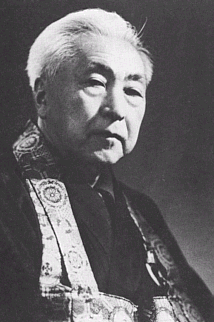
Abb.: Nyogen Senzaki [Bildquelle:
http://dervish-healing-order.com/Senzaki.htm. -- Zugriff am 2003-06-21]
Zenmeister Nyogen Senzaki (1876 - 1958), ein Schüler von Soyen Shaku,
hält in San Francisco seine erste Vorlesung.
"SENZAKI, Nyogen (1876, Siberia—May 7, 1958, Los Angeles,
California).
Nyogen Senzaki, teacher of Zen Buddhism and founder of the
Mentor-garten Meditation Hall in Los Angeles, was born in Siberia of
a Japanese mother and a father of either Russian or Chinese origin. As a
child, he was found next to his frozen mother by a Japanese monk and was
subsequently adopted by a shipwright named Senzaki, whose name he took.
The shipwright placed him under the care of a scholar trained in both
Soto Zen and Kegon Buddhism. The scholar gave the youthful Nyogen a good
education. In his teen years, Senzaki began a correspondence with Soyen
Shaku and in 1896 he presented himself at Shaku's Engakuji monastery at
Kamakura.
When he first moved to the monastery, Senzaki was found to have
tuberculosis and was forced to live in semiisolation for a year while he
recovered his health. Then, as a student, he roomed with D. T. Suzuki.
He studied at Engakuji for five years before leaving to found a nursery
school, which he called the Mentorgarten and modeled on the German
kindergartens.
In 1905 he left Japan for the United States. He cited at least three
reasons: he was unhappy with the state of Japanese Zen, which he saw as
in a period of decline; he was unhappy with the militancy of the
government then in the midst of the war with Russia; and he also wanted
to raise money for his Mentorgarten. Upon arriving in San Francisco, he
took a job as a houseboy at the home of the Alexander Russells
[Alexander Russell 1855 - 1919]. They
were at that time entertaining his teacher, Soyen Shaku, and beginning
to practice Zen. He stayed only a short time, until Soyen Shaku sent him
into San Francisco with the admonition, "Just face the great city and
see whether it conquers you or you conquer it."
For several years he worked at odd jobs. In 1910 he became a hotel
porter and worked himself up to manager. Eventually, in 1916, he was
able to purchase a hotel, but he was a poor businessman and the project
failed. He then became a cook.
During the seventeen years after leaving Shaku, he occasionally wrote an
article on Zen but taught very little and took no students. Then in
1922, with money saved from his job, he rented a hall and gave a lecture
on Zen. Out of this first gathering developed what came to be known as
the floating zendo. As money allowed, he would rent a hall, set
up his painting of Manjusri, the bodhisattva of wisdom, and lecture and
teach. On alternate evenings he would direct his attention to first
Japanese-Americans and then to non-Japanese Americans.
In 1928 he took the floating zendo to Los Angeles; for three
years he moved between San Francisco and Los Angeles. Finally in 1931 he
found a permanent location in Los Angeles and established the
Mentorgarten Meditation Hall. His efforts stabilized over the next
decade, but, like all Japanese-American institutions, the Mentorgarten
was disrupted by World War II. In 1942 Senzaki was interned and sent to
Heart Mountain, Wyoming. He took the floating zendo with him and
established it in a temple at the camp. He also sent monthly lessons to
his students in Los Angeles. In 1945 he was released; he returned to Los
Angeles to teach for the remaining years of his life.
When Senzaki died, his work disbanded, and he left no continuing
organization. Thus Senzaki's significance lies not in his zendo so much
as in:
- his having carried the banner of Rinzai Zen during the years
that the Oriental Exclusion Act prevented many Buddhist teachers
from coming to the United States;
- his bringing other Zen teachers, such as Nakagawa Soen,
to America; and
- his inspiring the organizations founded by his students, such as
Robert Aiken's Maui Zendo.
[Quelle: Melton, J. Gordon: Biographical dictionary of
American cult and sect leaders. -- New York : Garland Pub., 1986.
-- 354 S. ; 24 cm. -- ISBN 0824090373. -- s.v.] |
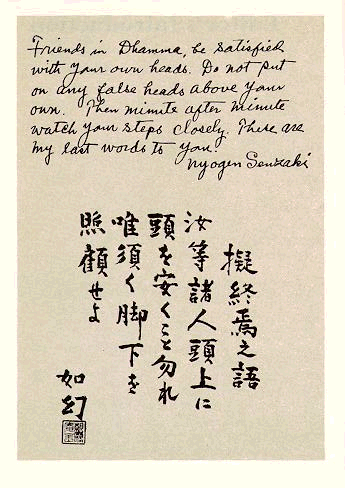
Abb.: "The last statement" von Nyogen Senzaki [Bildquelle:
http://www.amacord.com/fillmore/museum/zen/last.html. -- Zugriff am
2003-06-21]
1923
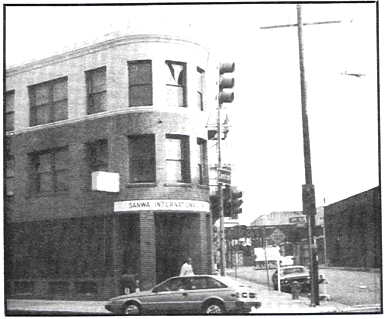
Abb.: Der erste buddhistische Tempel in Los Angeles, Kalifornien: Tempel der
Hongwanji Buddhist Church of Los Angeles an der Ecke First Street und Central
Avenue
[Bildquelle: Spring wind : Buddhist cultural forum. --
ISSN 0825-799X. -- Vol. 5, No. 4 (Winter 1985/86). -- S. 44]
1924
Immigration Act (Asian Exclusion Act) stoppt
asiatische, auch japanische, Einwanderung.
| "The
United States Immigration Act of 1924, also known as the National
Origins Act or the Johnson-Reed Act, limited the number
of immigrants who could be admitted from any country to 3% of the
number of person from that country who were already living in the
United States in 1890 according to the census of 1890. It superseded the 1921
Emergency Quota Act. The law was aimed at further restricting the
Southern and
Eastern Europeans who had begun to enter the country in large numbers beginning
in the 1890s, as well as East Asians and Asian Indians, who were
prohibited from immigrating entirely. It set no limits on
immigration from Latin
America. It passed with strong congressional support (only 6 dissenting votes
in the Senate). Some of its strongest supporters were influenced by
Madison Grant and his 1916 book, The Passing of the Great Race. Grant was
a eugenicist and advocate of the
racial hygiene theory. His data, which is now considered by the vast majority of
scientists to be flawed, purported to show the superiority of the
founding
Northern European races.
As an example of its effect, in the ten years following 1900
about 200,000 Italians immigrated every year. With the imposition of
the 1924 quota, only 4,000 per year were allowed. At the same time,
the annual quota for Germany was over 57,000. 86% of the 165,000
permitted entries were from the
British Isles, France, Germany, and other Northern European countries.
The quotas remained in place with minor alterations until the
Immigration and Nationality Act of 1965."
[Quelle:
http://en.wikipedia.org/wiki/Immigration_Act_of_1924. -- Zugriff
am 2005-04-27] |
1924
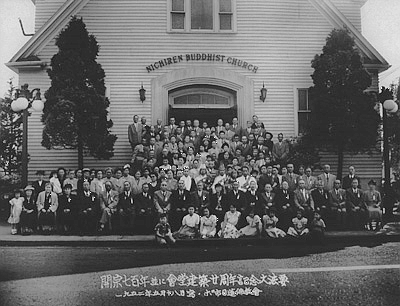
Abb.: Nichiren Buddhist Church Portland, 20. Jahrestag der Gründung, 1952
[Bildquelle:
http://www.nichiren-shu.org/portland/pages/main.htm. -- Zugriff am
2005-06-20]
| "In November of 1924, Rev. Ryushin Okihara, resident minister of
the Nichiren Buddhist Church in Seattle, conducted the first organized Nichiren
Shu service in Portland, Oregon. The service was held at the office of Dr.
Tanaka with 40 people in attendance. Rev. Okihara discussed organizing a church for Portland. On May
18th 1930 Rev. Okihara performed the dedication ceremony of the Nichiren Shu
Kuon Ko.
In September of 1930, the charter for a Nichiren Shu Church in
Portland was approved and Rev. Okihara was appointed the chief minister. On
January 24th 1931 a statue of our founder Nichiren Shonin (carved by Unkai
Okumura) arrived in Portland. The official dedication service of the newly
founded Church was held on February 22 with 130 people in attendance. It would
be soon after that the little facility being used became too small. Rev. Okihara
urged members to have a permanent Church site. A committee was formed and on
June 2, 1932, the ground breaking ceremony was conducted on a lot that was
located near the existing Memorial Coliseum. The building was completed in
August of 1932. "
[Quelle:
http://www.nichiren-shu.org/portland/pages/main.htm. -- Zugriff
am 2005-06-20] |
1924
Es erscheint die erste Auflage von
Vade Mecum / compiled by Ernest and Dorothy Hunt
Ein Gesangbuch für Honpa Hongwanji in Hawaii. Das Buch
enthält 114 Lieder, teilweise mit Melodien von R. R. Bode, Organist und
Chorleiter von Hongwanji. Es erschienen fünf Auflagen bis 1932, spätere
Auflagen unter dem Titel: Standard Gathas, bzw. Praises of the Buddha (z.B.:
Praises of the Buddha. -- 3rd ed., rev. -- Honolulu :
Honpa Hongwanji Mission of Hawaii, 1962. -- iv, 210 S. : Noten). Die
späteren Ausgaben enthalten mehr japanische Lieder (die erste Aufl. war rein
englischsprachig).
Beispiele:
Buddha's Soldiers / von Dorothy Hunt
Have you heard the sound of footsteps
As of soldiers marching on?
Have you seen their banners waving?
Have you heard their battle song?
Have you watch'd their blazing torches
Lighting up their columns long?
Have you heard the sound of footsteps
As of soldiers marching on?
Yes, we heard their footsteps thunder
In the watches of the night
And we saw their banners waving
By their torches' flaring light
And the stirring songs they shouted
Filled our hearts with strange delight
Yes, we heard their footsteps thunder
In the watches of the night
It was sad to see them marching
To some battlefield of pain,
There to leave their youthful bodies
Mid the fallen and the slain
That some earthly king or monarch
On his golden throne might reign
It was sad to see them marching
To some battlefield of pain
Nay, these are the Buddha's soldiers
And the foe they seek to slay
Is illusion's self that hinders
Mankind's progress day by day
Righteousness the sword they carry
Wisdom's torch that lights their way
Nay, these are the Buddha's soldiers
And the foe they seek to slay
For no earthly king or monarch
Do they march to meet the fight
But to spread the Buddha's Teaching
Dim the darkness of our night
And to crown the Truth triumphant
In the splendor of Love's Light
For no earthly king or monarch
Do they march to meet the fight
[Quelle:
http://www.mahindarama.com/mbt/lyrics.htm. -- Zugriff am 2005-07-05]
Listen to His voice / von Dorothy Hunt
Gladly sing the children's voices
In Lord Buddha's temple bright
As they tell the wondrous story
Of His search to find Truth's Light
For how many years He wandered
In the forest dark and vast
Till one night upon His spirit
Wisdom's Holy Light was cast
Beneath the tree, the Master's seated
Found Nirvana's radiant peace
Saw before His eyes the Pathway
Whereby all men's ill shall cease
Oh, what glorious light was shining
From the Lord Buddha's gentle face
As He went to preach salvation
To the people of His race
And the people, when they heard Him
Gladly walked the Eightfold Way
Leading from the realms of darkness
Into everlasting day
So shall we, His little children
Listen to His voice so sweet
As those little Indian children
Whom He gathered at His feet
[Quelle:
http://www.mahindarama.com/mbt/lyrics.htm. -- Zugriff am 2005-07-05]
1925
Der ehemalige amerikanische Missionar Dwight Goddard
(1861 - 1939) verbringt einige Monate in Karl Reichelt's ( -
1952) Christlich-Buddhistischem Kloster Tao Fung Shan in Nanking (China).
"GODDARD, Dwight (July 5, 1861, Worcester, Massachusetts—July
5, 1939, Randolph, Vermont); married; education: Worcester
Polytechnical Institute; Hartford Theological Seminary, graduated
1894.
Dwight Goddard, founder of the Fellowship Following Buddha and one
of the pioneer non-Oriental Buddhists in the United States, began
his adult life as a mechanical engineer. After ten years in
engineering, however, he turned his back on the business world and
entered Hartford Theological Seminary to prepare himself as a
Christian missionary. Following graduation, he was sent to China by
the Baptist church. While there, he met and married his first wife,
who was serving as a medical missionary.
After almost two decades in the mission field, he became discouraged
with the progress of the church as a religious force and developed
an interest in Buddhism. At first he believed that the two faiths
had much in common and sought ways to reconcile them. In San Diego
in 1924, he proposed the formation of a Christian and Buddhist
Fellowship. In further pursuit of his goal, he entered Shokoku (Zen)
monastery in Japan to study with Roshi Taiko Tamazaki. Then,
in 1927, he published his first major book, Was Jesus Influenced
by Buddhism?
Gradually, he became convinced that the goal of mixing or
reconciling Buddhism and Christianity was futile, and he slowly lost
his interest in Christianity. He then conceived of a Buddhist
missionary effort within the United States. During this period of
growing interest in Buddhism, he divorced his first wife and
remarried. That second marriage also ended in divorce.
After his second divorce, having become convinced that Zen was the
form of Buddhism closest to the teachings of the Buddha, Goddard
built a home and temple near Union Village, Vermont, from which he
could both live the secluded ascetic life his faith demanded and
launch his Buddhist mission program. He began a magazine, Zen,
and published his most important book, A Buddhist Bible. This
volume brought together in a popular edition essential Buddhist
writings, many translated for the first time into English from
Indian, Chinese, Japanese, and Tibetan schools.
In 1934 Goddard proposed the organization of a Fellowship
Following Buddha as a means of spreading Buddhism among
non-Oriental Americans. He suggested the establishment of two
cooperative homes, one in Vermont and one in California, where a
small group of brothers could live the quiet Buddhist life and where
those wishing to learn about and practice the faith could reside for
brief periods. In good weather, the brothers could travel between
the two locations teaching classes and distributing literature. This
semimobile life would, Goddard believed, be the most efficacious in
spreading interest in Buddha.
Goddard's plan was not implemented beyond the establishment of his
own personal temple in Vermont. He died in 1939 and his idea along
with him. However, his writings, which were circulated widely and
reprinted in the 1970s, laid the foundation upon which a popular
Buddhism began to grow in the 1960s."[Quelle:
Melton, J. Gordon: Biographical dictionary of American
cult and sect leaders. -- New York : Garland Pub., 1986. -- 354 S.
; 24 cm. -- ISBN 0824090373. -- s.v.] |
Zum Missionar Karl Reichelt (-1952):
"Karl Reichelt was a visionary pioneer in charting a new
course of approaching Chinese Buddhists. Affiliated initially with
the Norwegian Missionary Society, Reichelt focused his effort almost
entirely on reaching seekers, or "friends of the Dao," from among
Buddhist leaders and laypeople. To this end, he established a
program that welcomed wandering monks and pilgrims to visit for
religious conversation, trained those who made a commitment to
Christ, and held retreats and conferences for seekers. He started
with a conference center in Nanjing, but in 1927, under the name of
The Christian Mission to Buddhists, he built a new site near
Shatin in the New Territories, Hong Kong, and called it Tao Fong
Shan. The center continues to today, but with a different
emphasis from what Reichelt had.
The Dao Became Flesh
What made Tao Fong Shan unique to those who came to inquire there?
Located on a scenic hill top, with many surrounding mountains, its
facilities and style of worship created no immediate external
obstacles to studying the Christian faith. Most prominent was an
octagonal temple, with its roof curved in the familiar lines of
Chinese architecture. Within the temple was an "altar in beautiful
Chinese style, with a red lacquer finish... the swastika of cosmic
unity and perfect peace, the fish of Eastern and Western sanctity,
and the Greek monogram for Christ." Above the gate through which
people entered the complex of buildings was a cross rising out of a
lotus to show that the best of Buddhism was fulfilled in Christ.
Above the inner entrance to the sheng dian (holy temple) was the
phrase, "The Dao Became Flesh," and along the two sides of the door
were the phrases "The Dao Was with God" and "The Wind Blows Where it
Wills."
Candles, incense, and meditation were a part of the worship service.
Buddhist monks in their temple services chanted the "Three Refuges"—"I
take refuge in the Buddha, in the Dharma (law) and in the Sangha (the
order/ community)." For this central Buddhist affirmation, Reichelt
substituted a full liturgy which amplified the basic, "I take refuge
in Father, Son, and Holy Spirit."
While holding firmly to faith in the uniqueness of Jesus Christ and
the need explicidy to "name the Name" of Christ for salvation,
Reichelt believed that Jesus, God s Eternal Logos, was working to
lead people toward Christ within every religious faith. He based his
convictions on what he called "the Johannine Approach." This gave
special emphasis to the "light that lights every person was coming
into the world" (John 1:9) and to the Logos who was in the world and
was both resisted and received by different people (John 1:10-13).
When the Logos entered human society and completed his work of
salvation, He led these "seekers" to recognize Him in His fullness
(John I:l4ff). In this approach Reichelt followed in the path of
early Christian leaders like Justyn Martyr, Clement of Alexandria,
Origen, and Augustine who promoted the work of what they called the
logos spermatikos. Reichelt could not claim great results, but,
sparse as they were, they far exceeded what other missionaries
reaped from the same kind of people.
Including the pre-Hong Kong ministries and the period in Hong Kong
from 1930 to 1950, over two hundred people were baptized, and nearly
1500 came to the center to study the Christian faith seriously.
Reichelt's influence spread far beyond statistics. Those who were
converted had extensive correspondence with their former associates,
they wrote testimonial letters in the Chinese press, and they had
significant ministries in many places. Reichelt himself travelled
widely to temples and monasteries to find serious religious seekers.
He made significant friendships with important national Buddhist
leaders, chief of whom was Tai Hsu, who sought to renew Chinese
Buddhism. In 1923, he attended a world conference of Buddhists at
Gulin, a summer retreat center, and lectured on John 1 and the
identification of Jesus the Logos with the Dao.
The Message in the Receptor Culture
Reichelt did more than equate Jesus with the Dao of the Chinese
religious scene. He probed deeply into Buddhism, seeking to relate
God's revelation to such doctrines as the bodhisattvas, salvation as
identification with the ultimate, karma, nirvana, and meditation.
This was no "proof text" approach and was not argumentative in
style. He truly tried to understand Buddhist thinking and relate to
sincere seekers wherever he could find them. An outgoing and warm
personality, he made friends with people in such a way as to draw
them to Christ.
Reichelt's approach, wirh modifications to fit the current world
scene, is continued partially by the Tao Fong Shan Christian Center.
Its periodical, Areopagus, stimulates people to understand,
dialogue with, and witness to the religions of Asia, particularly
Buddhism. Various articles in the journal, for example, have tried
to relate Zen (Chan in Chinese) to the Christian-Buddhist encounter."
[Quelle: Ralf Covell: Buddhism and and the gopel among the
peoples of China. -- In: International journal of frontier missions.
-- 10,3 (1993). --
http://www.ijfm.org/PDFs_IJFM/10_3_PDFs/Covell.pdf. -- Zugriff
am 2005-05-30] |
D. Thurston Griggs (1916 - ) erinnert sich an einen
Besuch in Tao Fung Shan am 23. Mai 1936:
| "Higher on mountains above where we were staying was a
"Christian" monastery called Tao Fung Shan. It consisted of a fine
group of new buildings in Chinese style on a beautiful location
overlooking a valley, with surrounding mountains, and with a great
view over the bay from the ocean which runs in like a fjord. This
monastery, run by Scandinavian Lutherans, is open to all Chinese who
are interested in religion of any kind. Dr. Karl Reichelt, head of
it, is an extraordinary scholar of Chinese religions, and his talks
with the religious men who come there seem to be the backbone of its
work. We went there for meals, eating in the dining hall with the
four Taoist priests, ten Buddhist monks, one lama, and 12 Christian
students from all provinces of China. All of them were young men - a
very fine group. The atmosphere is one of fused Chinese religions:
gongs, drums, hangings, rosaries, prayer mats incense, etc; but
Christ's picture is above the altar in the chapel, and there is a
pump organ for music. We attended their Sunday Service which was
very Chinese in religious format except for Christian hymns (sung in
Chinese scale) and the sermon, which was repeated from Mandarin to
English for our benefit. The Scandinavians were devout people, and
they knew Mandarin well. There were about 25 students and 4
Scandinavian missionaries there.
It was a different and significant type of mission. It is known
to Buddhists and Taoists all over China. The students of religion
and philosophy who come there are shown a Chinese form of
Christianity, and most of them seem keen on it. Of course they
confine it to sincere young men. The young men are encouraged, after
their schooling is finished there, to go back to their homes and
lead active Christian lives like ordinary laymen - unless they wants
to be active in religious work. It is a truly remarkable enterprise,
and just the kind you would expect to find Scandinavians involved
in. The place had a special atmosphere, as its name suggests. This
is a well-planned presentation, to China, of a form of Christianity
that is easy for them to understand, capable of reaching people who
are naturally religious and who lean toward nature, toward Buddhism
or Taoist mysticism."
[Quelle:
http://userpages.umbc.edu/~tgriggs/autobio.html. -- Zugriff am
2005-05-31] |
1925
Zenmeister Nyogen Senzaki (1876 - 1958) gründet mit Hilfe
des Sufi Samuel Lewis (Murshid Sam) (1896 - 1971) ein Zendo in San
Francisco.
[Zu Samuel Lewis siehe:
Rawlinson, Andrew <1943 - >: The book of enlightened masters : western teachers
in eastern traditions. -- Chicago : Open Court, ©1997.
-- 650 s. : Ill. -- ISBN 0-8126-9310-8. -- S.396 - 403]
|
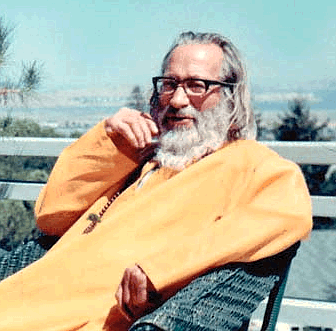
Abb.: Murshid Sam
[Bildquelle:
http://www.sonic.net/fatima/oldphotos1/samphotospage1.htm. --
Zugriff am 2005-04-28]
"LEWIS, Samuel Leonard (October 18,1896, San Francisco,
California— January 15, 1971, San Francisco, California).
Sufi Murshid Samuel L. Lewis more thoroughly than most American Sufi
leaders embodied the belief in the essential unity of religions (at
least on a devotional and mystical level) and of religious ideals (love,
beauty, harmony). Lewis was born into a Jewish family. As a youth he
showed an inclination to non-Jewish religious studies, much to the
consternation of his parents. In 1915 he visited the World's Fair in San
Francisco and discovered Theosophy. Four years later he discovered
Sufism and began to study with American Sufi Murshid Rabia Martin, a
disciple of Hazrat Inayat Khan, founder of the Sufi Order. Martin
introduced him to Khan in 1923, and Lewis was formally initiated as a
Sufi. The perspectives of the Sufi order gave focus to the rest of
Lewis's life.
In 1920 Lewis had met Sogaku Shaku (a.k.a. M. T. Kirby),
an early American convert to Buddhism, who introduced him to Nyogen
Senzaki, an early Zen teacher in California. He attended Senzaki's
lectures and assisted him in establishing his famous floating zendo.
In 1930 Lewis traveled to New York to sit with Shigatsu (Sokei-an)
Sasaki, who had opened the First Zen Institute of America.
Sokei-an gave Lewis Dharma transmission, a recognition of Lewis as an
accomplished teacher of Zen.
During the 1930s, Lewis also began to absorb elements of Hinduism. He
met Paul Brunton and was initiated into the yoga of Ramana Maharshi.
Lewis did not let his explorations of other religions adversely affect
his relation to Sufism. On Khan's last visit to the United States, Lewis
had six private audiences with him. Khan pronounced Lewis "Protector of
the Message." From 1927 to 1942, he assisted Rabia Martin at the center
in Fairfax, California. During World War II he served in U.S. army
intelligence (1942-5). In 1947 Rabia Martin died, but prior to her death
she reoriented the group to Meher Baba. Lewis remained a member for two
years but withdrew in 1949. He discovered that other Sufis did not
recognize the status Khan had assigned him in 1926, and for many years
he existed as an independent Sufi.
In 1956 Lewis made independent contact with Sufis in Pakistan and was
initiated into the Naqshbandi order. He traveled on to India that same
year and was initiated and ordained by the Nizami (Chishti) order, the
group from which Khan had received his authority. His initiation took
place at Ajmer, the international center of the Chishti order.
In 1960 Lewis returned to Asia for two years. En route he stopped in
Egypt, where he was initiated into both the Rifai and Shadhili Sufi
orders. Traveling on to India and then Pakistan, in 1962 he was
initiated into the Khalandar and Khidri-Chishti-Kadri orders. Then, Pir
Sufi Barkat Ali of the combined Chishti, Kadiri, and Sabri orders gave
full public ordination of Lewis as a murshid. He returned to the United
States ready to reinitiate a Sufi movement.
During these years Lewis had not given up his associations with Hinduism
and Buddhism. In 1953 he had been initiated by Swami RamDas (not to be
confused with American guru Baba Ram Dass) of Kanhangad, India. In 1956
he was received and recognized by Zen masters of Japan and was initiated
into Shingon Buddhism. In 1967 he was ordained a Zen master by Korean
Zen master Kyung-Bo Seo.
Back in the United States in the mid-1960s, Lewis gathered disciples,
the first of whom were initiated in 1966. (He also took off time to help
start the Holy Order of MANS, an occult Christian order in San
Francisco.) He named his first center the Mentorgarten, after the
zendo established in the 1920s by Nyogen Senzaki.
During the last years of his life he traveled widely and became a
popular figure within Eastern religious groups in the western United
States. In 1968 he met Pir Vilayat Inayat Khan, the son and successor to
Inayat Khan, who was in the process of reestablishing the Sufi Order in
the United States. Lewis aligned his work with that of Pir Vilayat.
After Lewis's death, some of his students developed disagreements with
Pir Vilayat. They left the Sufi Order and in 1977 formed the Sufi
Islamia Ruhaniat Society, currently headquartered in San Francisco."
[Quelle: Melton, J. Gordon: Biographical dictionary of
American cult and sect leaders. -- New York : Garland Pub., 1986.
-- 354 S. ; 24 cm. -- ISBN 0824090373. -- s.v.]
|
1927
Suzuki, Daisetz Teitaro <1870-1966>: Essays in Zen Buddhism, (First series)
-- London : Luzac, 1927. -- 423 S. : Ill. -- ["Published for the Eastern
Buddhist society, Kyoto, Japan."]
1928
Der ehemalige amerikanische Missionar Dwight Goddard
(1861 - 1939, s. unten 1932) übt in einem Zen-Kloster in Japan unter dem
Zenmeister Roshi Taiko Tamazaki.
1928
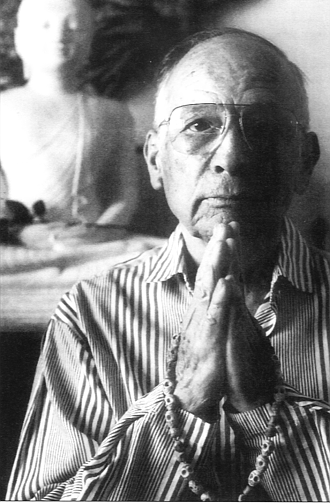
Abb.: Julius Goldwater
[Bildquelle: Tricycle : the Buddhist review. -- ISSN 1055-484X. --
Vol. VII, No. 2 (Winter 1997). -- S. 45.]
Julius Goldwater (1908 - ) tritt in Honolulu formell
zum Shin-Buddhismus über.
"He [Julius Goldwater] was born German-American and Jewish in
Los Angeles in 1908. His mother planned to raise him as an observant
Jew, but she died when he was two-and-a-half. His father later put
him through two years of Jewish Sunday School. "It didn't take,"
Goldwater reports, but his early encounters with Judaism instilled
in him a spiritual thirst that would later lead him to McPherson's
revivals as well as Inayat Khan's Sufi lectures, Manly P. Hall's
occult speculations, Krishnamurti's cryptic reflections on the
pathless path, and Swami Prabhavananda's Vedantist Hinduism. Of all
his early teachers, Goldwater was the closest to Hall. A homespun
philosopher and prolific writer who divined a common core at the
heart of all religions, Hall became Goldwater's mentor, inviting him
to services at his Church of the People and allowing him access to
one of the world's largest libraries on parapsychology, mysticism,
and Eastern religions.
Goldwater didn't give Buddhism much thought, however, until he and
his father moved to Hawaii in the late twenties. The Hompa Hongwanji
of Japan had sent Jodo Shinshu (True Pure Land) Buddhist
missionaries to Hawaii in 1889, so Shin Buddhism, at the time of
Goldwater's arrival, was the dominant form of Buddhism within the
islands' Japanese-American population. However, because the Issei (first-generation
Japanese Americans) conducted services in Japanese, there were few
Caucasian sympathizers, and English-speaking Nisei (U.S.-born,
second-generation) were beginning to defect to Christian churches.
In an effort to reach out to Caucasians and the Nisei, in the early
1920s, Honolulu's Hompa Hongwanji temple began to offer services in
English.
Goldwater went with a friend to one of those services. There he met
Rev. Ernest Hunt, Hawaii's only European-American Buddhist
minister and a committed Buddhist ecumenist. Hunt excelled at
explaining his "international Buddhism" to the U.S.-born Nisei. When
Hunt spoke, Goldwater says, "something grabbed me." It was the claim
that Buddhist teachings were "self-validating as you go along." If
you do what the dharma tells you to do, Hunt promised, you will see
the results.
Goldwater begged Hunt to accept him as a Buddhist, but Hunt only
warned him not to "monkey around." Goldwater didn't. In Honolulu in
1928, during a ceremony at the "Temple of Amidha's Fulfilled Vow,"
he took formal vows and became one of America's first Jewish
Buddhists.
At the urging of his wife, Pearl Wicker, a Lutheran whom he
married in a Jodo Shinshu ceremony in Hawaii, Goldwater returned to
Los Angeles in the midst of the Depression. Now known as Subhadra
(after one of the last disciples to see Shakyamuni before he
died), Goldwater joined Little Tokyo's Nishi Hongwanji, a Jodo
Shinshu temple affiliated with the Buddhist Mission of North
America. As the only Caucasian member of the temple, he was
especially beloved by Nisei boys and girls, whom he instantly won
over by organizing a youth dance.
Goldwater's work at the Nishi Hongwanji caught the eye of leading
Jodo Shinshu priests, who urged him to travel to Japan for
ordination. Nisei youth were jumping too eagerly into the American
melting pot. If Goldwater added the traditional authority of
Buddhist ordination to the charismatic cachet of his American roots,
perhaps he could stem the tide. "I couldn't have been less
interested" in the priesthood, Goldwater confesses, "but their need
was so great." He was ordained in Kyoto in the Jodo Shinshu
tradition in 1936.
He then went to China, where he demonstrated his commitment to
Buddhist ecumenism by receiving ordination once again, this time in
Hangchow. "I knew I wasn't worthy," Goldwater says, "but I was
inwardly kind of proud. At last I was an accepted Buddhist."
There is a saying among Japanese-American Buddhists that "the
priests in Japan live an unchanging life of rice paddies, while
ministers in America live a life of sheep." Rev. Goldwater's new
life as the first European-American Jodo Shinshu minister on the
mainland was a shepherd's life. He led English-language services,
taught Sunday School, and organized youth groups—anything to keep
his sheep at the Nishi Hongwanji in the fold. He also traveled up
and down the West Coast, "preaching the gospel" to
Japanese-Americans in agricultural settlements as far north as
Seattle, Washington.
On December 7,1941, the Japanese bombed Pearl Harbor. In February
1942, President Roosevelt signed Executive Order 9066, clearing the
way for the removal of more than 100,000 Japanese Americans from the
West Coast into what Roosevelt himself admitted were "concentration
camps."
Before World War II, Goldwater had been a groundbreaking but
relatively insignificant American Buddhist—a minor presence even at
his home temple (which typically had ten Japanese-speaking priests
in residence). But Executive Order 9066 whittled membership in the
temple to one. As Goldwater watched in horror, his fellow Buddhists
were relocated, first to temporary internment camps at places like
the Santa Anita racetrack and later to more permanent concentration
camps in locations as far away as Rohmer, Arkansas. What had been a
thriving temple was reduced to a storehouse for the family treasures
of evacuees. And Goldwater became a shepherd of Buddhist exiles
scattered across the world's newest diaspora.
For the next four years, Goldwater ministered to his sheep like the
Methodist circuit riders of the nineteenth century. His horse was a
"snappy" Chrysler, and he hitched it to outposts as far-flung as
Gila River, Arizona, and Heart Mountain, Wyoming. At a time when the
rest of America viewed "Japs" as strangers from another planet,
Goldwater treated each evacuee with attentive compassion. There were
ten concentration camps, and he visited them all, some many times
over. At Santa Anita he saw human beings housed in stables
ankle-deep in horse dung, and at camps across the country he heard
stories of prison guards sexually molesting young children. Because
"there wasn't anyone else to do it," he trudged from camp to camp,
distributing coffee, candy, and self-published Buddhist books.
Rev. A. Arthur Takemoto attended Goldwater's youth dances in
the 1930s. Interned at Poston, Arizona, and Topaz, Utah, he
remembers the difficulties and dangers of practicing Buddhism in the
camps. Many Buddhists stayed in the closet for fear of being labeled
anti-American. Those who were out had to build new sanghas from
scratch. Evacuees couldn't take much with them. Some priests
smuggled in Buddha statues, and one enterprising Buddhist crafted a
shrine out of discarded apple crates. "Everything was improvised,"
Takemoto says, and Goldwater was among the improvisers.
During the war, Goldwater founded the Buddhist Brotherhood of
America, an ecumenical organization devoted to printing and
distributing nonsectarian Buddhist books to internees. Among these
books was an English-language worship manual that incorporated into
Buddhist practice Christian elements such as catechisms, creeds, and
hymns (some sung to Protestant strains Goldwater had heard on the
lips of McPherson's 200-voice chorus). Long before Philip Kapleau,
Jiyu Kennett, and other Zen teachers agitated for adapting Buddhism
to American soil, Goldwater was using "skillful means" to
Americanize Buddhism.
He did this not only to make it easier for the Nisei to practice
Buddhism but also to validate Buddhism in American eyes. "Everybody
thought the Japanese were from Mars," Goldwater explains. The FBI
equated Buddhism with Shinto and Shinto with fanatical allegiance to
the emperor. Goldwater and like-minded Nisei Buddhists, many of whom,
like Takemoto, were tracked by the FBI, tried to correct that
misunderstanding by emphasizing the "Americanness" of Buddhism.
Goldwater was not able to convince his fellow Americans that
Buddhism should stand side by side with Protestantism, Catholicism,
and Judaism as a legitimate national faith. But he did convince many
fellow Buddhists that to survive in America they would have to
assimilate. In 1944, at Goldwater's urging, the Buddhist Mission of
North America changed its name to the Buddhist Churches of
America. After the war, a new generation of Goldwater-influenced
Nisei priests carried on the work of accommodation, transforming the
B.C.A. into the country's largest Buddhist body.
Not everyone was happy with this turn of events. As a member of the
Japan-born Issei generation, Goldwater's bishop was no fan of
Americanization. He hated youth dances, and battled Goldwater over
using the temple as a storage facility for evacuees. After the war,
he sued Goldwater for temple mismanagement. It wasn't fair, Takemoto
says, but the bishop prevailed on a technicality. Undaunted,
Goldwater continued to practice his own version of engaged Buddhism.
With Takemoto's help, he opened a number of Buddhist hostels
designed to ease the transition of internees back to postwar
normalcy.
In the half century since World War II, Goldwater has lived a quiet
life in Los Angeles. The brick and concrete fortress that was once
his home temple now houses the Japanese American National Museum.
Goldwater, still happily married to his first and only wife, does
not attend the new Nishi Hongwanji, but he does convene a Buddhist
study group in his home. Each morning and night he sits silent and
alone in a practice that, in keeping with his principled eclecticism,
owes as much to the Quakers as to the Buddhists. "You can call it
meditation," he says, "but I prefer to call it concentration—one-pointedness
of mind."
Goldwater's Buddhism eludes simple labels. He doesn't chant the
nembutsu and doesn't like to be called a Shin Buddhist. ("In Jodo
Shinshu, Buddhism is a matter of faith," he explains, while real
Buddhism "has nothing to do with faith") His practice is "Indian
Buddhism, with lots of Chinese and very little Japanese thrown in."
In Dharma Bums, Ray Smith (the alter ego of author Jack Kerouac and
another violator of conventional Buddhist boundaries) calls himself
"an old-fashioned dreamy Hinayana coward of later Mahayanism." Take
out the coward, and that's a fair description of Goldwater, who like
Khan, Hall, Hunt, Krishnamurti, and Prabhavananda, insists that the
rivers of true spirituality do not respect the banks of sectarian
religious divisions.
Goldwater spent time with D. T. Suzuki in Los Angeles and
with Nyogen Senzaki in the camps, and remembers both Zen
teachers with respect. He also admired theosophist Katherine
Tingley, though he regards theosophy as "an imitation
introduction to Buddhism," a "watered-down version" of the true
dharma. He thinks less of the Beats ("Buddha Bums" he calls them),
whose use of drugs appalled him, and of Alan Watts, who, by
his reckoning, practiced Buddhism only two weeks a month.
For Goldwater, Watts is like MacPherson—an example of
the bugaboo of what the Chinese Buddhist reformer Tai-hsu decried as
"churchdom." "All churches, no matter what the religion, are
primarily concerned with raising money to support themselves,"
Goldwater says. Unfortunately, the marriage of religion and
economics can only produce spiritual counterfeits—"genuine fakes"
like Watts and McPherson.
Perhaps that's why Goldwater finds the current Tibetan Buddhist
vogue troubling. In his view, Snickers ads featuring Tibetan monks
and Microsoft ads starring the Dalai Lama aren't spreading Buddhism;
they're exploiting it. And thanks to Little Buddha, there is
now an entire American generation that equates the life of Gautama
Buddha with the acting of Keanu Reeves. "Everyone in
Hollywood wants to belong to the Buddhist religion now," Goldwater
says, "but none of them are real Buddhists."
If Goldwater underestimates Sin City's Buddhist population, it's
because he worries that the commercialization of the dharma will
obscure Buddhism's true purpose. Freedom, according to Goldwater, is
the essence of Buddhism. Real Buddhists struggle to free their minds
from ignorance, and the world from oppression. When Goldwater says "Buddhism
is more American than America," he means that while politicians talk
freedom, Buddhists make an active practice of it. During World War
II, the U.S. government made an active practice of imprisoning
Japanese Americans. Goldwater struggled to mitigate their suffering
and to work for their emancipation.
The United States began to balance its karmic accounts in 1989 when
President Bush signed a law allocating $20,000 in reparations to
each living Japanese-American internee. Mrs. Jane Imamura was among
the recipients. She and her husband had used books and incense
provided by Goldwater during Buddhist services in the Gila River
camp, and, after the war, they had taken charge of one of
Goldwater's halfway houses. She remembers Goldwater as "a very, very
compassionate person" who demonstrated during the war that Buddhism,
at its best, is a religion of compassionate engagement with a world
of suffering. She sent Goldwater $500 of her reparations payment
with a letter of thanks. "I won't ever cash it," Goldwater says. He
wasn't in it for the money."[Quelle: Stephen Protero: The
good shepherd. -- In: Tricycle : the Buddhist review. -- ISSN 1055-484X. --
Vol. VII, No. 2 (Winter 1997). -- S. 45 - 48.] |
1928
Ein kongregationalistischer Geistlicher, der eine
englischsprachige Liturgie in einem Honpa-Hongwanji-Tempel in Hawaii erlebt
hatte, schreibt:
| "I went into a Buddhist temple, which ministers to a
Congregation of English-speaking young Oriental Americans. It is
most tastefully appointed. Except for the altar equipment, which is,
of course, pronouncedly Buddhistic in its symbolisms, you would
almost have to be told you were in the courts of the "heathen." It
looks much like a church. The Buddhists, physically, are made very
much as we are, and, of course, have pews on which they sit—for all
the world like Christians. They are very quiet—and come into their
temple softly and silently ... I purchased a little hymnal in the
literature department of the temple. Much of the ritual is excellent,
and with substitution of the name of Christ for that of Buddha could
be heartily recommended to many of our churches in which worship has
been neglected until it isn't even missed." [Quelle: Hunter, Louise H.: Buddhism in Hawaii : its impact on a Yankee
community. -- Honolulu : Universitity of Hawaii Press, 1971. -- 265 S. -- S.
131] |
1929
Zum ersten Mal überwiegen zahlenmäßig Nisei (japanischstämmige
Amerikaner der zweiten Generation) gegenüber Issei (japanischen Einwanderern).
Zur Terminologie:
-
Issei Japanese Americans (一世 = erste Generation)
japanstämmige Amerikaner der ersten Generation, die vor dem
Immigration Act von 1924 in die USA gekommen sind.
-
Nisei Japanese Americans (二世 = zweite Generation)
japanstämmige Amerikaner der zweiten Generation in den USA, in den
USA geborene Kinder der Issei
-
Sansei Japanese Americans (三世 = dritte Generation)
in den USA geborene Kinder der Nisei, Enkel der Issei
Gründung der von Nisei beherrschten Japanese American Citizens League (JACL)
in Seattle [Webpräsenz: http://www.jacl.org/. -- Zugriff am 2005-04-28]
|
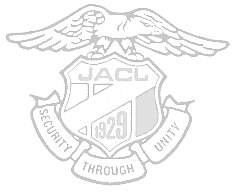
Abb.: Logo®
"The Japanese American Citizens League, the nation's oldest and largest Asian
American civil rights organization, was founded in 1929 to address issues of
discrimination targeted specifically at persons of Japanese ancestry
residing in the United States. In California, where the majority of Japanese
Americans resided, there were over one hundred statutes in California that
proscribed the limits of rights of anyone of Japanese ancestry.
Organizations like the Grange Association and Sons of the Golden West
exerted powerful influence on the state legislature and on Congress to limit
participation and rights of Japanese Americans, and groups like the Japanese
Exclusion League were established with the sole purpose of ridding the state
of its Japanese population, even those who were American citizens by birth.
Amidst this hostile environment, the JACL was established to fight for
the civil rights primarily of Japanese Americans but also for the benefit of
Chinese Americans and other peoples of color. Although still a small,
California-based organization, the JACL was one of only a few organizations
in the 1920s and 1930s willing to challenge the racist policies of the state
and federal governments. With limited resources and virtually no experience
in state or federal politics, the JACL nevertheless took it upon itself to
set the course for civil rights for persons of Asian ancestry in the West
Coast region of the United States as well as at the federal level by
combating congressional legislation aimed at excluding the rights of
Japanese Americans and Asian Americans.
The true test of the JACL came some ten years after its inception when
the nation of Japan attacked the U.S. Naval base at Pearl Harbor and
launched America into World War II. Within hours after the attack at Pearl
Harbor, the FBI swooped down on all Japanese communities in the West Coast
states and arrested any elders identified as leaders, suddenly thrusting a
young JACL leadership in the difficult position of having to confront a
hostile U.S. government whose intent was to exclude and imprison the entire
Japanese American population.
Throughout the war, the JACL continued its efforts to insure some measure
of protection and comfort for Japanese Americans imprisoned in government
detention camps. The organization argued for and won the right of Japanese
Americans to serve in the U.S. military, resulting in the creation of a
segregated unit, the famous 442nd Regimental Combat Team, which joined with
the 100th Battalion from Hawaii and became the most highly decorated unit in
U.S. military history despite having only served in combat for a little over
a year in the European theater of the war.
Following the war, the JACL began a long series of legislative efforts to
win back the rights of Japanese Americans. In 1946, the JACL embarked on a
hard-fought campaign to repeal California's Alien Land Law, which, enacted
in the early years of the century, prohibited all Japanese aliens (i.e.,
immigrants) from purchasing and owning land in the state, one of the most
discriminatory statues enacted in California against Japanese Americans. In
1948, the JACL helped found the Leadership Conference on Civil Rights and,
in the same year, succeeded in gaining passage of the Evacuation Claims Act,
the first of a series of efforts to rectify the losses and injustices of the
WWII internment. In 1949, the JACL initiated efforts in the U.S. Congress to
gain the right of Japanese immigrants to become naturalized citizens of the
U.S., a right denied to them for over fifty years. The 1951 Walter-McCarren
Act, which was essentially a JACL-initiated bill, included language that
opened a back door that gave women in this country a foothold on broadening
their rights of participation in the democratic process. Among its major
accomplishments, the organization committed its lobbying efforts for passage
of the landmark 1964 Civil Rights Act, the culmination of the great civil
rights movement of the 1960s.
In 1970, at its biennial convention in Chicago, the JACL passed a
resolution calling for recognition of, and reparations for, the injustice of
the WWII internment of Japanese Americans. It formalized the debate as a
priority within the organization despite the Japanese American community's
tepid response to the issue. In 1978, the JACL launched a major campaign to
seek redress from the U.S. government for the imprisonment and loss of
freedom of Japanese Americans during WWII. The JACL was determined to seek
some measure of legislative guarantee that the violation of constitutional
rights visited upon Japanese Americans would never again be brought upon any
group in the United States.
Within two years of launching the campaign, a JACL-sponsored legislation
to create a federal investigative commission was approved by the Congress
and signed by President Carter. The Commission on Wartime Relocation and
Internment of Civilians was established to investigate the circumstances
surrounding the WWII internment and provide its findings to the Congress and
the president. The commission's report in 1982 found that the government's
actions were unjustified and unconstitutional, and based on this
substantiation of its claims and on the commission's recommendations for
monetary redress, the JACL sought legislation calling for monetary redress
and a presidential apology.
The redress campaign culminated with the signing of the Civil Liberties
Act of 1988, which provided monetary compensation and a formal apology to
the victims of the WWII internment. After ten years of campaigning in
Washington D.C. and across the country through its chapters' grassroots
efforts, the JACL successfully brought to a close a final episode in one of
the darkest chapters in the constitutional history of the nation.
The JACL Today
While the JACL's founding mission was focused on protecting the civil rights
of Americans of Japanese ancestry, today we are committed to protecting the
rights of all segments of the Asian Pacific American community.
This change was first prompted in the early 1980s when a young Chinese
American man was murdered in Detroit when he was mistakenly identified as
Japanese. The murder of Vincent Chin brought about the recognition by the
JACL of the need for vigilance to maintain the rights of all Asian
Americans, for it became apparent that those who would do harm to Japanese
Americans did not discriminate in their hatred and bigotry against Asians or
other peoples of color.
During the past three decades, as the Asian American population has
continued to grow, and as other Asian ethnic groups emerged in the broader
Asian American community, the JACL recognized the need and responded to the
challenge of insuring the rights and well-being of all Asian Americans.
Today, with out-marriage changing the face of the Japanese American
community, the JACL faces additional challenges in looking to its future and
to the future of the Japanese American community.
Whatever that future might be, as the nation's oldest Asian American
civil and human rights organization, the JACL will continue to dedicate
itself to preserving the rights and well-being of all Asian Americans and
others who fall victim to social injustice in the United States."
[Quelle:
http://www.jacl.org/about.html. -- Zugriff am 2005-04-28] |
1930
Ruth Fuller Everett (1893 - 1967) (ab 1944 durch Heirat mit Sokei-an Shigetsu Sasaki
(1882 - 1945): Ruth Fuller Sasaki) trifft in Japan D. T. Suzuki. Sie
lernt bei ihm die Grundzüge des Zazen. Zwei Jahre später übt sie in Kyoto Zazen
unter dem Rinzai-Zenmeister Nanshinken Roshi.
|
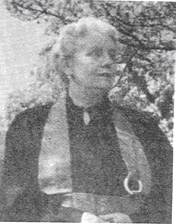
Abb.: Ruth Fuller Sasaki
"Mrs. Sasaki
was a major figure in the transmission of Zen Buddhism to the West. She herself
had studied Rinzai Zen in both Japan and the U.S., eventually marrying her
teacher, Sokei-an Sasaki Shigetsu Roshi, shortly before his death in 1945.
Sokei-an had come to the U.S. to spread the Dharma at his teacher's suggestion
and in 1931 he founded the First Zen Institute of America in New York City. Mrs.
Sasaki later opened a branch of the Institute in Japan in a sub-temple of
Daitoku-ji, to provide training facilities in Japan for foreign students. She
was ordained as the chief priest of this temple, Ryosen-an, by Daiki Tachibana
the head priest of Daitoku-ji. Wrs. Sasaki came to see the English translation
of important Zen texts as essential for the transmission of Zen to the West. Her
husband Sokei-an had attempted a translation of the Lin-chi lu ("The Record of
Lin-chi") but did not complete it. To fulfill his dying wish, Mrs. Sasaki took
up the project, reorganized it and enlisted the aid of prominent Japanese and
American scholars to establish a reliable text. After nearly 30 years of labor
the project was nearing its goal when she died. It was finally published
posthumously as The Recorded Sayings of Ch'an tester Lin-chi Hui-chao of Chen
Prefecture, trans. R.F. Sasaki. Kyoto: Institute for Zen Studies, 1975."
[Women & Buddhism : a special issue of Spring Wind Buddhist
Cultural Forum (Vol. 6, No 1-3). -- 1986. -- S. 248] |
"There seems to be a tendency, by those who knew her, to describe Ruth
Fuller Sasaki as 'a grand lady'. She was born in 1883 but I have
next to no information about her early life. Apparently, she spent some
time at the ashram' of Pierre Bernard/Oom the Omnipotent (Watts,
In My Own Way, 126) but we do not know what she did there. (It is not
exactly clear what anybody did there, come to that.) Possibly Zen was
mentioned (though Oom was a Hindu/Tantric teacher). Alternatively, she
might have studied Sanskrit, which, according to one source, led her to
the Pali language and thence to Buddhism (Spring Wind, 231). Later in
life, she married a successful and wealthy attorney, Charles Everett,
and it was in 1930, while on a world cruise with her husband, that she
met D.T. Suzuki in Japan. He taught her the basic principles of
zazen. She was 47. Two years later, she returned to Japan and practised
zazen for about three months with a Rinzai master, Nanshinken Roshi,
in Kyoto.
She became a disciple of Sokei-an Sasaki in New York in 1938—her
Dharma name was 'Eryu', Dragon Wisdom—and soon became the leading light
in his Buddhist Society of America (later the First Zen Institute of
America). She even taught other Americans zazen despite the fact that
she had only a few months experience. Sokei-an, who had decades of
experience, was quite happy to let her do it (Fields, 189)- However,
Sokei-an had his reasons for not teaching zazen himself: Americans just
weren't ready for such disciplined practice. He started off trying to
get them to sit for half an hour "and in three days no one came to my
place. So five minutes! And that was very long and I reduced it to one
minute, and one young woman fainted!" (Mary Farkas, 'Footsteps in the
Invisible World', Wind Bell, nos. 1-2, Fall 1969, 18).
In the same year, 1938, Ruth Fuller Everett acquired a son-in-law:
Alan Watts. It is difficult to know (from published sources) what
she thought of him—because she never refers to him. (However, see below
for a possible indirect reference.) Similarly, she only gets the
briefest mention in his autobiography. Although Watts did practice with
Sokei-an (who was briefly his step-father-in-law) after a fashion, it
seems that he and his mother-in-law lived in different worlds despite
their apparent ties: members of the same family and practitioners of the
same path. The closest they ever got to each other appears to have been
the 1958 Zen issue of The Chicago Review, to which they both contributed.
In 1944, four years after the death of her husband, Ruth Everett married
Sokei-an. He was in an internment camp in America—along with most other
Japanese Americans—at the time and it is tempting to think that the
marriage was simply a way of getting him released. But Fields records
that the two had been courting in a rather awkward fashion before
Sokei-an's internment (Fields, 190), so it may really have been an
affair of the heart. In any event, he died only a year after they were
married, whereupon Ruth Fuller Sasaki (as she then was, Sokei-an's real
name being Shigetsu Sasaki) became the de facto leader of his Zen group.
Sokei-an had charged her with the task of finding a Rinzai master from
Japan to take his place so in 1949 she went to Kyoto and began to
practice at Daitokuji. Her teacher was Zuigan Goto Roshi, who had
come to San Francisco in 1906, along with Sokei-an, as one of Sokatsu
Shaku's lay disciples; he was thus in direct line from Soyen Shaku, the
father of Rinzai Buddhism in America (see Lineage Tree 6).
Although Goto Roshi wanted her to return to the West as a Zen missionary
(Fields, 216), Ruth Fuller Sasaki's intentions were the exact opposite.
She stayed in Japan and when she was allowed to build and open a zendo
in 1956 (the first Westerner ever to do such a thing), she saw it as a
branch of the First Zen Institute in Kyoto, calling it the First Zen
Institute of America in Japan. Two years later, this small zendo was
recognized as a sub-temple of Daitokuji and she was ordained priest of
it—at the age of 75—by Sesso Oda Roshi, one of the Dharma-heirs
of Goto Zuigan Roshi (Fields, 217; Spring Wind, 231; Snelling, 342).
While she did return to America from time to time—for example, in I960,
in order to instal Isshu Miura as head of the Zen Institute in
New York—she regarded Japan as her base. She continued her chosen path
of careful and exact scholarship at a time when 'beat Zen' was all the
rage in America—as good an example of swimming against the tide as one
is likely to find. And I think it is fair to say that she could be a
little severe in her judgements:
There is no need to consider the misinformation being spread about
the koan by those professed exponents of Zen in the West who have never
studied koans themselves. (The Zen Koan, 4)
She mentions no names—but Alan Watts, her former son-in-law, would
fit the bill exactly.
She did not have many visitors but someone who did seek her out was
another pioneer, Samuel Lewis (in 1956), who described her, with
his usual hyperbole, as a living Bodhisattva of the first order (Sufi
Vision and Initiation, 114). She died in 1967, in Kyoto, aged 84.
Ruth Fuller Sasaki was exceptional in a number of ways.
- To begin with, she was the first Westerner to practice in Japan
for years at a time (though M.T. Kirby might have done also—we just
don't know). She began in earnest in 1949 and was made a priest nine
years later.
- Secondly, she was firmly convinced that Zen (remember that we
are talking about Rinzai Zen) could only " be properly practiced in
Japan. This is why she re-exported her husband's Zen Institute to
Japan and also why she wrote books, published in English in Japan,
with titles like Zen: A Method of Religious Awakening and Rinzai Zen
for Foreigners in Japan (both published by the First Zen Institute
of America in Japan, in 1959 and I960 respectively). She also
produced translations—such as The Record of Lin-Chi (and she was the
first practising Westerner to do so), as well as more technical
works—for example, The Zen Koan, described on the back cover as "the
first scholarly examination in any language of the historical and
traditional method of koan study in Zen Buddhism". This claim is a
publisher's puff, of course, and overlooks D.T. Suzuki's work in his
Essays in Zen Buddhism (Second Series), published in 1933. Even so,
there is an element of truth in it—and it is noteworthy that the
phrase 'in any language' obviously means 'in any language (including
Japanese)'. In fact, the book was a collaborative venture with Isshu
Miura (himself a student of Nanshinken Roshi, as she had been over
30 years earlier): she provided the history and the translations; he
provided the 'teaching'. This division of labour is instructive, I
think. Ruth Fuller Sasaki presented herself as a propagator of
'traditional' Rinzai, and it was on this basis that she was accepted
by the Japanese. So maybe she did turn out to be a Zen missionary,
after all, as Goto Zuigan Roshi had wanted—except that her base was
in Kyoto rather than New York.
On the other hand, I should mention the view of Nancy Wilson Ross:
that Sasaki was quite prepared to make herself an exception to Rinzai's
institutional conventions. She kept her hair and her rings, saying that
she had seen many pictures of Bodhisattvas with flowing locks and
earrings, so why shouldn't she keep hers? Although Ross refers to her as
"an abbess of great repute", she also adds, somewhat wryly, "She was
helped by having a good deal of money" (Boucher, 189).
Be that as it may, the appeal to pure, traditional Zen—that one should "know
the Zen of the past for the sake of the future", in Ruth Fuller Sasaki's
words (Fields, 209)—is very persuasive. One person who was persuaded by
it was Gary Snyder, who arrived at the First Zen Institute of
America in Japan in 1956 on a grant-cum-scholarship (arranged for him by
Alan Watts). The new generation was beginning to take wing.
As it has turned out, the careful construction of traditional Zen that
Sasaki advocated has not really taken root in the West (to mix metaphors).
But who is to say that her contribution did not provide some necessary
fertilizer?"
[Quelle. Rawlinson, Andrew <1943 - >: The
book of enlightened masters : western teachers in eastern traditions. --
Chicago : Open Court, ©1997. --
xix, 650 S. : Ill. ; 25 cm.. -- ISBN: 0812693108. -- S. 510 - 513.] |
"Aber nicht nur westliche Stimmen haben ihren Widerspruch gegen die
Verwestlichung und Säkularisierung des Zen angemeldet, sondern auch die
Zenmeister der verschiedenen japanischen Zen-Schulen selbst. Diese
Stimmen sind allerdings dem Westen deshalb schwer zugänglich, weil sie
sich häufig nur in japanischen Zeitschriften geäußert haben, doch liegt
nunmehr auch eine nachdrückliche englische Stellungnahme vor in der
Schrift von Ruth Sasaki, der Leiterin und Zen-Priesterin des First
American Zen-Institut, das außer seinem Zentrum in New York einen
ständigen Sitz im Daitokuji-Tempel, dem Hauptheiligtum und Hauptkloster
der Rinzai-Zen-Sekte in Kyoto hat.
Mrs. Ruth Sasaki, die Gattin des verstorbenen Zen-Meisters Sôkei-an
Sasaki, der das First Zen Institute in New York leitete, ist selber
anerkannte Zen-Priesterin und hat ein Zen-Studienzentrum für Ausländer
in einem Nebentempel des Daitokuji in Kyoto eingerichtet. Ihr besonderes
Anliegen ist, der Säkularisierung von Zen und seiner Loslösung von
seinen buddhistischen Grundlagen entgegenzutreten und auf die
wesentliche Verwurzelung des Zen in der buddhistischen Religion
hinzuweisen. Als buddhistische Konvertitin, die zu dem protestantischen
Christentum ihres amerikanischen Elternhauses kein innerliches
Verhältnis fand und echte Religion erst im Zenbuddhismus entdeckte,
betont sie den religiösen Charakter des Zen nach der Meinung der
japanischen Zenbuddhisten vielleicht eine Nuance zu stark und mit einem
apologetischen Eifer, der diesen als Erbe einer ins Buddhistische
transponierten christlichen Apologetik erscheint, doch bringt sie gerade
durch diese »Übertreibung« das deutlich zum Ausdruck, was heute auch
viele japanische Zen-Meister bewegt und zu einer kritischen Einstellung
gegenüber Suzukis Zen-Modernismus veranlasst.
Ruth Sasaki hat in einer besonderen Schrift »Zen a Religion« den
religiösen Charakter von Zen nachdrücklich hervorgehoben.
»Ich möchte gerne ein Wort über Zen als Religion sagen. Denn vor
allen anderen Dingen ist Zen eine Religion. Seit Zen im Westen bekannt
wurde, hat man die verschiedenartigsten Aspekte an ihm hervorgehoben und
die mannigfachsten Elemente seiner Lehre betont: Zen sei eine Art von
natürlicher Mystik, - Zen sei eine Art von Existentialismus; Zen
sei eine Art von Psychotherapie; Zen sei eine Lehrart, in der Stockhiebe
und Rätselfragen als Lehrmittel benutzt werden. Zen befürworte ein Leben
in Bescheidenheit und Zurückgezogenheit, dessen Haupttätigkeit die
Meditationsübung sei usw.«
»Von diesen Definitionen kann man nicht behaupten, sie seien vollständig
unrichtig, jede für sich selbst genommen gibt aber jeweils nur ein
fragmentarisches und entstelltes Bild von dem, was Zen wirklich ist, und
alle lassen das vermissen, was nach meiner Überzeugung die fundamentale
Bedeutung und das Wesen von Zen ist. Seinem Wesen nach ist Zen eine
Religion. Alle übrigen Eigenschaften oder Aspekte, die es daneben haben
mag, haben alle ihren Ursprung in der besonderen Art von Religion, die
Zen darstellt.«
Als Religion ist Zen seinem Wesen und Ursprung nach Buddhismus, eine
Sekte des Mahâyâna-Buddhismus. Sein Ziel, satori, die Erleuchtung, ist
durch die fundamentale Erfahrung der Erleuchtung bestimmt, die Buddha
zuteil wurde. Das Besondere an Zen ist, dass es dem Buddhismus eine Form
gegeben hat, die es dem Laien wie dem Priester erlaubt, den Weg der
Erleuchtung zu beschreiten, und eben deshalb ist Zen unter allen
buddhistischen Sekten auch besonders für Amerikaner und Europäer
geeignet.
Aber Ruth Sasaki lässt nicht den geringsten Zweifel darüber aufkommen,
dass der Europäer oder Amerikaner, der sich Zen von seinen christlichen
Glaubensvorstellungen aus nähert, diese ganz und gar preisgeben muss,
wenn er das Ziel bei Zen, die Erleuchtung, erlangen will.
»All denen von Euch, die ganz oder auch nur teilweise einer der
westlichen religiösen Glaubensanschauungen anhängen und die sich
einbilden, sie könnten durch das Studium von Zen ein tieferes
Verständnis ihres eigenen Glaubens erreichen, denen möchte ich dies
sagen: >Wenn Du Dich Zen näherst und Dich dabei an Deine orthodoxen
religiösen Glaubensüberzeugungen anklammerst, so lass Dich warnen.
Denn Deine Übung in Zen kann Dir vielleicht eine Zeitlang dazu
verhelfen, sie aufzuhellen, ja zu erleuchten, aber unvermeidlich
wird der Tag kommen, an dem Du vor die Wahl gestellt wirst. Du
kannst Dir eine Zeitlang die Illusion einer befriedigenden Synthese
vorspiegeln, aber das wirkliche Zen ist rücksichtslos und duldet
keinen Kompromiss. Es ist ein zweischneidiges Schwert, das Leben
vernichtet und Leben schenkt. Bevor das Große Leben aufersteht,
musst Du den Großen Tod erfahren. Und wenn der Große Tod zuhaut,
bleibt nichts übrig. Erst wenn alles, Dein bisheriger Glaube, Dein
bisheriger Schutz und Trost, Deine bisherigen Lieblingsgedanken
hinweggefegt sind, kannst Du zu der Erkenntnis dessen gelangen, was
das Große Leben von Zen ist<.«
Ebenso energisch erklärt sich Mrs. Sasaki gegen die Umdeutung von Zen
zu einer bloßen Methode der Psychotherapie. Sicherlich sind alle
Religionen in einem gewissen Sinn »Seelentherapien«, insofern sie dem
Gläubigen Heil versprechen. Aber dieses Heil, das im Zen erfahren wird,
ist nicht identisch mit der Heilung einer Neurose.
»Die Rolle des Zen-Meisters ist, Dir bei der Erweckung tiefer
religiöser Erfahrungen behilflich zu sein. Er wird Einblick in die
innerste Tiefe Deiner Natur gewinnen, aber erwarte nicht von ihm
Einblick in Deine private Neurose oder deren Heilung durch das
Kôan-Studium. Zen hat zwar eine Technik, aber Zen ist nicht eine
Technik. Das wirkliche Zen ist zuerst und vor allem eine Religion.«
[...]
Mrs. Sasaki schildert sich zum Schluss ihrer Ausführungen über den
religiösen Charakter von Zen als praktizierende Buddhistin.
»Deshalb stellt sich der Zen ist jeden Morgen vor seinen
Buddha-Schrein, die Hände zum ehrerbietigen Gruß gefaltet, und
vergegenwärtigt sich einen Augenblick lang sein Einssein mit der
wahren Wirklichkeit, dann bezeugt er schweigend seine Dankbarkeit
dem Buddha Sakyamuni, der diese Lehre den Menschen unserer Zeit
offenbarte, dann allen Buddhas der Vergangenheit und der Gegenwart,
dann seinen Vorfahren, dann allen Mitgliedern von Buddhas Großer
Gemeinde, das heißt, allen Wesen, die jemals existiert haben und
jemals existieren werden, und er erinnert sich selbst seiner
Verantwortung vor der Gegenwart und der Zukunft, indem er die vier
Gelübde wiederholt. Dies ist das buddhistische Leben und das
Zen-Leben, wie ich es verstehe, ein Leben, gelebt in voller
Verwirklichung dessen, wer wir wirklich sind und was diese Welt, in
der wir leben, wirklich ist, ein Leben, gelebt in Einfachheit,
Natürlichkeit, Spontaneität und Bewusstheit, ein Leben, das der
unermesslichen Dankbarkeit gegenüber dem Vergangenen, der
unermesslichen Dankbarkeit gegenüber dem Gegenwärtigen und der
grenzenlosen Verantwortung vor dem Zukünftigen geweiht ist. Solch
ein Leben ist in Wahrheit ein religiöses Leben, und zu solch einem
Leben führt uns Lehre und Praxis von Zen hin. Ja, wahrlich, Zen ist
eine Religion.«
Obwohl dieses nachdrückliche Eintreten für Zen als Religion einen
Schuss vom missionarischen Stil amerikanischer Revival-Predigt enthält,
der dem japanischen Zen fremd ist, entspricht diese Einstellung der
Haltung und Überzeugung maßgeblicher japanischer Zen-Meister besser als
die Versuche, Zen von seiner buddhistischen Grundlage abzulösen."
[Quelle: Benz, Ernst
<1907 - 1978>: Zen in westlicher Sicht : Zen-Buddhismus -
Zen-Snobismus. -- Weilheim/Obb. : O. W. Barth,
1962. -- 107 S. ; 21 cm. -- (Zeichen und Symbole). -- S. 36 -39.] |
"Mrs. Ruth Füller Sasaki, die Zen-Priesterin des Ryo-sen-an, die eine
reiche Erfahrung mit Zen-Snobs unter den ausländischen Besuchern des
»First Zen Institut of America in Japan« sammeln konnte, hat eine
besondere Schrift für Ausländer verfasst, die in Japan Rinzai-Zen
studieren wollen — Rinzai-Zen-Study for Foreigners in Japan, Kyoto 1960.
Diese Schrift bemüht sich, in einer höflichen, aber strengen Weise die
Zen-Snobs, die mit den Fluglinien aller Länder über den Nordpol und über
den Stillen Ozean nach Japan eilen, vom Ernst und von der Schwierigkeit
des Zen-studiums zu überzeugen. In ihren Warnungen muss sie
begreiflicherweise all die Motive des Zen-Snobismus bekämpfen, die sie
auf Grund ihrer Erfahrungen mit Recht wenn nicht als Hauptmotive, so
doch zum mindesten als Begleitmotive voraussetzen darf.
Da steht gleich am Anfang der Satz:
»Der bloße Wunsch, eine ausgefallene und exotische Erfahrung zu
machen, ist kein triftiger Grund für den Antritt eines Zenstudiums.«
Das geht gegen den Grundimpuls des Zen-Snobismus, die Frage des
Prestiges, das die Berufung auf ein exklusives exotisches Erlebnis
verleiht. Nicht jeder, der in Afrika war, schießt dort einen Löwen, aber
jeder, der in Afrika war und dort ein Löwenfell kaufte, fühlt sich
berechtigt, von dem mitgebrachten Fell des Löwen zu Hause zu behaupten,
er habe diesen Löwen selbst geschossen. Ähnlich ist es auch mit Zen.
Ebenso energisch wendet sich Mrs. Ruth Sasaki gegen den Versuch der
Zen-Snobs, sich die Früchte von Zen möglichst mühelos zwischen zwei
Flugzeugen anzueignen.
»Wenn Sie nach Japan kommen, so bringen Sie bitte nicht die
vorgefasste Meinung mit, als könne man hier in ein paar Wochen oder
wenigstens in ein paar Monaten eine plötzliche und totale
Erleuchtung erfahren und als würde Ihnen dadurch ein für allemal ein
>Allwissen< zuteil.«
Da die Verfasserin aber dem Zen-Snobismus selbst als einem
wesentlichen Impuls der Japan-Besucher Rechnung tragen muss, so gibt sie
als erstes Kapitel eine Art Brevier für Kurz-Besucher Kyotos, denen sie
wenigstens »a whiff of Zen« vermitteln will, was ebenso einen »Hauch«
wie einen »Paff« von Zen bedeutet .In diesem Kapitel versucht sie die
ärgsten Unarten der Zen-Snobs zu bekämpfen. Sie empfiehlt dem Touristen,
zunächst einmal seine Sightseeing-Leidenschaft auszutoben, um sich für
die Begegnung mit der Zen-Atmosphäre frei zu machen. Der erste Rat für
die Begegnung mit den Zen-Tempeln und Gärten lautet aber dann:
»Lass deine Kamera zu Hause.«
Zen soll nicht als exotische Staffage betrachtet werden. Der zweite
Rat:
»Nicht mehr als eine Sache an einem Tag tun.«
Man soll die Zen-Tempel nicht im rasenden Stil des Sightseers
besichtigen, sondern sich nur einen Tempel oder nur einen Garten an
einem Tag vornehmen. Die dritte Regel:
»Nimm dir Zeit und Muße.«
Die vierte Regel:
»Geh allein, nicht in Begleitung und nicht mit einem Führer, gib
dich ganz dem persönlichen Eindruck hin«,
und die fünfte Regel:
»Nimm dir kein Taxi, sondern geh zu Fuß.«
Das sind harte Regeln für Snobs.
Vielleicht noch mehr als die Regeln für Zen-Sightseers richtet sich der
zweite Teil gegen die anspruchsvolleren und hartnäckigeren Zen-Snobs.
Dieser Teil behandelt den Aufenthalt von Ausländern in japanischen
Zen-Klöstern. Hier handelt es sich vor allem darum, das Vorurteil zu
zerstören, als wäre das Zen-Studium eine leichte Sache, die sich mit
allem Komfort erledigen lässt. Demgegenüber macht die Verfasserin mit
allem Nachdruck auf die Härte und Strenge des Lebens im Zen-Kloster
aufmerksam, die selbst der gutwillige und bescheidene Europäer kaum
durchhalten kann. Dies fängt schon mit dem Ertragen der klimatischen
Bedingungen an. Dem Ausländer wird gewöhnlich verschwiegen, dass der
Winter in Japan bitter kalt ist. Die Anhänger des Madame Butterfly-Japan
sind immer wieder aufs peinlichste überrascht, wenn sie in Japan
feststellen, wie grimmig kalt die Winter und wie kümmerlich die
Heizmöglichkeiten sind. Daher ist die Frage der Mrs. Sasaki an
ahnungslose Zen-Enthusiasten durchaus berechtigt:
»Sind Sie in der Lage, die bittere Winterkälte in Gebäuden
auszuhalten, die nicht geheizt sind und nur papierbespannte Fenster
und Türen besitzen? Sind Sie imstande, die extreme Hitze und die
Insekten im Sommer auszuhalten?«
Andere Fragen kommen hinzu:
»Können Sie von der Klosternahrung leben? Können Sie in
Zazen-Haltung sitzen?«
Wiederum harte Fragen für Zen-Snobs.
[...]
Hier erhebt sich die letzte entscheidende Frage, wie weit die
Erfahrung der Erleuchtung, wie sie der Zen-Buddhismus vorsieht, dem
Europäer überhaupt zugänglich ist, denn hier gilt die fundamentale
Feststellung, die auch Ruth Sasaki zu Anfang ihrer Einführung in Zen for
Foreigners in Japan trifft: Zen ist vor allem und in erster Linie
Buddhismus.
»Man hat sich auf Zen berufen, um die Richtigkeit der modernsten
Theorien in Psychologie, Psychotherapie, Philosophie, Semantik,
Mystik, Freidenkertum und weiß der Himmel was sonst noch zu
begründen. Zen ist zum magischen Losungswort für smarte
Cocktailparties und Boheme-Zusammenkünfte geworden. Radio- und
Fernseh-Spaßmacher sehen im Zen ein gegebenes Objekt für ihre Witze.
Dass der Ursprung von Zen in Sakyamunis Erwachen zur Wahrheit liegt,
und dass viele Männer jahrhundertelang die höchsten Anstrengungen
gemacht haben, diese Wahrheit den folgenden Generationen zu
vermitteln — all dies scheinen die Zenisten des Westens mit ihrem
selbstgestrickten Zen entweder vergessen zu haben oder als belanglos
zu betrachten .. . Das wirkliche Zen ist in erster Linie und vor
allen Dingen Religion. Zen ist eine der Strömungen in dem großen
Ozean des Buddhismus, besonders in demjenigen Teil des Ozeans, der
mit dem Namen des fernöstlichen Mahâyâna-Buddhismus bezeichnet wird.
Zen hat bestimmte Lehren oder Gesichtspunkte, die auf dem beruhen,
was die alten Zen-Patriarchen und ihre Nachfolger auf Grund ihrer
eigenen Erfahrung als das Herzstück des Buddhismus insgesamt
erlebten, von seinem Ursprung in Leben und Lehre Sakyamunis an bis
zu einer abschließenden, Jahrhunderte später erfolgenden Entwicklung
in China und Japan. Aller Buddhismus beruht auf Sakyamunis Erwachen
und seiner Darlegung von der Bedeutung dieser Erfahrung in seinem
späteren Leben. Was immer Zen an Technik besitzt, das ist zu dem
alleinigen Zweck entwickelt worden, Menschen zu der Erfahrung dieses
Erwachens zu führen, auf dass sie ein Leben in Übereinstimmung mit
dem tiefsten Sinn dieses Erwachens führen können.«"
[Quelle: Benz, Ernst
<1907 - 1978>: Zen in westlicher Sicht : Zen-Buddhismus -
Zen-Snobismus. -- Weilheim/Obb. : O. W. Barth,
1962. -- 107 S. ; 21 cm. -- (Zeichen und Symbole). -- S. 74 - 76, 79.] |
1930
Es erscheint:
Goddard, Dwight <1861-1939>:
The Buddha's golden path : a manual of practical Buddhism based on the
teachings and practices of the Zen sect, but interpreted and adapted to meet
modern conditions. -- London, Luzac , 1930.
-- 210 S. ; 19 cm. -- {Wenn Sie HIER
klicken, können Sie einen Nachdruck dieses Buchs bei amazon.de
bestellen}
Im Vorwort schreibt Goddard:
"Preface
I am glad or this opportunity for acknowledging with gratitude the
generous kindness or many Japanese friends and instructors. To
Professor Daisetz Teitaro Suzuki, the eminent Buddhist authority and
Sanskrit scholar, whose early work, "Outline of Mahayana Buddhism,"
and latest work, "Essays in Zen Buddhism," have been my constant
companions; and for his personal friendship and instruction. To Rev.
Taiko Yamazaki, Dean (Rosni) of Sho-ko-ku Temple, who generously
permitted me to join his monks for the regular evening meditations,
who guided my practice of "za-zen," and who bestowed upon me the
insignia of a monk-novice.
There are many things in the following pages that these eminent men
will doubtless disapprove, and it may seem presumptuous for me to
mention their names in this connection, but I am sincerely grateful
to them for their kindness, and beg of them to bear in mind the
object of writing this book—namely, to offer a man of practical
Buddhism that would be useful to modern English-speaking people.
One of the outstanding facts of the day is the surprising interest
in Buddhism on the part of scholars and thinkers in Christian lands,
which is yearly becoming more and more apparent. To thinking people
Buddhism appeals as being eminently rational, practical and full of
promise. They turn to it with expectancy, hut are often discouraged
ana lose their interest as they see it illustrated by the lazy monks
and neglected temples of Oriental lands; or they become baffled by
its voluminous literature and its many sects with their widely
divergent practices and teachings. They do not appreciate that
Buddhism is not primarily a religion or a philosophy, but is simple
a rational and practical way of life.
To what or to whom shall these sincere inquirers as to the
essentials of Buddhism turn for instruction? The earlier books were
not very helpful, because they were so often written by those who
were not fully informed themselves and were more or less prejudiced
against it; to add to the difficulty the earlier books were largely
based on the Hinayana type as revealed in scriptures written in Pali,
which give an incomplete understanding of the riches of the later
Mahayana experience. The books now appearing, having had access to
the Sanskrit texts of the Mahayana, are very much better. There are
many interesting descriptive and historical books about Buddhism,
and books comparing Buddhism and Christianity, that are well worth
reading. There are now available the translations of about seventy
percent of the Pali texts, but only about twenty percent of the
Sanskrit. The most important of the later scriptures are still
locked up in ancient Sanskrit, Tibetan and Chinese versions that,
having been copied for over a thousand years by hand, are very
corrupt and obscure. Of these untranslated texts, probably the most
important is the "Avatamsaka Sutra." It contains over fifteen
hundred pages of Sanskrit, and is said to be the grandest religious
document ever written, not only because of the profundity of its
metaphysics, but for the warmth and emotion of its spiritual fervor.
But for inquirers these ancient Indian texts offer baffling
difficulties and discouragements because of their prolixities,
unfamiliar names and obscure symbols and ideas. What such inquirers
need above all else are competent teachers who can speak English,
but those who are both competent and can speak English are very,
very few.
A few years ago the writer offered a suggestion for the
establishment in either China or Japan of a hospice where interested
English and American scholars might meet suitable Buddhist scholars
for their mutual enlightenment. Professor James B. Pratt in his
recent book, "The Pilgrimage of Buddhism," refers with commendation
to the plan. Suitable men are available to carry out the plan if
some interested person would provide the means.
But even such an institution as the above would advantage only a few
scholars, while there are today very many sincere inquirers who
would be totally unable to make the expensive journey or to take
full advantage of the opportunity after they got there. What such
need is something simple but comprehensive that would reveal the
essentials of Buddhism and point out and explain the steps of the
Golden Path in a systematic way, so that without further ado they
could begin, even in their own homes, the Buddha's Inner Way to
Enlightenment and Peace of Mind. To meet such a need was why this
book was written.
Dwight Goddard
Thetford, Vermont, USA
1929" |
Im ersten Kapitel fasst Goddard sein Verständnis des Buddhismus zusammen:
"Chapter 1: Introduction
While Buddhism has nothing dogmatic to offer, it does ask or the
beginner that lie free himself from all other dogma and
superstitions. He must come to the study and practice of Buddhism
with an entirely free mind. This is no easy thing to do by one who
has been brought up from childhood in an atmosphere of Christian
dogmatics and who, consciously or unconsciously, believes a lot of
things as axiomatic which are not at all so. Buddhism is, first of
all and last of all, an experience that each must interpret for
himself, and to do so rightly one must start with a clear mind. As
the Path unfolds it brings enlightenment and an ever-clearing
spiritual insight. One must, from the very beginning, think humbly,
carefully and truly, lest he deviate from the true path. All that
Gautama asked of his disciples was that they be "honest and
straightforward men."
Gautama lived in India at a time when it was filled with abstruse
philosophizing on the part of scholars and extreme superstitions on
the part of the more ignorant, against both of which he protested.
Nevertheless, there were many things that were commonly accepted
which Gautama took for granted without necessarily endorsing or
asking his hearers to accept without themselves being convinced of
their truthfulness. Such things as karma, reincarnation and Nirvana
were accepted in India centuries before Gautama's day; Gautama
accepted them, but filled them with a new and richer content of
meaning. Other things, such as the heing and nature or God, the
immortality or the soul and any self-conscious life after the death
of the body, he warned his disciples against, because they were
unprovable and their discussion tended to dissension and unrest of
mind. In general he warned his disciples against accepting any ideas,
even from him, that could not be examined and proved by their own
observation and experience. He especially warned them to be on their
guard against the common habit of logical exclusion: a thing must be
either this or that. Gautama was too keen a thinker to be taken in
by that. He insisted that there were many ideas that were neither
this nor that, or were both this and that.
One of the current conceptions which Gautama accepted in a general
way, but which he developed and interpreted (and the great Buddhist
philosophers after him still further interpreted), was the
cos-mological conception of the universe. In Gautama's day the
universe was thought to be divided into more or less separate
kingdoms—such as the physical plane in which we consciously dwell,
below which was a plane of animal life, below that a plane of
vegetable life, below that a realm of demons, and still lower, a
realm of "hungry demons." Above the physical plane was conceived to
be a world of "devas," superhu-manly fortunate and happy and free,
and above that a world wherein dwelt the gods. Between these
different planes there was supposed to be a constant, never-ending
transmigration.
Such a nai've cosmology as this, in our more scientific age, is seen
to be unconvincing and improbable; and yet it is not entirely false.
For our day we must interpret it in a more scientific way that can
be tested by our enlightened experience and logic. Our
interpretation is this: There is but one universe, that in its
totality is all-inclusive, harmonious, unlimited and inscrutable.
This Wholeness can he thought of with the Buddhist philosophers as
Dharmakaya, the Body of Truth; or with Laotsu as Tao, the Universal
Spirit. We cannot see back of it a transcendental personal God,
because that is irrational. Let us call it both Mind-essence and
Ultimate Principle, because that includes all in a rational and
unified sense.
This Ultimate Principle, coming within the range of our observation,
is seen to be a synthesis of two lesser principles: a principle of
integration that draws and holds things together; and a principle of
differentiation that tends toward creative expression in infinite
particularity. In Sanskrit words the active part of the Dharmakaya
is called Prajna; Prajna is the synthesis of Karuna and Jnana;
Karuna, love or compassion, represents the unifying principle; Jnana,
intellection, represents the differentiating principle. They are not
two separate principles, they never operate alone or separately,
their unity is inscrutable; but, discriminated, they are capable of
endless permutations and expression. From these two aspects emanate
other lesser principles that are each in its own way separative or
unifying. This realm of principles, separative in aspects but
harmonious in essence, is called the Spiritual Realm. The spiritual
principles become further differentiated into mind, thinking and
thought, and we have the world of living ideas, the Psychic Realm.
These vital ideas tend to express themselves into subject and object,
and forms with consciousness, and with perception, and with
sensation, and objects with less and less of mind: bacteria,
crystals, molecules, atoms, protons and electrons, and ether. This
plane we call the World, or, if we discriminate the planes, we may
speak of self-conscious humanity, the animal world, the vegetable
world, the microscopic world of bacteria, the atomic world of
infinitesimal protons and electrons moving in a hypothetical ether.
But these knots of electrical energy demand a prior conception of
points of space, instants of time, and movement, all of which are
primary modes of thinking—that is, they are the ultimate expression
of the principle of differentiation or intellection. Given the
self-nature of the Ultimate Principle as the perfect synthesis of
integration and disintegration, to express itself it must move, and,
once moving, we nave point-instants, which under the influence or
the integrating principle will he drawn endlessly into more and more
complex groups that, hy action, reaction and interaction, will
evolve toward freedom on the physical plane, toward meaning on the
psychic plane, and toward identity on the spiritual plane. There are
thus two circles or creative activity apparently moving in opposite
directions, hut inextricahly interweaving the ever-changing pattern
of actuality, and hoth emerging from and disappearing into the
self-nature of the Dharmakaya.
There can he, however, hut one Ultimate Principle, one all-inclusive,
harmonious Wholeness, that is here and now and always has heen and
always will he. There may he endless changes, appearances, processes
and purposes going on, hut they are all within the self-nature of
the Dharmakaya expressing itself according to the Ultimate Principle.
The whole Dharmakaya is thus on the point of a needle. There is hut
one reality, this Ultimate Principle, all else is appearance and
relativity. Looking backward through our discriminating senses and
intellect we see a visihle, tangible universe; looking inward we see
that all is mind, all is Ultimate Principle. The Golden Path leads
us inward to a self-realization of this supreme and ultimate
identity.
Perhaps it is unnecessary to speak of this in this introduction, hut
most of the readers of this hook will probably have been brought up
in a mental environment of Christian dogmatics in which the ideas of
a Divine Creator and law giver and the eternal life of a
self-conscious soul are so prevalent that it seems to the writer as
almost a necessity to here call it into attention and question. Have
faith, then, in your intuitive-mind. The intellectual,
discriminative-mind is competent to deal with objective criteria
that can be weighed and counted, and is therefore useful for one's
success, health and happiness; but the intuitive-mind, by its
ability to identify itself with essence of mind, thereby cognizes a
higher reality with which its true self is identified." |
1931
Sokei-an Shigetsu Sasaki (1882 - 1945), ein Schüler Soyen Shaku's,
gründet in New York die Buddhist Society in America (später: First Zen Institute of
America).
| "Wer war Meister Sokei-an?
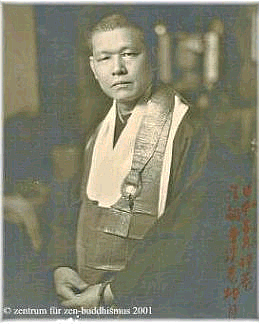
Abb.: Sokei-an [Bildquelle: ©http://www.zzbzurich.ch/zzb_wurzeln/zzb_sokeian.html
. -- Zugriff am 2003-06-21]
Im Jahre 1893 kam Zen erstmals nach Amerika in der Person von Soyen
Shaku (1859-1919). Soyen Shaku war Abt eines Zen-Klosters und sprach als
Zen-Buddhist und Zen-Meister am Weltkongress der Religionen in Chicago.
1906 sandte Soyen Shaku eine Gruppe von japanischen Laienbuddhisten mit
ihrem Lehrer Tetsudo Sokatsu nach Amerika mit dem Auftrag, ein
Zen-Zentrum für Laien aufzubauen.. Doch dieser Plan misslang. Die
Japaner kehrten in ihre Heimat zurück mit Ausnahme des Studenten
Shigetsu Sasaki, der in Tokyo viele Jahre lang Zen praktiziert hatte.
Shigetsu Sasaki blieb allein in Amerika und begann Land und Leute
kennenzulernen. Er kehrte nur zwei Mal nach Japan zurück, zuletzt, um
sein Zen-Training zu vollenden und die Meisterwürde zu empfangen. Der
Name Sokei-an, der ihm bei der Anerkennungszeremonie seiner
Zen-Meisterschaft als Roshi verliehen wurde, weist auf seine tiefe
geistige Beziehung mit dem Sechsten Patriarchen des Zen in China,
Hui-neng. Dieser lebte im 7. Jahrhundert im Tal namens Sokei. Nach
seiner Rückkehr aus Japan, fuhr Sokei-an noch einige Jahre fort, lernend
durch Amerika zu ziehen und seinen Lebensunterhalt als Holzschnitzer und
Verfasser von Satiren zu verdienen. Er besaß großes künstlerisches
Talent, sowohl in der plastischen Kunst, als auch im sprachlichen und
darstellerischen Bereich. Erst 1930 begann er in seiner kleinen Wohnung
in New York Zen zu lehren und gründete das First Zen Institute of
America.
Zu dieser Zeit war Zen in Amerika noch weitgehend unbekannt, und was man vom
Buddhismus wusste, betraf in der Regel die Richtung des Ur-Buddhismus (Theravada-Schule).
Deshalb übersetzte Sokei-an viele Texte des Zen und des späteren Mahayana-
Buddhismus selber aus dem Chinesischen ins Englische. Auf diese Weise machte
er seine amerikanischen Schüler und Schülerinnen mit dem buddhistischen
Gedankengut bekannt. Die Teilnahme an seinen Vorträgen, die zwei Mal
wöchentlich stattfanden, war für seine Schüler obligatorisch. Wer dies ein
Jahr lang getan hatte und gut im Zazen verwurzelt war, konnte anfangen, mit
einem Zen-Koan zu arbeiten. In bezog auf Koan-Arbeit war Sokei-an sehr strickt
und traditionell, d.h. es gab keine Erklärungen, keine Kompromisse und keine
persönlichen Rücksichten. Jeder Schüler und jede Schülerin musste, wie es der
Rinzai-Zen-Tradition entspricht, selber mit dieser schwierigen Aufgabe zurecht
kommen. Sokei-an's Motto lautete:
"Erkenne die wahre Essenz deiner Existenz. Das Wissen ist in dir."
Im Übrigen hielt er sich nur wenig an die überlieferten Formen. Da seine
Wohnung sehr klein war, saß man nicht auf Sitzkissen auf dem Boden, sondern
auf Stühlen. Er lehnte alles Zur-Schau-Stellen ab und lebte wenig bekannt und
auf sich selber gestellt in der Millionenstadt New York, die er sehr liebte.
Stundenlang durchwanderte er ihre Strassen und Plätze. Hier lebten seine
Schüler und Schülerinnen, mitten im oft hektischen Leben, nicht als Mönche und
Nonnen, sondern eingebettet in Beruf und Familie. Für sie wollte er lehren,
ihnen wollte er das Wesen des Zen nahe bringen, also teilte er ihre Welt so
gut es ging. Doch die Weltpolitik holte auch ihn ein. Nach der Bombardierung
von Pearl Harbor durch die Japaner (Dez. 19941) wurde er wie viele seiner in
Amerika lebenden Landsleute als potentieller Feind in ein Lager gebracht. Dort
verbrachte er zwei Jahre in Gefangenschaft, bis es seinen Schülern gelang, ihn
frei zu bekommen. Um seinen Aufenthalt in New York zu sichern, heiratete er
seine Schülerin Ruth Fuller Sasaki. Ruth Fuller Sasaki hatte selber tiefe
Erfahrung von Zen und, nach Sokei-an's Tod im Jahre 1945 arbeitete sie in
Japan und in Amerika noch Jahre lang an der Herausgabe von authentischen
Zen-Texten und führte ein Zendo für Ausländer in Kyoto. Ihr und einer anderen
Schülerin von Sokei-an, Mary Farkas, ist es zu verdanken, dass Sokei-an's
Ansprachen und Vorträge erhalten blieben. Viele von ihnen wurden von Agetsu
Wydler Haduch übersetzt und sind im Buchhandel erhältlich
Mit Dr. Henry B. Platov (1904-1990) und Mary Farkas (1912-1992) sind die
letzten zwei Schüler von Sokei-an von uns gegangen. Doch sein Geist lebt
weiter – nicht zuletzt in einer seiner ausdruckstarken Holzfiguren, die auf
dem Altar im Bodhibaum-Zendo."
[Quelle.
http://www.zzbzurich.ch/zzb_wurzeln/zzb_sokeian.html. -- Zugriff am
2003-06-21] |
"SASAKI, Shigatsu [sic!] (1882, Japan—May 17, 1945, New York
City); married Tomoko Sasaki, 1906; married Ruth Fuller Everett, 1944;
education: Imperial Academy of Art, Tokyo, Japan.
Shigatsu Sasaki, the founder of the First Zen Institute of America,
was better known as Sokei-an, a name he took from the home of the
temple of Zen Buddhism's Sixth Patriarch. During his early life in
Japan, he was an artist and, at the age of sixteen, he went to work as a
dragon carver for temples undergoing restoration. As a student at the
Imperial Academy of Art, he met Sokatsu Shaku, the student of
Imakita Kosen and Soyen Shaku. Sokatsu had been sent to Tokyo by Kosen's
successor Soyen to revive the Ryomokyo-kai, the lay movement of
Zen practitioners.
Sasaki was among a small group of Sokatsu's disciples invited to
accompany him in 1906 on a mission to spread the Ryomokyo-kai to the
United States. Just prior to their leaving for America, Sasaki married,
also at Sokatsu's request, one of the female disciples. The group
settled first in Berkeley, California (where some of Sokatsu's former
disciples were students), but soon moved to a farm near Hayward. The
failure of the farm caused a split, as Sasaki left the group when he
disagreed with Sokatsu over trying to continue the farm. The two were
reunited when the group gave up the farm and opened the Ryomokyo-kai in
San Francisco. In 1910 Sokatsu returned to Japan permanently along with
all of the group except Sokei-an and his wife.
Sokei-an wandered north on foot and finally settled in Seattle. His
marriage, never a happy one, despite the two children it produced, broke
up; his wife returned to Japan in 1914. Sokei-an soon headed east and
settled in New York City. He made his living as an artist until he
suddenly returned to Japan in 1919. He rejoined his wife and decided to
complete his Zen training. For the next decade, he traveled back and
forth between the United States and Japan and became a successful writer.
In 1928 Sokei-an completed his Zen training and returned to America
permanently. He established the Buddhist Society of America (changed
to the First Zen Institute of America in 1945). As the only Zen
master in New York, Sokei-an became the teacher of many of the popular
Zen proponents of the next generations such as Alan Watts.
The Zen Institute prospered through the 1930s; in November 1941 its
headquarters opened on East Sixty-fifth Street in New York City. At the
first meeting, Sokei-an announced to his students that after more than
ten years of spreading Buddhism in the United States, "Now I commence
the second period of my work in New York City." Unfortunately the next
month the Japanese bombed Pearl Harbor. Japanese Buddhist priests were
among the first put under surveillance. Six months later, Sokei-an was
interned for a period of more than a year (June 15, 1942-August 15,
1943).
Among Sokei-an's students was Ruth Fuller Everett, who had been
introduced to D. T. Suzuki on a trip to Japan in 1930. In 1932 she spent
three months in Nanzen-ji Monastery. In 1938 she settled in New York
City and became a staunch member of the Institute and editor of its
magazine, Cat's Yawn. After Sokei-an's internment Ruth Everett
obtained the help of George Fowler, a former student and then commander
in the navy, to assist in his release. In 1944 she married Sokei-an to
help stabilize the Institute.
Sokei-an's health suffered from the period of internment; he died in
1945 never having recovered his strength. He left to his second wife the
task of finding a replacement for him at the Institute and of completing
the translation of the Rinzai-roku (Collected Sayings of Rinzai).
She soon moved to Japan to pursue the studies that would allow her to
complete the translation work, which was all but finished at the time of
her death in 1967. Since Sokei-an's death, the Zen Institute has existed
as a lay Zen organization. It has been headed by Mary Farkas, one
of Sokei-an's students.
[Quelle: Melton, J. Gordon: Biographical dictionary of
American cult and sect leaders. -- New York : Garland Pub., 1986.
-- 354 S. ; 24 cm. -- ISBN 0824090373. -- s.v.] |
Über Mary Farkas (1911 - 1992):
"Mary Farkas, director of the First Zen Institute of
America, died on June 7th in New York City. She was eighty-one years
old and her long life embodied the transmission of Zen from Japan to
the United States. A pioneer of American Zen, Mrs. Farkas' studies
predated the Zen boom sparked by D.T. Suzuki and Allan
Watts, and Zen Notes, a newsletter that she published,
comprises an invaluable compendium of Zen activity in this country.
Her teacher Shigetsu Sasaki, later known as Sokei-an,
first arrived in the United States in 1906 and founded The First
Zen Institute in 1930. Sokei-an was in the lineage of the great
Meiji reformer Kosen (1816-1892), the abbot of the prestigious
Rinzai monastery Engaku. In a radical departure from monastic
convention, Kosen founded a lay Zen organization in Tokyo called
Ryomokyo Kai—the Association for the Abandonment of the Concepts of
Objectvity and Subjectivity. This innovative experiment to
revitalize Zen in Japan reflected Kosen's willingness to pay more
attention to the spirit of Zen than to the form. Kosen's search for
fertile new ground for Zen was continued by his student Soyen Shaku
(1859-1919), who attended the World Parliament of Religions in
Chicago in 1893. It was Soyen Shaku's students who were most
responsible for planting the earliest Zen seeds in this country:
Nyogen Senzaki, D.T. Suzuki and Sokei-an's own teacher, Sokatsu
Shaku, whose mission had once been to revive the failing spirits of
the original Ryomokyo Kai.
This was the lineage that Mrs. Farkas perpetuated through her
affiliation with the First Zen Insitute, through her commitment to
disseminating the teachings of Sokei-an, and through her publication
of Zen Notes. The Institute, located in Manhattan, has addressed the
needs of lay practitioners and has had no formal teacher in
residence since Sokei-an's death in 1945. Farkas herself had no use
for titles and only in the last year of her life allowed herself to
be called "director" rather than secretary. And yet she has left
behind many Zen students at the Institute and across the country who
refer respectfully to her style of teaching from her desk, of
teaching by asking questions about one's life, of teaching by
disallowing academic questions about dharma, and, most effectively
of all, of teaching Zen by her presence.
Not always certain about how to proceed in the task of introducing
Zen to the United States, Rick Fields reports in How the Swans Came
to the Lake (Shambhala Publications, 1986) that on a trip to Japan,
Mary Farkas asked the Zen abbot, Zuigan Goto-roshi, "Don't you think
we have made some progress in this last half-century?" He replied
encouragingly, "Yes, you could say you have taken a step.""
[Quelle: Tricycle : the Buddhist
review. -- ISSN 1055-484X. -- Vol. II, No.1 (Fall 1992). -- S.
73.] |
1932
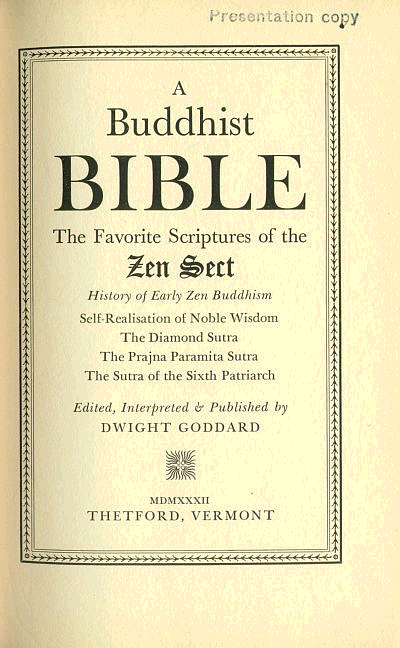
Abb.: Titelblatt
A Buddhist Bible : the favorite scriptures of the Zen sect :
History of early Zen Buddhism ; Self-realization of noble wisdom ; the Diamond
sutra ; the Prajna paramita sutra ; the Sutra of the sixth patriarch /,
edited, interpreted & published by Dwight Goddard [1861 - 1939]. --
Thetford, Vt. : D. Goddard, 1932. -- 316 p. -- Online:
http://www.hinduwebsite.com/sacredscripts/buddhist_bible.htm. -- Zugriff
am 2003-06-21]
|
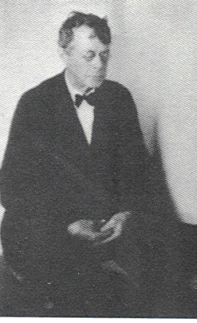
Abb.: Dwight Goddard
[Bildquelle: Fields, Rick <1942 - 1999>: How the swans came to the lake : a narrative history of
Buddhism in America. -- Rev. and updated ed. -- Boston ; London : Shambala,
1986. -- 445 S. -- ISBN 0-394-74419-5. -- Nach S. 194]
|
CONTENTS
- PREFACE
- BUDDHA
- CHAPTER ONE - SHAKYAMUNI BUDDHA
- The Life of the World-Honored One
- The Teaching of The Buddha
- CHAPTER TWO - THE ETERNAL AND GLORIFIED BUDDHA
- His Compassion and Vows
- Buddha's Relief and His Method of Relief
- The Eternal and Glorified Buddha
- CHAPTER THREE - THE FORM OF BUDDHA AND HIS VIRTUES
- Buddha's Three Bodies
- The Appearance of Buddha
- Buddha's Virtue
- TRUTH
- CHAPTER ONE - CAUSATION
- The Four Noble Truths
- Causation
- The Chain of Causation
- CHAPTER TWO - THE THEORY OF MIND-ONLY AND ACTUALITY
- Uncertainty and Egolessness
- The Fact of Mind-Only
- Ideas-Only
- Actuality
- The Middle Way
- CHAPTER THREE - BUDDHA-NATURE
- The Human Mind and the True Mind
- The Mind of Buddha
- Buddha-Nature and Egolessness
- CHAPTER FOUR - EVIL DESIRES
- Worldly Passions
- The Nature of Man
- The Life of Man
- Aspects of Human Life
- CHAPTER FIVE - THE RELIEF OFFERED BY BUDDHA
- The Relief of Buddha
- Buddha's Land of Purity
- CHAPTER SIX - THE WAY OF PURIFICATION
- Purification of Mind
- The Way of Behavior
- Teaching by Ancient Fables
- CHAPTER SEVEN - THE WAY OF PRACTICAL ATTAINMENT
- Search for Truth
- The Way of Practice
- The Way of Faith
- The Way of Concentration
- Sacred Aphorisms
- BROTHERHOOD
- CHAPTER ONE - DUTIES OF THE BROTHERHOOD
- Homeless Brothers
- Lay Members
- CHAPTER TWO - PRACTICAL GUIDE TO TRUE LIVING
- In Home and Family Life
- In the Life of Women
- In Service
- CHAPTER THREE - BUILDING A BUDDHA-LAND
- The Harmony of the Brotherhood
- Buddha's Pure Land
- Those Who Have Received Glory in Buddha's Land
|
1933
Suzuki, Daisetz Teitaro <1870-1966>: Essays in Zen Buddhism (second series).
-- London : Luzac, 1933. -- 326 S. : Ill. -- [Printed in Tokyo."Published
for the Eastern Buddhist society, Kyoto, Japan.""In this second series ... the
chief stress has been placed in the study of 'The koan exercise'."--Preface.]
1933
Robert Clifton (1903 - 1933) wird als Geistlicher der Honpa
Hongwanji Mission (heute: Buddhist Churches of America) in San Francisco
ordiniert.
"Clifton was born in Alabama in 1903- According to
Snelling, his original name was Harold Amos Eugene Newman; I have no
idea why he changed it. He was attracted to Buddhism while studying
at Columbia. In 1928 or so, he went to San Francisco and lived with
the Japanese community (Melton)—not something that many white
Americans were doing at the time—and in 1933, he was ordained as a
Pure Land/Shin priest at the Honpa Hongwanji Mission (now known as
the Buddhist Churches of America) there. A year later, he travelled
to Japan and was ordained again. He spent the rest of his life as a
sort of peripatetic Buddhist seeker-cum-practitioner. In 1951 or
1952 (I have seen both dates), he founded a Western Buddhist
Order (not to be confused with Ven. Sangharakshita's of the same
name, though Sangharakshita was an honorary member—he was living in
India at the time). Then, in 1956, he changed tack—or perhaps it
would be more accurate to say that he added another string to his
bow—and was ordained as a Theravadin monk in Thailand, taking the
name, Bhikkhu Sumangalo (Lewis, 135). Over the next few years—
though I have no firm dates—he "became convinced of Zen", after
meeting Sokei-an Sasaki in New York (Lewis, 69); and
subsequently "became a novitiate at the Soto temple at Tsurumi,
between Yokohama and Tokyo" and also "passed through . . . the
Tibetan [discipline] (kept rather secret)" (ibid.). This is quite a
journey through the traditions. And it is evident that Clifton liked
journeys: he ended his days in Malaya in 1963, "working vigorously
for Buddhism" (Snelling).
It is difficult to know what to make of Clifton's life as a
Buddhist. Someone who has practised, in some sense of the term, in
Pure Land/Shin, Theravada, Zen and Tibetan Buddhism, in America,
Japan (twice—in Pure Land and Zen), Thailand and Malaya, and has
created a Western Buddhist Order as well, is certainly a pioneer.
But whether he was a genuine universalist or just incapable of
finishing what he had started, I do not know."[Quelle. Rawlinson, Andrew <1943 - >: The
book of enlightened masters : western teachers in eastern traditions. --
Chicago : Open Court, ©1997. --
xix, 650 S. : Ill. ; 25 cm.. -- ISBN: 0812693108. -- S. 211f..] |
1934
Dwight Goddard (1861 - 1939) startet mit Followers of Buddha
ein kurzlebiges Experiment eines buddhistischen Ordens.
Dazu: Goddard, Dwight <1861-1939>: Followers of Buddha; an American
brotherhood. -- Santa Barbara, Calif. : [J. F. Rowny press], 1934. -- 35
S.
| "INTRODUCTION The plan is as follows: To have inexpensive refuges in
Vermont and California and then to have a motor-van by which some of the
Brothers can motor back and forth between the two places taking advantage
of favorable climatic conditions, teaching and explaining the Dharma to
those they meet by the way, selling Buddhist books, distributing
literature, seeking new members and wider support for the Brotherhood.
The plan has certain advantages that earlier plans have lacked. A fixed
location tends to become an "institution" with mounting expenses, routine
and a tendency to lapse into easy going ways. The plan of itinerating—of
having no abiding place—keeps the Brothers awake, active and earnest. It
was the plan that Buddha, Jesus and St. Francis followed. It presents a
life of freedom from, dependence upon, and conformity to, the conventional
life of the world. It gives opportunity for meeting many people and
awakening interest in Buddha and his way of life. It is comparatively
inexpensive, there are no salaries to be paid, no deficits to be made up,
it is friendly and peaceful, it does not antagonize anyone, and it keeps
true to the example and spirit of Buddha. ...
PRACTICAL RULES FOR THE DAILY LIFE OF THE BROTHERS
- THE FIVE PRECEPTS.
- Not to kill or be unkind to any living creatures.
- Not to cherish impure thoughts.
- Not to deceive.
- Not to take anything that does not belong to one.
- Not to partake of drugs or intoxicating drinks.
- FIVE ADDITIONAL PRECEPTS.
- To have as little to do with money and valuable things as possible.
- To live a strictly pure and celibate life.
- Not to sleep on soft beds.
- Not to use ointments and condiments. (
- Not to attend entertainments or take part in games of chance.
- THE six PARAMITAS.
- Charity and sympathy.
- Behavior to be determined by its relation to the happiness and
benefit of others.
- Humility and patience.
- Zeal and perseverence.
- Concentration and tranquility of mind.
- Wisdom.
- OBSERVANCE OF RULES. Brothers are to be cheerfully obedient to the
rules they are asked to observe and to the duties they are asked to
perform. All questions as to the meaning of the rules are to be referred
to the Director and his interpretation is final. In grave cases an
appeal may be made to the whole body of Brothers but a two-thirds vote
is necessary to reverse the Director's decision.
- HARMONY AMONG THE BROTHERS. In cases of flagrant immorality or
serious dissension among the Brothers the Director shall try to settle
the matter privately, but in case of failure, he shall summon a meeting
of all the Brothers and together they shall try to compose the
difference. If this fails, the Director shall request the recalcitrant
Brother to withdraw from the Brotherhood. If asked to go away, a Brother
shall do so promptly and without unpleasantness. If later on an
ex-Brother should have a change of heart and desire to return to the
Brotherhood his request shall be considered as in the case of a new
Brother.
- OUTSIDE INTERESTS. Brothers are not to have any outside interests,
employment or worldly friends to distract their attention and interest
from the main purpose of the Brotherhood. Worldly newspapers, magazines
and books are not to be brought onto the premises, for the same reason.
Brothers should not use their free time to relapse into worldly ways, or
concern with world affairs, or idle talk, or discussions, or joking, or
anything that tends to weaken one's mind-control and tranquillity.
Brothers are not to go away from the premises without notifying the
Director, nor are they to invite worldly friends to visit them.
- KINDNESS. Brothers are expected at all times and under all
circumstances to practice kindness toward all people and all creatures.
It is especially important that nothing shall be said or done to cause
another Brother to feel badly, or that will cause strife within the
Brotherhood, for harmony among the Brothers is of highest importance.
- FOOD. Only two meals will be served, at six and twelve. Only
vegetables, fruits, cereals, and nuts, with eggs and milk, will be
served and only in limited quantities. The meal is to be partaken of in
silence. Grace is to be said before and after the noon meal. No food is
to be eaten between meals, except tea and a slight lunch after the
evening practice of Dhyana [meditation], if there has been hard labor
during the day. Indulgence in sweets, unnecessary condiments, and coffee
is to be restrained and the use of tobacco is forbidden.
- CLOTHING. Clothing is to be simple and inexpensive and is to be used
until it is worn out. The possession of expensive, stylish and
unnecessary clothing is forbidden. The use of silk and leather is to be
avoided.
- USE OF MONEY. Brothers are to have no private money. All private
money or property is to be relinquished to relatives or friends, or
given to the Brotherhood to be used for the common good. If a Brother
needs money, he may ask for it from the treasurer who will supply what
is necessary, as far as he is able to do so.
- LABOR. Every Brother is expected to have some work assigned to him
for each morning. The work may be frequently rotated and changed, or it
may be a continuing task according to the ability of each Brother, to be
determined by the Director. At the request of the Director Brothers may
be asked to do outside work for which no money payment will be accepted.
If food or other things are offered in exchange they may be gratefully
accepted.
- GUESTS. Any man who is sincerely interested in Buddhism and who
desires instruction in it may be received as a guest for a limited time
by the approval of the Director. Such a guest is expected to observe in
a general way the rules of the Brotherhood, and to give evidence of his
sincere purpose to profit by the instruction and practice. In their
attitude toward a guest the Brothers should be very careful to reflect
the spirit of Buddha, seeking above all else to recommend the Dharma by
their own conduct. They should avoid general conversation and shall seek
to teach and to explain the Dharma to the best of their ability, always
remembering that the best gift is the gift of the Dharma. There should
be no urging upon a guest to become a Buddhist, leaving that to the
guest's own decision. All callers and friends shall be considered as
guests of the Brotherhood, and shall not be invited to private rooms or
to meals.
- LADIES. As the Brothers are trying to live a tranquil life, the
presence of ladies at the Refuge is not desired. If they call they are
to be received courteously, but they are not to be invited to call, or
to be received in private, or to eat with the Brothers, or to be present
at any of their exercises.
- DHYANA. Whatever the Brothers may be doing, or wherever they may be,
they should always arrange the day so as to include some time for the
quiet practice of Dhyana.
- THE DAY'S DUTIES:
4:30—Rising bell.
4:45-6:45—Practice of Dhyana.
7:00—Breakfast.
7:30-11-30—Labor.
12:00—Dinner.
12:30-2:00—Free time.
2:00-4:00—Practice of Mindfulness.
4:00-5:00—Free time.
5:00-7:00—Practice of Dhyana.
7:00—Light lunch and free time.
9:00—Lights out."
[Zitat in:
Asian religions in America : a documentary history / edited by
Thomas A. Tweed, Stephen Prothero. -- New York : Oxford University Press,
©1999. -- 416 S. : Ill. -- ISBN
0-19-511339-X. -- S. 193 - 196] |
1935
Miriam Salanave, die 1929 all ihren Besitz verkauft hatte, um nach
Japan gehen zu können, um Zen zu üben, gründet in San Francisco das Western
Women's Buddhist Bureau und die East-West Buddhist Mission.
1935
Der König von Siam (heute Thailand) schenkt der Buddhist Mission of North
America (heute: Buddhist Churches of America) Buddha-Reliquien. Diese
befinden sich heute in einem Stupa auf dem Dach der Buddhist Church of San
Francisco.
1936
Julius Goldwater (1908 - ) wird in Kyoto zum
Jodo-Shinshu-Geistlichen ordiniert.
1938
Suzuki, Daisetz Teitaro <1870-1966>: Zen Buddhism and its
influence on Japanese culture, -- Kyoto : The Eastern Buddhist society,
1938. -- 288 S.
1939
Daisetz Teitaro Suzuki (1870-1966) besucht Hawaii
1940 - 1941
Es erscheinen 13 Nummern der Zeitschrift
Cat's yawn / The Buddhist Society of America
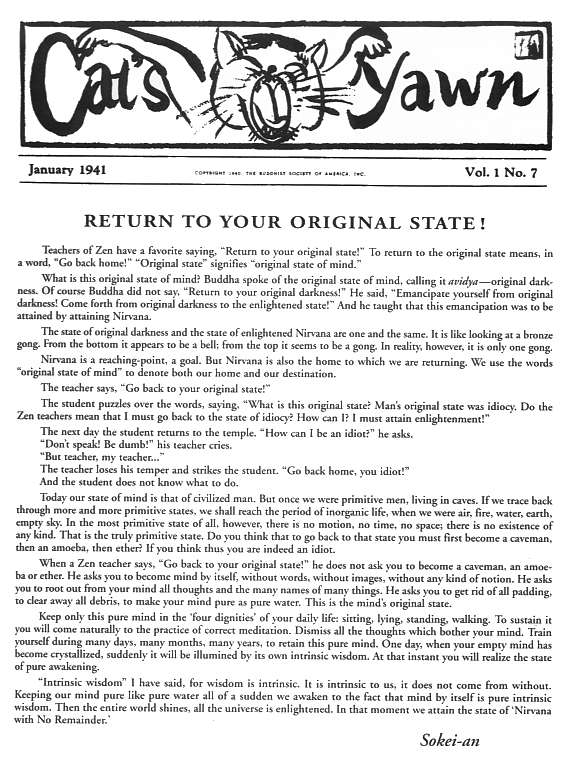
Abb.: Cat's Yawn, No. 7, 1941
[Bildquelle: Tricycle : the Buddhist
review. -- ISSN 1055-484X. -- Vol. VI, No.4 (Summer 1997). -- S.
13.]
1941-12-07

Abb.: Eines der zerstörten US-Schlachtschiffe in Pearl Harbour
Japanischer Angriff auf Pearl Harbour (Hawaii). Die USA erklären Japan
den Krieg. Aufgrund des deutsch-japanischen Beistandspaktes erklärt Deutschland
den USA den Krieg.
1942-12-19
Mit Executive Order 9066 autorisiert Präsident Franklin D. Roosevelt die
Internierung von US-Japanern. Fast alle buddhistischen US-Japaner werden
interniert. Viele japanstämmige Buddhisten hören auf, öffentlich zu
praktizieren, da sie befürchten, als anti-amerikanisch gebrandmarkt zu werden.
Andere konvertieren zum Christentum, um ihren amerikanischen Patriotismus zu
demonstrieren.
1944-04-28/30
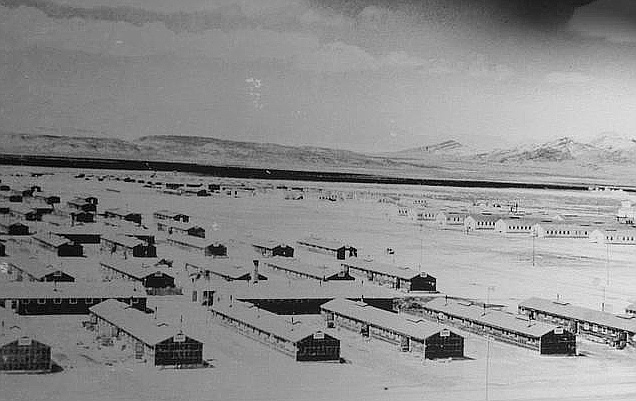
Abb.: Topaz Internment Camp
[Bildquelle:
http://www.orneveien.org/adventure/2002topaz/34.htm. -- Zugriff am
2005-04-28]
Um die Loyalität gegenüber den USA zu betonen ändern Funktionäre der Buddhist
Mission of North America im Topaz Internment Camp in Utah den Namen um in
Buddhist Churches of America (BCA) [Webpräsenz:
http://www.buddhistchurchesofamerica.com/. -- Zugriff am 2005-04-28]
|

Abb.: Logo®
"The Buddhist Churches of America (BCA) is an incorporated religious
organization of American Shin Buddhist affiliated with the Jodo Shinshu
Hongwanji-ha Hongwanji denomination within the Continental United States.
The BCA is governed by Americans of the Shin Buddhist faith through a
Board of Directors comprised of the Bishop, the Board President, the
Miniterial Association Chairperson, district-elected Board members,
Board members-at-large and representatives from the recognized
BCA-affiliated organization.
The American Shin Buddhists within the State of Hawaii have a separate
jurisdiction and administration because of the historical separation at
the time of its founding since the Kingdom of Hawaii was not a part of
the Unites States. The Jodo Shinshu Hongwanji-ha denomination is
organized as the Honpa Hongwanji Mission of Hawaii, headquartered at
1727 Pali Highway, Honolulu, Hawaii 96813.
The Buddhist Churches of America national headquarters serves as a
regional center of the World Fellowship of Buddhists and is a supporting
member of the World Conference on Religion and Peace (WCRP). "
[Quelle:
http://www.buddhistchurchesofamerica.com/aboutus/index.php?aid=3. --
Zugriff am 2005-04-28] |
1945-08-06/08
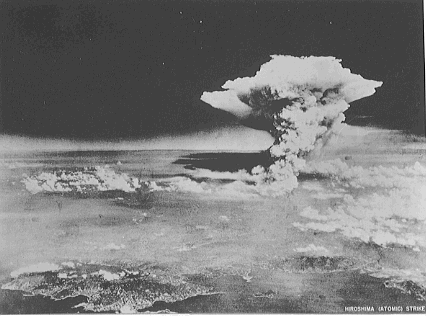
Abb.: Atombombe auf Hiroshima
Die USA erzwingen mit den Atombombenabwürfen über Hiroshima und Nagasaki die
Kapitulation Japans.
1949
Gründung des mit dem Shin-Buddhismus verbundenen Buddhist Study Center,
heute Institute of Buddhist
Studies in Berkeley
Webpräsenz:
http://www.shin-ibs.edu/. -- Zugriff am 2005-04-28
| "The beginnings of the Institute
of Buddhist Studies can be found in the early history of the Buddhist
Churches of America (BCA) which is affiliated with the Honpa-Hongwanji
branch of Jodo Shinshu Buddhism, a Japanese Pure Land School. In 1930,
under Bishop Kenju Masuyama, the initial training program and a resident
center for English-speaking ministers were established in Kyoto, Japan.
An educational program of lectures and correspondence courses began in
the mid-1930s and operated out of BCA headquarters in San Francisco. As
the need for English-speaking ministers increased after World War II,
Bishop Enryo Shigefuji established a monthly study class at the home of
Mrs. Shinobu Matsuura in 1948. The program was open to any person
interested in Buddhism; however, its main purpose was to prepare
ministerial aspirants for the rigors of study in Japan. In 1949, the
program was moved to the Berkeley Buddhist Temple at 2121 Channing Way,
where it became known as the Buddhist Study Center. It was placed under
the guidance of Reverend Kanmo Imamura, then resident minister. In 1958,
the Buddhist Churches of America resolved to establish a ministerial
training center in the United States where all instruction would be
conducted in English (until then all ministerial candidates were trained
in Japan). Reverend Imamura was appointed to establish such a program at
the Buddhist Study Center. Reverend Masami Fujitani took over the
directorship soon afterward and developed the educational program
(1958-1963); Reverend Imamura then returned to serve a second term
(1963-1967).
In October 1966, the BCA acquired a building at 2717 Haste Street,
Berkeley, which was the home of the Institute of Buddhist Studies for
twenty-two years prior to moving to its second location at 1900 Addison
Street in Berkeley. Bishop Shinsho Hanayama (Professor Emeritus, Tokyo
University) and Bishop Kenryu Tsuji played vital roles in the early
stages at the Haste Street campus. Reverend Haruyoshi Kusada served as
IBS Executive Director from 1968 to 1983, laying the educational
foundation for graduate studies. In 1986, Dr. Alfred Bloom, a noted Shin
Buddhist scholar, was appointed Dean and Head Professor after serving
twenty-six years on the faculty at the University of Hawaii and the
University of Oregon. Dr. Bloom retired in 1994, and Dr. Richard K.
Payne was appointed to the position of Dean. The Institute of Buddhist
Studies is licensed by the State of California to operate as a
degree-granting institution.
In February, 1985, under the guidance of Bishop Seigen Yamaoka, the
Institute of Buddhist Studies became an affiliate of the Graduate Theological Union,
a unique consortium of religious institutions following Jewish and
Christian traditions. Headquartered in Berkeley, California, the
Graduate Theological Union (GTU) includes three Roman Catholic and six
Protestant seminaries, along with several other affiliates and programs.
The GTU is an umbrella organization which coordinates one of the largest
concentrations of theological education resources in the world, as well
as operating a doctoral program. The GTU is accredited by the Western
Association of Schools and Colleges and the Association of Theological
Schools.
Through the GTU affiliation, the Institute of Buddhist Studies
jointly grants a fully-accredited Master of Arts (Buddhist Studies)
degree. Students in the GTU-IBS program take approximately one-third of
their courses at the various seminaries and centers of the Graduate
Theological Union and also enjoy cross registration privileges with the
University of California, Berkeley. IBS students have access to the
libraries of the Graduate Theological
Union and the University of California, Berkeley (UCB). By special arrangement,
they may take courses for credit at GTU or UCB. In return, the students
from these two institutions may take courses for credit at the IBS.
Chronology
1930s -training program for English-speaking ministers is established
in Kyoto; North American Buddhist Mission begins an educational program
and correspondence course in San Francisco
1948 - study class begins in Berkeley for English-speaking
ministerial aspirants
1949 - Buddhist Study Center is established at the Berkeley Buddhist
Temple
1958 - BSC becomes the official ministerial training center for BCA
1964 - Institute of Buddhist Studies is incorporated as a graduate
school
1966 - IBS moves to 2717 Haste Street in Berkeley
1985 - IBS becomes an affiliate of the Graduate Theological Union
1988 - IBS moves to 1900 Addison Street in Berkeley
1997 - IBS Administrative Offices moves to Mountain View
[Quelle:
http://www.shin-ibs.edu/intro6.htm. -- Zugriff am 2005-04-28] |
| "The Graduate Theological Union
has been in the frontline of religious collaboration since 1962.
Acclaimed as "the consortium that really works," the GTU's success is
represented in the uniqueness of its program initiatives and the
vitality of its environment where students and faculty from different
religious backgrounds learn and work together. The consortium consists
of nine schools of theology representing the Roman Catholic and
Protestant traditions, centers of Jewish, Buddhist, and Orthodox studies,
and five research centers and affiliates. The GTU works collaboratively
with the University of California, Berkeley, and is the home of the
Flora Lamson Hewlett Library, one of the most comprehensive theological
libraries in the country.
The mission of the GTU is to:
- Educate men and women for vocations of ministry and scholarship
- Equip leaders for a future of diverse religions and cultures
- Teach patterns of faith which nurture justice and peace
- Serve as an educational and theological resource for local
communities, the nation, and the world.
Degrees Offered Ph.D., Th.D., and M.A. degrees; other
professional degree programs (including D.Min., S.T.M., Th.M., M.Div.)
as administered by member schools
Enrollment 1,300 graduate students, with more than 350
enrolled in GTU doctoral or common master's programs
Faculty Over 150 full-time faculty across the consortium
Flora Lamson Hewlett Library More than 365,000 volumes, 2,500
periodical subscriptions, 222,000 non-book holdings
Board of Trustees 45 members, including 18 institutional
representatives, 24 members-at-large, and faculty, student, and alumni
representatives
Accreditation The GTU is fully accredited by the Association of Theological Schools
and the Western Association of Schools
and Colleges.
Member Schools
- American Baptist Seminary of the
West - American Baptist Church, USA
- Church Divinity School of the
Pacific - Episcopal Church
- Dominican School of Philosophy &
Theology - Roman Catholic Church
- Franciscan School of Theology - Roman Catholic Church
- Jesuit School of Theology at
Berkeley - Roman Catholic Church
- Pacific Lutheran Theological
Seminary - Evangelical Lutheran Church in America
- Pacific School of Religion - Interdenominational
- San Francisco Theological
Seminary - Presbyterian Church (USA)
- Starr King School for the
Ministry - Unitarian Universalist
Affiliated Centers, Institutes, and Programs
- Center for the Study of Religion
and Culture
- Richard S. Dinner Center for Jewish
Studies
- Center for the Arts, Religion, and
Education
- Center for Theology and the
Natural Sciences
- Institute of Buddhist Studies
- New College
Berkeley
- Patriarch Athenagoras
Orthodox Institute
- School of Applied Theology
[Quelle:
http://www.gtu.edu/page.php?nav=11. -- Zugriff am 2005-04-28] |
| "A Brief History of The GTU
During the latter half of the nineteenth century, several Protestant
denominations and Catholic orders successfully established theological
seminaries in the San Francisco Bay Area.
By the 1930's, several Protestant seminaries had relocated to
Berkeley, drawn by the proximity of the University of California and the
availability of its vast educational resources. In the early years, the
University and the seminaries would open classes to students of other
schools, list courses in the several catalogs, and share library
resources. With time, and the growth of all the schools, this level of
cooperation fell, each denominational seminary becoming more isolated,
understanding themselves to have adequate resources to train their own
students for specific denominational ministry and careers in religious
work.
With the post-World War II period, however, came a rise in ecumenical
sensitivities and cooperation. The war had brought devastation,
displacement of populations, and disruption of church organizations in
Europe. The global church community responded with the formation of the
World Council of Churches (begun prior to the war, but not completed
until after) in the Protestant tradition, and the Vatican II Council in
the Catholic tradition, 1962-65. The understanding of theological
education, too, began to shift away from denominational isolation to a
more ecumenical approach. Seminaries began to understand the advantages
of working in cooperation to strengthen curricula and advanced degree
programs. Consortia of seminaries began to form in major cities
throughout the United States during the 1960's.
In this atmosphere, negotiations to form a cooperative degree program
began among the Protestant seminaries in Berkeley, and the San Francisco
Bay Area, around 1958. The ad hoc committee consisted of representatives
from the Berkeley Baptist Divinity School (now American Baptist Seminary
of the West), Church Divinity School of the Pacific (Episcopal), Pacific
Lutheran Theological Seminary, San Francisco Theological Seminary (Presbyterian),
and Pacific School of Religion (Interdenominational). Agreement among
four of the schools was achieved, and the Articles of Incorporation
forming the Graduate Theological Union were signed in 1962. The Pacific
School of Religion chose not to enter the GTU until 1964. In that same
year, the Starr King School for the Ministry (Unitarian) also joined.
There followed a period of excitement and expansion as the fledgling GTU
sought to define its identity, its programs, curriculum, policies,
student body, every facet of an educational institution.
The first Catholic school was admitted in 1964, St. Albert's College
(now Dominican School of Philosophy and Theology), relocating from
Oakland, California. They were followed in 1966 by Alma College which
relocated from Los Gatos, California and was renamed the Jesuit School
of Theology at Berkeley; and the Franciscan School of Theology moved up
from Mission Santa Barbara in 1968.
The first affiliated centers of the GTU were established 1968-70: the
Center for Judaic Studies (now the Richard S. Dinner Center for Jewish
Studies) and the Center for Urban Black Studies. In the decades to
follow, the GTU affiliated institutes, centers and programs have grown
to eight including the Center for Theology and the Natural Sciences, the
Patriarch Athenagoras Orthodox Institute, and the Institute of Buddhist
Studies.
The nine member schools originally maintained their own libraries. In
1964, the Bibliographical Center was formed to consolidate collections
and centralize book ordering and cataloging. In 1969, the GTU Common
Library was established. The individual collections were merged and
housed in the basement of a member school. A major project of the GTU
during the 1970's was the planning and construction of a building to
house the library and the GTU administrative offices. Constructed in two
phases, the library was completed in 1987. The Flora Lamson Hewlett
Library is now one of the major theological libraries in the country.
The GTU was initially created by the participating schools to offer a
stronger graduate degree program than any one could offer alone. By
1971, the GTU was itself fully accredited by the Association of
Theological Schools (ATS), and the Western Association of Schools and
Colleges (WASC).
First offering only a doctorate in Theology, the GTU now offers the Ph.D.,
Th.D., and M.A. There are two joint Ph.D. programs with the University
of California at Berkeley in Near Eastern Studies and Jewish Studies.
The original four areas of study—Bible, history, theology, and ethics—were
broadened to include the arts, the personality sciences, phenomenology
of religions, spirituality, and inter-area studies. The combined
faculties of the member schools, numbering 150, serve a total student
body of 1,300.
The Graduate Theological Union remains committed to the spirit of
ecumenism in which it was formed. Rich in resources and rich in spirit,
the GTU seeks to educate women and men for vocations of ministry and
scholarship, equip leaders for a future of diverse religions and
cultures, teach patterns of faith which nurture justice and peace, and
serve as an educational and theological resource for local communities,
the nation, and the world.
Prepared by
Lucinda Glenn,
GTU Archivist"
[Quelle:
http://www.gtu.edu/page.php?nav=13. -- Zugriff am 2005-04-28] |
1951 - 1957
Daisetz Teitaro Suzuki (1870-1966) lebt in New York und hält
Seminare an der Columbia University. Zu seinen Schülern gehören: Philip Kapleau
(1912 - 2004),
Erich Fromm, John Cage, Allen Ginsberg, Jack Kerouac
1952-07-20
US Congress verabschiedet McCarran-Walter Act als neues
Immigrationsgesetz mit einer Quotenregelun. Die jährliche Quote für Asiaten wird
per Erlass mit 2.990
festgesetzt, gegenüber einer Quote von 149.667 für Europäer.
1952-08-29
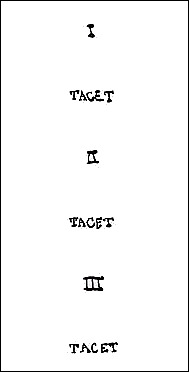
Abb.: Partitur [Bildquelle:
http://www.toutfait.com/issues/issue_2/Articles/anastasi.html. -- Zugriff
am 2003-06-22]
Uraufführung von 4'33'' [4 Minuten, 33 Sekunden] von John Cage (1912
- 1992), eine Zen-inspirierte "Komposition" des Schweigens, durch den
Pianisten David Tudor in Woodstock, New York. John Cage hatte 1949 bis 1951
an D. T. Suzuki's Unterricht an der Columbia University teilgenommen.

Quelle der midi-Datei:
http://interglacial.com/~sburke/stuff/cage_433.html. -- Zugriff am
2005-04-28
Wenn Sie NICHTS hören, hören Sie richtig!
"I have nothing to say / and I am saying it / and that is poetry / as I needed it"
-- John Cage
| "Brief Description and the Historic First Performance "Good
people of Woodstock, let's run these people out of town" (artist at the
premiere performance of 4'33") 1.
The first performance of John Cage's 4'33" created a scandal.
Written in 1952, it is Cage's most notorious composition, his so-called "silent
piece". The piece consists of four minutes and thirty-three seconds in
which the performer plays nothing. At the premiere some listeners were
unaware that they had heard anything at all. It was first performed by the
young pianist David Tudor at Woodstock, New York, on August 29, 1952, for
an audience supporting the Benefit Artists Welfare Fund -- an audience
that supported contemporary art.
Tudor placed the hand-written score, which was in conventional notation
with blank measures, on the piano and sat motionless as he used a
stopwatch to measure the time of each movement. The score indicated three
silent movements, each of a different length, but when added together
totalled four minutes and thirty-three seconds. Tudor signaled its
commencement by lowering the keyboard lid of the piano. The sound of the
wind in the trees entered the first movement. After thirty seconds of no
action, he raised the lid to signal the end of the first movement. It was
then lowered for the second movement, during which raindrops pattered on
the roof. The score was in several pages, so he turned the pages as time
passed, yet playing nothing at all. The keyboard lid was raised and
lowered again for the final movement, during which the audience whispered
and muttered. 2
Cage said, "People began whispering to
one another, and some people began to walk
out. They didn't laugh -- they were just irritated when they realized
nothing was going to happen, and they haven't fogotten it 30 years later:
they're still angry." 3 Maverick Concert Hall, the site
of the first performance, was ideal in allowing the sounds of the
environment to enter, because the back of the hall was open to the
surrounding forest. When Tudor finished, raising the keyboard lid and
himself from the piano, the audience burst into an uproar -- "infuriated
and dismayed," according to the reports.4 Even in the midst of
an avant garde concert attended by modern artists, 4'33" was
considered "going too far"5.
Note that 4'33" is incorrectly listed as "4 pieces" on the
printed program. It is easy to see how the original list of timings,
listed under the heading 4'33", would have been confused by someone
who typed the program as being four pieces with their timings as titles.
Nevertheless, the timings of the movements are a crucial record."
[Solomon, Larry J.: The Sounds of Silence : John Cage and 4'33".
-- ©1998. -- URL:
http://www.azstarnet.com/~solo/4min33se.htm. -- Zugriff am 2003-06-22] |
1954
Die Buddhist Churches of America führen folgende Awards für Boy Scouts
und Camp Fire Girls ein:
Sangha Award for Boy Scouts of America
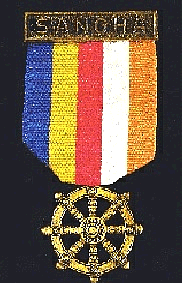
Abb.: Sangha Award
Dharma Award
Karuna Award for Camp Fire Boys and Girls
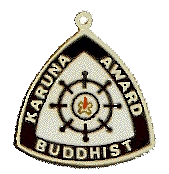
Abb.: Karuna Award
Daneben gibt es inzwischen noch:
Metta Religious Emblem
for Cub Scouts of America
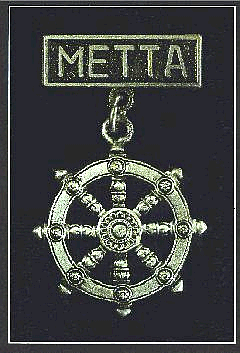
Abb.: Metta Emblem
Padma Award for Girl Scouts of America
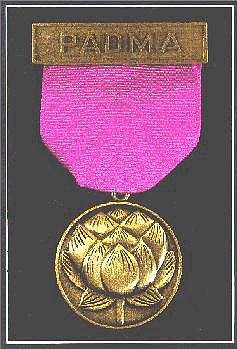
Abb.: Padma Award
Einzelheiten siehe:
http://www.eagnet.com/edipage/areaserv/nbcs/Home.htm. -- Zugriff am
2005-06-21
1954
Elson B. Snow (1925 - ), ein Drucker mit High School Abschluss,
konvertiert zu den Buddhist Churches of America. Er schreibt 1994 über seine
Motive:
"One favorite philosopher for adolescents and post-adolescents,
I believe, is Arthur Schopenhauer, and I'm sure that it was his
essays that made it easy for me to enter the gate of Buddhism. I
have always thought it strange that the label "pessimism" was often
placed on his ideas—the teaching that sorrow is rampant in the world
is the experience I thought about in my own struggle to become an
adult and the loosening of restraints. I had the romantic idea,
also, to be uprooted, which I enacted as a transient printer.
Contrary to the belief of many Japanese American friends, I have
never consciously turned to Buddhism as a reaction to the Dogmas of
Christianity. Buddhism came to me at the right time convincing me
that there is no soul problem, and as for things like Resurrection
and other marvelous events there seemed to me no approach to them in
Christianity other than that they are "mysteries." Naive, or not,
doctrinal beliefs in Buddhism for me were no barrier. ...
Why Jodo Shinshu? Right from the very first I was attracted by:
- anatman theory;
- bhakti-type religion; I later learned that this designation
is considered doctrinally incorrect;
- The Absolute Other, which I have always felt to be unique in
world religions, and that the tariki (other-power) aspect is
comparable only to the Taoist; and,
- the radical ethics of Shinran Shonin.
Of course, I admit of having primitive views at this stage of
religious development, and would not argue with anyone who says I
had arrived for wrong reasons! In any case, I was lucky that
the residential minister Reverend Kobara was very doctrinal in
approach, and the fact of the lack of Buddhist material in English
made it imperative to read everything about Buddhism outside Jodo
Shinshu and the Pure Land tradition. I was also cautious from the
very beginning to refrain from pushing my political views in this
new religious context which I enthusiastically found by a series of
accidents [or, was it ripened karma similar to Calvinism?]. My
liberal views were easily submerged in this environment, but it did
not prevent me from voicing disapproval from time to time of the
hesitancy to take a stand on social issues. This posture is a very
difficult problem to unravel in the BCA. First of all, it is hardly
likely in the foreseeable future that the BCA will come to terms
with the conflict of "church and state" and its related matters as
long as its members see themselves as not yet an assimilated group
in mainstream america (is this buzz word correct?). It is my
criticism that some of our Reverends in spite of a vigorous denial
see ourselves as a small sect and not as representatives of a great
tradition like Mahayana.
Although I volunteered a week or two of "hard labor" at the
construction of the Buddhist temple in China Town, and attended
lectures of other Buddhist sects, I have never veered far from the
temple organization of the BCA, and never gave much thought to
crossing over to a tradition other than the Hongwanji transmission
of Jodo Shinshu. . . .
I could have been comfortable in a Shingon, a Nichiren (not
sogagakkai), or a Zen setting (in the Japanese community only) as it
would have satisfied my need for ritual-imagery and for activism—but
the doctrine of the "total-other with its radical ethical posture"
is an ingredient that makes religious experience a possibility for
me. I also could not see playing the role of a vegetarian and a
quiet sitter on the week-end. The tension between the secular and
the sacred is too strong for half-involvement, and the householder
status seemed to me to be the only option in the ultimate sense of
spiritual participation. And then, of course, there is the
conviction that comes from faith, "feeling we could do nothing else"
known in Shin Buddhism as the shinjin experience, or, "the awakening
of faith."
There are two topics that have never appealed to me but I always had
to admit them as valuable avenues of inquiry, and perhaps should
never be left out in the real business of discussing personal
religion and commitment:
- Why are you a Buddhist, or have become one?
- How can we adapt Buddhism to America?
Both these questions are asked with frequency. Perhaps after
there has been a legitimate development of maturation and
assimilation, the question will be asked with less frequency. I
think that the questions should be stated differently somehow
including references to descriptions of individual and institutional
conditions already present. Something like, "what is your commitment
and present role in the Buddhist community, and what spiritual goals
would you like to set for yourself—and what obstacles are there
which prevent you from realizing them?"
It is certain that there have been many influences on me within the
community of Jodo Shin Buddhists, and I would not want to try to
sort them out for fear of unintentionally devaluating the most
important of them. The Academic influence must be given to Professor
Ryosetsu Fujiwara whose lectures on Shin doctrine I paid close
attention and appreciated them. The Sanskrit courses from Reverend
M. Fujitani at least gave me a taste for the broad interest in
Mahayana Buddhism, and much later I was able to attend classes in
reading Chinese texts at the IBS on Haste Street that have proven
very valuable. My earlier study "on the hill of San Francisco"
(College of the Pacific) was confined to conversational Japanese
which did not take me very far, but it had a cultural impact. I
reflect on this past with some sadness as there were not widely
available good sources for the study of Buddhism, unless one had
plenty of time, money, and ambition to study. In my opinion popular
Buddhism at the time was disastrous because we could only acquire
pop psychology and watered down Zen. There were the hippie movement,
and flower children later on that added color and a possible spur
for religious imagination, but the drug and sex coloration of the
vagabond mentality, I felt, was artificially drawn. . . .
My family history does not lend itself to an established religion,
and I see little in it that would promote a stability in religious
belief, except a healthy attitude of acceptance, whenever the
opportunity psychologically presents itself which would fit a
life-time mood and perspective for individual liberation by
spiritual means. My mother was tolerant of my beliefs, but my
agnostic father thought it odd to accept a Japanese religion, "giving
up one's heritage!"
I do not think my account here is of any use, nor do I feel that
such an attempt could possibly be truthful; it seems apparent that
we are always pasting our present attitudes to events and
anticipations occurring years ago. Today, I am an enthusiastic
admirer of Rennyo Shonin, whose career ended 500 years ago. The
usual reason for admiring him is an interest in the historical
institution, but my fondness for him lies in his personality as a
charismatic leader whose orientation is one for the ideal layman in
a chaotic world of unease and unrest.
My own status as a "convert" I share with most hakujin Buddhists who
feel that we have not been converted at all, but that the Buddha and
his followers has verified the truths we already know. . . .
. . . In gratitude to the light and life of tathagata amitabha
gassho, Elson November 10, 1994"
[Quelle: Asian religions in America : a documentary history / edited by
Thomas A. Tweed, Stephen Prothero. -- New York : Oxford University Press,
©1999. -- 416 S. : Ill. -- ISBN
0-19-511339-X. -- S. 206 - 208] |
1956
Cornelius Crane (Crane Bathroom Fixtures) gründet The Zen Studies Society
in New York City
Webpräsenz:
http://www.daibosatsu.org/. -- Zugriff am 2005-06-07
| "The Zen Studies Society was established in 1956 to assist the Buddhist
scholar D.T. Suzuki in his efforts to introduce Zen to the West. In 1965, it
came under the leadership of a Japanese Zen monk, Eido Tai Shimano, who
shifted the emphasis towards zazen (Zen meditation) practice. With his
dedicated energy, and the help of many dharma friends and supporters, two
centers for Zen practice came into being-- New York Zendo Shobo-Ji, on the
Upper East Side of Manhattan, and Dai Bosatsu Zendo Kongo-Ji, deep in the
Catskill Mountains of upstate New York. In 1972, Eido Shimano Roshi received dharma transmission from Soen Nakagawa
Roshi, and today serves as the abbot and spiritual teacher of these two
zendos in the Japanese Rinzai Zen tradition."
[Quelle:
http://www.daibosatsu.org/. -- Zugriff am 2005-06-07] |
1956 - 1968
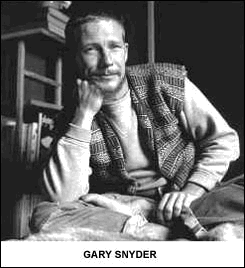
Abb.: Gary Snyder
[Bildquelle:
http://www.rooknet.com/beatpage/gallery/gallery_2.html. -- Zugriff am
2005-05-07]
Gary Snyder (1930 - ) verbringt die meiste Zeit in Japan und
studiert Zen im Shokoku-ji und dann im Daitoku-ji Kloster in Kyoto
1957
Es erscheint.
Watts, Alan <1915-1973>: The way of Zen. -- [New York] : Pantheon,
[1957]. -- 236 S. : Ill.
Im Vorwort schreibt Watts
| "I cannot represent myself as a Zenist, or even as a Buddhist, for this
seems to me to be like trying to wrap up and label the sky. I cannot represent
myself as a scientifically objective academician, for---with respect to
Zen---this seems to me to be like studying bird-songs in a collection of stuffed
nightingales. I claim no rights to speak of Zen. I claim only the pleasure of
having studied its literature and observed its art forms since I was hardly more
than a boy, and of having had the delight of informal association with a number
of Japanese and Chinese travelers of the same trackless way." |
Zu Alan Watts siehe u.a.:
http://www.alanwatts.com. -- Zugriff am 2005-04-28
1957
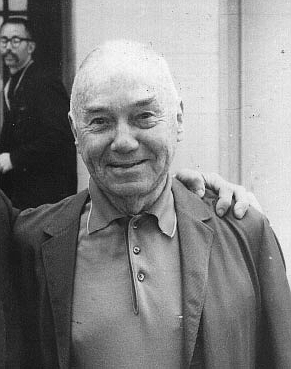
Abb.: Paul Reps
[Bildvorlage:
http://www.sonic.net/fatima/oldphotos1/somefavorites.htm. -- Zugriff am
2005-06-10]
Es erscheint:
Reps, Paul <1895 - 1990 > <Kompilator>: Zen flesh, Zen bones; a
collection of Zen & pre-Zen writings. -- Tokyo, Rutland, Vt., C.E.
Tuttle Co., [1957] -- 211 S. : Ill. ; 20 cm.
"Paul Reps was born in Cedar City, Iowa
on September 15,
1895. A man that always felt there were too many words used to describe
anything he was a master of minimalist haiku, Zen Buddhism, and swift sumi-e
brush painting. Reps can truly be called the father of Buddhism and haiku in
America. He never was caught up in tradition, breaking all that are now
considered the haiku rules and, although he respected his teachers, he forged
new paths. Always, in his wide travels, Paul was accompanied by his humor, wit
and independent spirit. As Paul would say, “If not fun, leave undone.”
Way before any other western haiku poets, Paul was the harbinger of modern haiku.
As a youth in the early 1900’s, Reps traveled to the orient where he studied
haiku, Zen and eastern art with many teachers which made an impression on his
writing and style but he adapted haiku to his own interpretation. Paul never
used the syllabic constraints and rarely abided by seasonal words that were the
then rules of eastern haiku. He created his own form of haiku, minimal and
without punctuation except for the occasional dash or exclamation point which
were frequently illustrated with his sumi-e brush painting. His first book,
More Power To You – Poems That Everyone Can Make, was published in 1939.
From 1957 through the sixties he put on shows wherever he roamed; India, Japan,
New Zealand, Norway, Australia, Mexico, USA, Greece and probably many other
planetary sites.
Reps rarely settled in one place too long. A sort of haiku hobo, he wandered the
world far and wide and felt and viewed the whole earth as his home. Everywhere
he traveled, he made, found, or had friends who took him in and cared for him.
At one of his gallery showings, he hung his haiku, like laundry, on bamboo poles
with lines strung across the room. He placed a fan where it would make the
scraps of paper flutter in the breeze. He sold the haiku to the attendees; there
was a sign that read, 1,000 yen to automobile owners, 500 yen to well dressed
persons, 200 yen to students, 100 yen to anyone poor, 10 yen to lovers of
Buddha. These “weightless gifts” as he called them were given away to his
friends. His shows frequently included sound effects, and of course, his brush
paintings, frequently done on the spot, to replace the haiku he sold. Because
Chinese and Japanese letters are in themselves word pictures, Paul tried to
bridge the gap in his haiku with his brush painting calligraphy; it is ingenious
and solves the problem neatly. Paul felt that these ink patterns offered another
wider dimension to the haiku it illustrated but it was the words, themselves,
that he believed were the most important. Some of his haiku consist of just one,
two or three words, succinct and pointed.
As an artist myself, I can relate to Paul’s attitude that each and every piece
he created was for ONE individual, who would recognize it when seen. No other
haiku poet received as much acclaim or media attention from the mass audience as
Paul Reps. He
was his own best advertisement. His popularity among readers is evidenced by the
many times his books have been reprinted.
Original American haiku is what Paul is noted for but he was also an ecologist,
and participated in the anti-establishment movements in the sixties as an
example of peaceful singularity. His Zen attitude and introduction of Buddhism
affected many of his admirers in the peace movement.
Late in his life, his appearance, as described by a friend, was one of a wise,
old elf with a spark in his eye and a spring in his step. He loved to sit and
tell tales of his many travels to any and all that were privileged to listen.
Joel and Michelle Levey, in their book, Living in Balance, tell of the
time Joel met with Paul and how he got to telling about a trip to Korea during
the beginnings of the Korean Conflict:
“In the early ‘50s, Reps, who was in his forties, had traveled to Japan en route
to visit a respected Zen master in Korea. He went to the passport office to
apply for his visa and was politely informed that his request was denied due to
the conflict that had just broken out. Reps walked away, and sat down quietly in
the waiting area. He reached into his bag, pulled out his thermos and poured a
cup of tea. Finishing his tea he pulled out a brush and paper upon which he
wrote a picture poem. The clerk read the poem and it brought tears to his eyes.
He smiled, bowed with respect, and stamped Reps’ passport for passage to Korea.
Reps’ Haiku read: 'drinking a bowl of green tea I stop the war.'"
The last ten years of his life were spent in Kamuela, Hawaii, enjoying the
beauty, weather, and friendships in that tropical spot on his beloved planet.
Before his death, he lay unconscious for several days with his hands folded
across his chest, each finger touching the opposite finger of the other hand in
classic mudra. A nurse that cared for him exclaimed, "What is he doing?" Of
course, this is the classic yogic posture of the oneness of the universe. It
seems even in his unconsciousness, Paul was still very aware. He died on July
12, 1990 at age 94 in Los Angeles, peacefully, I am sure.
Paul used to say, “I thank you for your life” to those he came into contact
with. Paul introduced me to haiku with his publications of Zen Flesh Zen
Bones and Zen Telegrams, oh so many years ago, and I thank him for
his life.
Paul felt that his haiku were not separate but one long poem."[Quelle:
buddhabitch. -- http://64.233.183.104/search?q=cache:OXArtDGpFm8J:www.litkicks.com/BeatPages/
page.jsp%3Fwhat%3DPaulReps+%22paul+reps%22+1895&hl=de. --
Zugriff am 2005-06-10]
|
1958
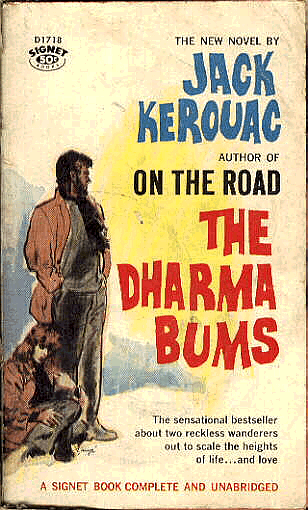
Abb.: Einbandtitel
Jack Kerouac (1922 - 1969): The Dharma Bums
1958
Daisetz Teitaro Suzuki (1870-1966) in einem Interview in
Harvard:
| Hisamatsu: Among the many people you've met or heard of [in the West]
is there anyone who you think has some understanding of Zen? Suzuki: No
one. Not yet anyway.
Hisamatsu: I see. Not yet. Well then, is there at least someone you
have hope for?
(Laughter)
Suzuki: No. Not even that.
Hisamatsu: So, of the many people (in the West) who have written about
Zen there aren't any who understand it?
Suzuki: That's right.
Hisamatsu: Well, is there at least some book written (by a Westerner)
which is at least fairly accurate?
Suzuki: No. Not to my knowledge.
[Zitat in: Sharf, Robert H.: The Zen of Japanese nationalism. -- In:
Curators of the Buddha : the study of Buddhism under colonialism /
edited by Donald S. Lopez, Jr. -- Chicago, Ill. : University of Chicago
Press, ©1995. -- 298 S. -- ISBN
0-226-49309-1. -- S. S. 130. -- Dortquellenangabe] |
1958
Dr. Shinichi Hisamatsu, D. T. Suzuki, Stewart
Holmes, John und Elsie Mitchell gründen The Cambridge
Buddhist Association. Erster Präsident ist Daisetz Teitaro Suzuki (1870-1966)
1958
Zeitschrift Time: "Zen Buddhism is growing more chic
by the minute."
1959
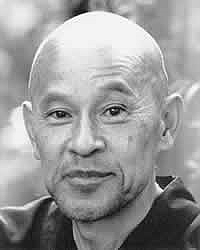
Abb.: Shunryu Suzuki
[Bildquelle:
http://www.chronicleproject.com/stories_30.html. -- Zugriff am
2005-04-28]
Der Soto-Geistliche Shunryu Suzuki (1904 - 1971) wird
nach den USA gesandt, um am in den 1930er Jahre gegründeten Sokoji-Tempel in
San Francisco zu wirken, Suzuki zog bald weiße Amerikaner an, so Richard
Baker (1936 - ), mit dem er 1962 das San Francisco Zen Center gründete
(siehe unten).
| "Shunryu Suzuki (鈴木 俊隆 Suzuki Shunryū,
dharma name Shogaku Shunryu) (May 18, 1904 - December 4, 1971)
was a Japanese Zen master of the Soto school, who played a major role in
establishing
Buddhism in America. The Japanese Soto-shu religious organization sent him to San
Francisco, USA in 1959 to attend the needs of a small Japanese-American temple,
Sokoji, in San Francisco's
Japantown. At the time of Suzuki's arrival, Zen had become a hot topic amongst
some groups in the
United States, especially
beatniks. San Francisco counterculturalists found Suzuki and asked him to
explain Zen. Suzuki limited his explanation to an invitation to sit zazen.
"I sit zazen every day here at 5:40AM," he is quoted as having said,
"and if you're here, you can sit, too."
The predominantly caucasian group that joined Suzuki to sit
eventually formed the
San Francisco Zen Center with Suzuki. The Zen Center raised money to buy a hot
springs resort, Tassajara, which they turned into a monastery. Soon thereafter,
they bought a building at 300 Page Street in San Francisco's
Haight-Fillmore neighborhood and turned it into a Zen temple. Suzuki left his
post at Sokoji to become the first abbot of the first Buddhist training
monastery outside of Asia. A collection of his teishos (Zen talks) were
bundled in the books Zen Mind, Beginner's Mind and Not Always
So: Practicing the True Spirit of Zen. His lectures on the
Sandokai are collected in Branching Streams Flow in the Darkness.
Suzuki's biography is captured in
David Chadwick's Crooked Cucumber.
StudentsNotable persons among Suzuki's students include:
- Tenshin Reb Anderson
- Zentatsu Richard Baker
- Edward Espe Brown
- David Chadwick
- Dainin Katagiri
- Jakusho Kwong
Quotations
- "Our tendency is to be interested in something that is growing in
the garden, not in the bare soil itself. But if you want to have a good
harvest, the most important thing is to make the soil rich and cultivate
it well."
- "So the secret is just to say 'Yes!' and jump off from here. Then
there is no problem. It means to be yourself, always yourself, without
sticking to an old self."
- "When you do something, you should burn yourself completely, like a
good bonfire, leaving no trace of yourself."
- "Zazen practice is the direct expression of our true nature.
Strictly speaking, for a human being, there is no other practice than
this practice; there is no other way of life than this way of life."
- "Take care of things, and they will take care of you."
- "In the beginner's mind there are many possiblilities, but in the
expert's there are few."
[Quelle:
http://en.wikipedia.org/wiki/Shunryu_Suzuki. -- Zugriff am
2005-05-06] |
Shunryu Suzuki begründete eine westliche
Überlieferungslinie:
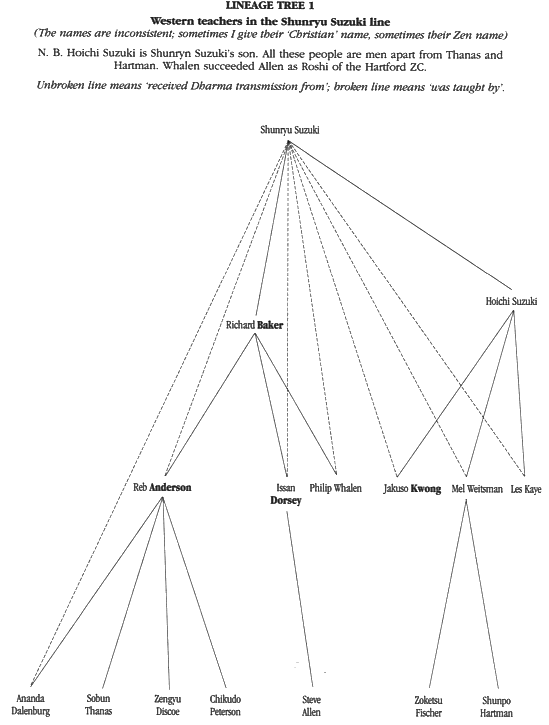
Abb.: Westliche Traditionslinie von Shunryu Suzuk
[Quelle der Abb.: Rawlinson, Andrew <1943 - >: The
book of enlightened masters : western teachers in eastern traditions. --
Chicago : Open Court, ©1997. --
xix, 650 S. : Ill. ; 25 cm.. -- ISBN: 0812693108. -- S. 174]
1959
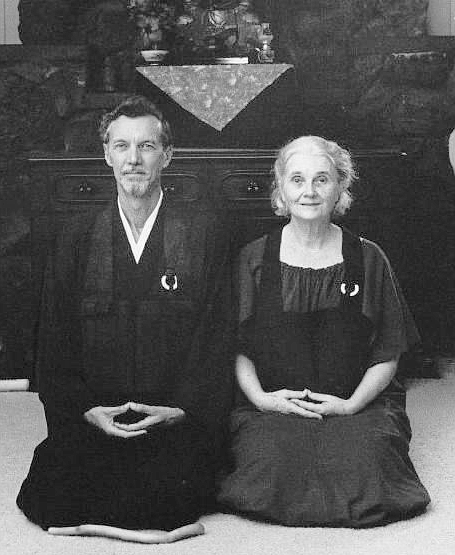
Abb.: Robert Aitken und Anne Hopkins Aitken (1911 - 1994)
[Bildquelle:
http://www.diamondsangha.org/whowe.htm. -- Zugriff am 2005-04-28]
Der Rinzai-Zenmeister Nakagawa Soen Roshi erlaubt Robert Aitken (1917 -
), in seinem Haus in Hawaii eine Zazengruppe zu leiten. Dies ist der
Beginn des Diamon Sangha in Honolulu [Webpräsenz:
http://www.diamondsangha.org/. --
Zugriff am 2005-04-28] .
Selbstdarstellung Robert Aikens:
|
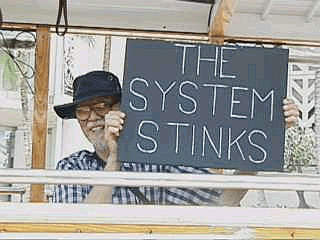
Abb.: Robert Aitken
"Robert Aitken is a retired master of the Diamond Sangha , a Zen
Buddhist society he founded in Honolulu in 1959 with his late wife
Anne Hopkins Aitken . Now at age 87, he is residing in the teachers' quarters at
the Honolulu
Diamond Sangha on O'ahu.
A lifetime resident of Hawai‘i, Aitken Rōshi is a graduate of the
University of Hawai‘i with a BA degree in English literature and an MA
degree in Japanese studies. In 1941, he was captured on Guam by invading
Japanese forces, and interned in Japan for the duration of World War
II. In the camp, he met the British scholar
R.H. Blyth , who introduced him to Zen Buddhism. After the war, he practiced Zen
with Senzaki Nyogen Sensei in Los Angeles, and traveled frequently to
Japan to practice in monasteries and lay centers with Nakagawa Sōen
Rōshi,
Yasutani Haku'un Rōshi , and Yamada Kōun Rōshi. In 1974, he was given
approval to teach by the Yamada Rōshi, Abbot of the Sanbo Kyodan in
Kamakura, Japan, who gave him transmission as an independent master in
1985.
Aitken Rōshi is the author of
more than ten books on Zen Buddhism , and co-author of a book-length
Buddhist-Christian dialogue . In Hawai‘i he was instrumental in founding the
Koko An Zendo, the Palolo Zen Center, the Maui Zendo, and the Garden
Island Sangha. A number of
other centers in Europe, North and South America, and Australasia are part of
the Diamond Sangha network.
Aitken Rōshi is co-founder of the
Buddhist Peace Fellowship (now with a local
East Hawai‘i Chapter) and serves on its international board of advisors. He has
been active in a number of peace, social justice, and ecological
movements, and his writing reflects his concern that Buddhists be
engaged in social applications of their experience.
Aitken Rōshi has given full transmission as independent masters to
- Nelson Foster, Honolulu Diamond Sangha and Ring of Bone Zendo in
Nevada City, California;
- John Tarrant ,
Pacific Zen Institute in Santa Rosa, California;
- Patrick Hawk,
Zen Desert Sangha in Tucson, Arizona, and
Mountain Cloud Zen Center in Santa Fe, New Mexico;
- Joseph Bobrow ,
Harbor Sangha in San Francisco, California;
- Jack Duffy ,
Three Treasures Sangha in Seattle, Washington;
- Augusto Alcalde, Vimalakirti Sangha, in Cordoba, Argentina and
- Rolf Drosten,
Wolken-und-Mond-Sangha (Clouds and Moon Sangha) , in Leverkusen, Germany.
He authorized Pia Gyger, One Ground Zendo in Luzern, Switzerland, as
an affiliate teacher of the Diamond Sangha.
He joined with John Tarrant in giving transmission as independent
masters to
Subhana Barzaghi in Sydney, New South Wales, Australia; and to Ross Bolleter in
Perth, Western Australia.
As a retired master, Aitken Rōshi works with a few long-time students,
and continues to study and write. His work,
Zen Master Raven: Sayings and Doings of a Wise Bird , was published by
Tuttle in 2000. His most recent publications,
The Morning Star: New and Collected Zen Writings , and a new edition of
A Zen Wave: Basho's Haiku and Zen , were released in October, 2003,
by Shoemaker and Hoard. "
[Quelle:
http://www.flex.com/~aitken/roshi/index.html. -- Zugriff am
2005-04-28]
|
"Aitken's initial contact with Zen was unusual and
delightful. Captured by the Japanese on the Pacific island of Guam (the
day after Pearl Harbor and having never fired a shot), he was taken
to a detention camp in Japan, where a guard lent him a copy of
Zen in English Literature and the Oriental Classics by
R.H. Blyth. Blyth was an English disciple of D.T. Suzuki—and the
guard was a disciple of Blyth s (Tworkov, 29). But Blyth, whom
Aitken calls Blyth Sensei (Taking the Path of Zen, 130), was also in
a detention camp because he had been living in Japan when the war
broke out. Eventually, Aitken and Blyth were both moved to the same
camp and met each other.
Fired by enthusiasm for Zen, Aitken returned to America after the
war but with no idea who to turn to for help. Then, in 1947 (at the
age of 30), he stumbled across Nyogen Senzaki in Los Angeles.
(Senzaki had himself been interned by the Americans during the war,
just as Sokei-an, the only other Japanese Zen teacher living in the
States at the time, had been.) Sensaki gave Aitken a Buddhist name (Chotan,
meaning 'Deep Pool') and agreed to give some instruction in koan
practice. But his style was not as rigorous as Aitken was looking
for, so in 1950 Aitken went to Japan and entered the monastery
presided over by Nakagawa Soen Roshi, a Rinzai master in the
lineage of the great Hakuin who had corresponded with Senzaki for 15
years from Japan.
Aitken returned to Hawaii (his home state) in 1951 and spent the
next few years there and in California, got divorced and ended up
teaching English at Krishnamurtis Happy Valley School in Ojai,
California. He married again in 1957 and the couple went to Japan
for their honeymoon, where Aitken renewed his acquaintance with Soen
Roshi and also met Yasutani Roshi for the first time. In
1958, he was attendant to Soen Roshi at the memorial sesshin held in
Los Angeles after Nyogen Senzaki's death. And in 1959 Soen Roshi
gave him permission to conduct a zazen group at his home in Hawaii.
To begin with, this zendo consisted of the Aitkens and one other
couple. It is entirely typical of Aitken that his career as a Zen
teacher should have begun so quietly.
In the following years, Aitken practiced with Yasutani Roshi and
Yamada Roshi (Yasutanis Dharma heir), and in 1974, a year after
Yasutani's death, he received Dharma transmission from Yamada Roshi.
It is a striking fact about Aitken's contact with Zen that he has
never spent years at a time in the company of a Japanese teacher (either
in Japan or in the West) but has had continuous but intermittent
contact with his teachers.
Aitken Roshi's style, both as a student and as a teacher, has been
quiet but radical. His own kensho is a good example of this. He had
an experience at a sesshin with Soen Roshi in Hawaii in 1961. "I
found the ceiling of my mind to be infinitely spacious. Everything
was bright and new." But Soen Roshi said that this was only "a
little bit of light" {Taking the Path of Zen, 123). Aitken continued
to practice (under both Soen Roshi and Yasutani Roshi) and in 1971,
Soen Roshi confirmed that Aitken had attained kensho. Yet, as Aitken
himself says, there was no spectacular experience asociated with
this attainment—not even something definite (ibid., 129).
Aitken has championed a form of radical pacifism, which began
immediately after World War II in Hawaii before he even began
practicing Zen: he joined groups discussing peace and labour issues
and was investigated by the F.B.I. (Tworkov, 31). He was against the
Vietnam war more or less as soon as it began, and was a member of
the Hawaii Committee to End the War in 1963 (Tworkov, 41). He has
demonstrated against nuclear testing (in the 1950s), for unilateral
disarmament (in the 1960s) and against the Trident missile (in the
1980s); and he was a co-founder of the Buddhist Peace Fellowship
in 1978. In 1982, he and his wife (also a Zen practitioner) withheld
that percentage of federal income tax that would be spent on
armaments—an illegal act but one which they have repeated every year
since. (See John Loori's entry for a reference.)
He has also been very critical of the West's exploitation of Third
World countries (for instance The Mind of Clover, 58). He argues
that this criticism is essentially, as opposed to tangentially,
Buddhist because the economic system of the West, by being
exploitive, goes against the second Zen precept, 'Do not steal' (The
Mind of Clover, 30). And it is the duty of the sangha to do
something about it because the Buddha intended the sangha to be an
instrument for social change (The Mind of Clover, 9). Not all Zen
teachers, nor all Buddhist teachers, agree with him (not least
because there are very different perceptions of what the sangha
consists of).
Another aspect of Aitken's radicalism is his effort to inculcate
equality of the sexes in his Zen groups. He sometimes refers to the
Buddha as 'she' (Women in Buddhism', Spring Wind [magazine of the
Zen Lotus Society], vol. 6, nos.l, 2, 3, 1986, p. 89) and has
encouraged the "feminizing [of] political and decision-making
processes as well as retranslation of sutras, excising sexist
language that had been transmitted unaltered down the centuries"
(Friedman, Meetings with Remarkable Women, 25). He maintains that
the best way forward for Western Zen is not the authoritarian (and
patriarchal) model of the East but "decision-making by consensus" (The
Mind of Clover, 77). Out of this will come proper sangha government.
However, this desire for a truly Western form of Zen is not a denial
of the need for transmission between teacher and student. Aitken is
critical of the kind of amorphous 'universalized Zen' made popular
by D.T. Suzuki and Blyth (Tworkov, 34); there has to be formal
practice and guidance by a qualified teacher. When Aitken retired
from the Uinversity of Hawaii in 1969 and started a zendo at Maui,
the daily routine, starting at 5:00 a.m., was as follows:
5.00 rise and wash
5.10 zazen
5.50 study period
6.30 breakfast
7.00 work period (household chores and gardening)
9-30 refreshment break
10.30 work period ends
11.10 zazen
12.00 dinner, short rest
1.00 work period
3 00 refreshment and rest
4.30 zazen
5.20 supper and rest
7.10 zazen
9.00 bed
Aitken sees his role in all this as a teacher but not as a guru.
That is, he has a realization and it is his task to bring about the
same realization in his students. For that, they have to trust him
as well as sticking to the practice and the daily schedule. But
Aitken explicitly rejects the guru role, by which he means that
everything the teacher does is a teaching device of some kind. He
cites Gurdjieff, and the Vedanta and Tibetan Buddhist traditions as
examples where this kind of role is made central (Tworkov, 57-58).
Yet the Zen lineage is important. In 1988 and 1989, Aitken Roshi
gave Dharma transmission to four of his students: two Americans (Nelson
Foster and Patrick Hawk, who is also a Catholic priest
and is leader of the Bishop Defalco Retreat Center in
Amarillo, Texas), an Australian living in America (John Tarrant),
and an Argentinian (Augusto Alcade, who runs a zendo in
Argentina).
This is an example of what might be called a Western Zen lineage—a
Western roshi creating Western Dharma heirs (as opposed to an
Eastern roshi creating Western Dharma heirs). It is typical of
Aitken's style that he should extend the contours of Zen, so to
speak, by charting a genuinely middle way between Eastern orthodoxy
and Western adaptation.1
1 I should point out, however, that in 1995, Aitken
and the Diamond Sangha formally separated from the Sanbokyodan
school after he and Kubota Roshi, Yamada Roshi's successor, agreed
to differ on the way in which Dharma-heirs are appointed. So Aitken
is now an independent Zen teacher."
[Quelle: Rawlinson, Andrew <1943 - >: The
book of enlightened masters : western teachers in eastern traditions. --
Chicago : Open Court, ©1997. --
xix, 650 S. : Ill. ; 25 cm.. -- ISBN: 0812693108. -- S. 156 - 158] |
1959
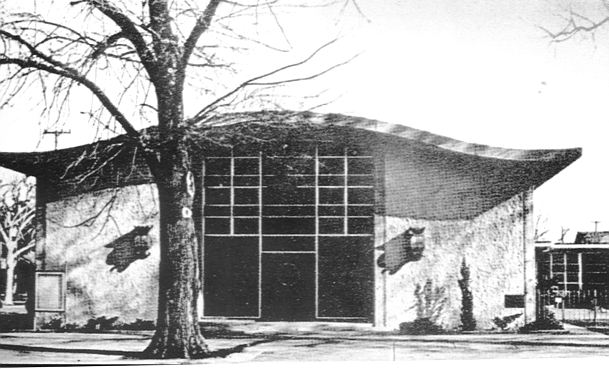
Abb.: Buddhist Church of Sacramento, 1959
[Bildquelle: Tricycle : the Buddhist review. -- ISSN 1055-484X. --
Vol. XI, No. 1 (Fall 2001). -- S. 82.]
1959
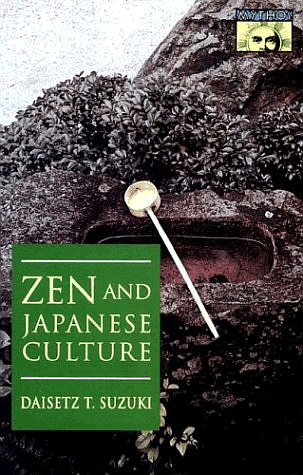
Abb.: Einbandtitel der Ausgabe von 1993
Es erscheint:
Suzuki, Daisetz Teitaro <1870-1966>: Zen and Japanese culture. --
.New York : Pantheon Books, [1959]. -- 478 p. -- [2., erweiterte
Auflage von
Zen Buddhism and its influence on Japanese culture (1938). -- Identifiziert
"den" Geist Japans mit dem Geist des Samurai und mit Zen-Buddhismus].
1959
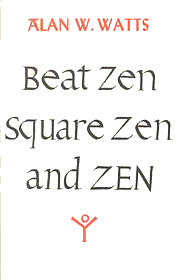
Abb.: Einbandtitel
Es erscheint:
Watts, Alan <1915-1973>: Beat Zen, square Zen, and Zen. --
[San Francisco] : City Lights Books, [©1959].
-- 25 S. ; 21 cm. -- [Erweiterte Fassung eines gleichnamigen Artikels in
Chicago Review, Summer 1958]
1960
Es erscheint:
Suzuki, Daisetz Teitaro <1870 - 1966> ; Fromm, Erich <1900 - 1980> ;
Marino, Richard de: Zen
Buddhism and
psychoanalysis.
-- London : Allen & Unwin, 1960. .. 180 S. ; 23cm.
| "Dieses Buch verdankt seine Entstehung einer Arbeitstagung über
Zen-Buddhismus und Psychoanalyse, die unter der Leitung des
Instituts für Psychoanalyse an der medizinischen Fakultät der
autonomen Staatsuniversität von Mexiko in Cuernavaca abgehalten
wurde. Hier fand eine erste eingehende Erörterung der
Berührungspunkte zwischen beiden Lehren statt. Grundlage der
Diskussion war eine Vortragsreihe von Dr. Suzuki, dem bedeutendsten
Vertreterdes Zen-Buddhismus im Westen. In seinem Referat, das den
Hauptteil des Bandes bildet, gibt er eine zusammenfassende
Darstellung der Wesenszüge des Zen-Buddhismus. Demgegenüber
unternehmen Erich Fromm, einer der bekanntesten amerikanischen
Psychoanalytiker und Richard de Marino, Prof. und Phil. und
Religionswissenschaftler an der japanischen Universität Kyoto, den
Versuch, die Brücke zwischen östlicher Religiosität und westlicher
Wissenschaft zu schlagen und die Frage zu beantworten, welchen Wert
die Begegnung von Zen und Psychoanalyse haben könnte. " [Quelle:
http://www.klassisches-karate.de/karate/b22.htm. -- Zuriff am
2005-07-07] |
1960-10
Die Nichiren Shoshu Academy (NSA) bringt Soka Gakkai nach
Kalifornien.
Webpräsenz: http://www.sgi-usa.org/.
-- Zugriff am 2005-04-28
| "Daisaku Ikeda, the President of Sokagakkai,
visited the US for the first time in October 1960 and established Nichiren
Shoshu in Los Angeles, the first time outside of Japan. It was called The American General Chapter, and it
did not have any leader until George M. Williams became the chief in 1968.
Chanting Nam-Myoho-Renge-Kyo to the Gohonzon was
initially brought to the US by Japanese women who married Americans during WWII.
However, the strong establishment did not take place until Ikeda's visit to the
US, as war brides were very isolated from the community and even from each other.
Without financial or emotional support, because of their poverty and inability
to understand English, they did not manage to propagate their religion, but just
to practice it on their own.
"George M. Williams [was] a naturalized American
citizen of Japanese parentage and [was] the central figure behind the
development and growth of Nichiren Shoshu of America." The turning point for
Williams was when his weak mother converted to Nichiren Shoshu; and as he
accompanied her to the temple, he worried about her health. He then became a
believer of Nichiren Shoshu. He came to the US to study at UCLA., and later
transferred to George Washington University in Washington D.C. where he
established the first Sokagakkai discussion group in the US. After Williams
earned a Master's degree, he spread Nichiren Shoshu in the Los Angeles region.
He changed his Japanese name to George Williams to strengthen the American
identity of himself and Nichiren Shoshu.
Williams encouraged members in the US to unite and
to be committed members by communicating with those who were spread out all over
the country. Williams spread True Buddhism of Nichiren Shoshu in the US and
returned to Japan along with some three thousand other Americans in 1973 to take
a pilgrimage (Tozan) to the main temple which held the Dai-Gohonzon at the foot
of Mount Fuji.
Nichiren Shoshu America (NSA) grew amazingly
between 1967 and 1971. In 1963, a few discussion meetings started to be held in
English such as one led by Williams in L.A. In these meetings, active
interchange between leaders, members, and guests took place to reaffirm and to
urge them to make a commitment to Nam-Myoho-Renge-Kyo. Even then, propagation
was still toward the Japanese community, mostly married Japanese housewives over
thirty of the upper-lower to lower-middle class, with little concern towards
reruiting non-Japanese Americans.
Most non-Japanese members were husbands of the
Japanese females and were associated with the military. However, things changed
dramatically in the following years; membership increased astonishingly and
members were mostly non-Japanese, single male and female students under thirty
or lower-level white-collar workers.
In 1966, the "Americanization" of Nichiren Shoshu
fully started as Japanese members were encouraged to learn English and to obtain
American citizenship. Most meetings were conducted in English, and the name of
the group was changed to Nichiren Shoshu America from Sokagakkai of America in
order to strengthen the separate American identification from Japan which held
criticism due to the highly pressured recruitment. Also, the name change
occurred because NSA sounded more like an American name and it was easy for
Americans to pronounce.
In 1967, a Nichiren Shoshu temple, Honseiji,
opened in Hawaii. By the mid-1970s, 200,000 believers were recorded and ninety
percent of them were non-Japanese. However, the highest leadership remained mostly
Japanese. NSA successfully maintained racial harmony within the group. On the
other hand, the Japanese culture of male dominance was still effective as the
family's chanting was lead by the male. At some meetings, seating was arranged
separately according to gender. All Nichiren Shoshu priests were males.
All members, including females, did not feel
frustrated as they felt that they had the ability to change their situations
through chanting Nam-Myoho-Renge-Kyo to the Gohonzon. This made it possible to
accomodate Japanese culture and thoughts into American society.In late 1991, the laity and the priesthood
separated, and the lay group renamed itself Soka Gakkai International-United
States (SGI-USA)."
[Quelle:
http://religiousmovements.lib.virginia.edu/nrms/nichiren.html.
-- Zugriff am 2005-04-28] |
1961-12-02
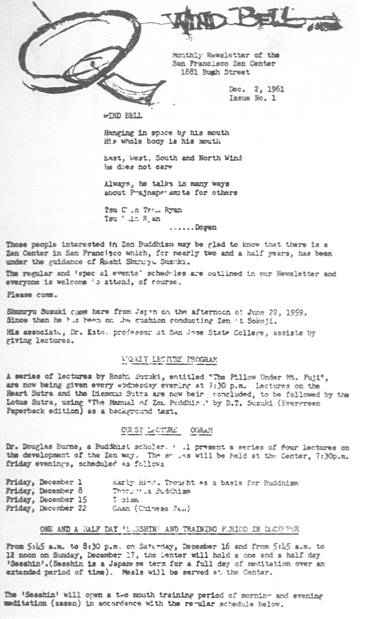
Abb.: Titelblatt
Es erscheint die erste Nummer der Zeitschrift:
Wind
bell. -- San Francisco
: Zen Center. -- Vol. 1 (1961) -
Eine Auswahl von Artikel dieser Zeitschrift ist:
Wind bell : teachings from the San Francisco Zen Center 1968-2001
/ edited by Michael Wenger. -- Berkeley, Calif. : North Atlantic Books,
©2002. -- xv, 322 S. : Ill. ; 23 cm.
-- ISBN: 1556433816. -- {Wenn Sie HIER
klicken, können Sie dieses Buch bei amazon.de
bestellen}
"On December 2, 1961 a one page monthly newsletter of the San
Francisco Zen Center called Wind Bell (after the poem by Rujing,
Dogen's teacher) was published. It became a mimeographed one- or
two-page sheet with an occasional reprint of a short talk by Zen
Center's founder, Suzuki Roshi. Suzuki Roshi would help run the
mimeograph machine with first Phillip Wilson, Bill Kwong, Graham
Petchey and eventually Richard Baker writing and editing it.
[...]
The Wind Bell grew, too. In the fall of 1968, it expanded to its
current printed 6x9 inch size with information on the campaign to
purchase Tassajara. Richard Baker served as editor until 1967,
bringing a fresh, American spirit to the magazine. While Baker was
in Japan from 1968 to 1971, Gary Snyder, Tim Buckley, Peter
Schneider, and Katherine Thanas edited issues.
From 1971 to 1983, Wind Bell appeared infrequently. In 1971 Richard
Baker, now Roshi, became Suzuki Roshi's successor as abbot of Zen
Center. He continued as the major force in the magazine, but time
constraints on his schedule led to sporadic publication. During this
time the content of Wind Bell tended to be mostly about Zen Center,
with a sprinkling of other news and articles about Buddhism outside
the institution.
In 1983, and again in 1987, the behavior of the abbots came under
close scrutiny because of charges of ethical misconduct. Both of
these situations were discussed in Wind Bell, which attempted to
present a fair and neutral description of the facts in an
emotionally charged situation. The question was how to be supportive
of all the parties involved while maintaining harmony and telling
the truth as straightforwardly as possible.
In 1984 Michael Wenger became editor and continued until 1990. He
put Wind Bell on a regular schedule of twice a year in the spring
and fall and opened the scope to include more emphasis on general
Buddhist issues.
Since 1983, Wind Bell, while reporting Zen Center events, has also
dealt with Buddhism as a whole and with the issues of American
Buddhism. Questions such as ethics, family practice, art, children,
and ethnic Buddhism were addressed. Reprints of Suzuki Roshi's
lectures continue to be a staple of the magazine, as is the current
abbots alternating a lecture for each issue. Also included have been
articles by scholars such as Carl Bielefeldt, Robert Buswell, Robert
Thurman, and Masao Abe, as well as religious leaders from other
traditions such as U Silananda, Thich Nhat Hahn, and Lama Govinda.
Work by, and interviews with, such artists as Mayumi Oda, Kaz
Tanahashi, Gordon Onslow-Ford, Natalie Goldberg, and Laurie Anderson
have also been featured. Listings of Zen groups related to Zen
Center throughout America have been included. The Wind Bell logo,
which was calligraphed by the famous Japanese painter Taiji
Karyokawa in the mid-1960s, remains a trademark of the publication.
Laurie Schley took over as editor in 1991 and continued to widen the
scope with issues featuring art, children growing up at Zen Center,
and Mitsu Suzuki, tea teacher and widow of Suzuki Roshi.
Ed Brown served as editor from 1995-97 and added a more personal
voice as well as articles about related Zen groups. Since then
Michael Wenger and Wendy Lewis have served as editors building on
the past while keeping open to innovation.
Wind Bell has had two major designers. From the late 60s until his
death in 1990, Peter Bailey (Red Dog Pie Face) set a free
professional yet informal layout and design. Rosalie Curtis ably
replaced him with a polished and up-to-date style.
Wind Bell is clearly both the publication of San Francisco Zen
Center as well as a national Buddhist subscription magazine. The
question of balance between how much of the magazine should be
devoted to Zen Center and how much to Buddhism in a wide sense is
ongoing. Covering a formative time in American Buddhism, it is both
a historical document and a repository of Buddhist thought."
[Quelle: Michael Dai Ryu Wenger. -- In: Wind bell :
teachings from the San Francisco Zen Center 1968-2001 / edited by
Michael Wenger. -- Berkeley, Calif. : North Atlantic Books,
©2002. -- xv, 322 S. : Ill. ; 23
cm. -- ISBN: 1556433816. -- S. XI - XIII {Wenn Sie HIER
klicken, können Sie dieses Buch bei amazon.de
bestellen}] |
1962
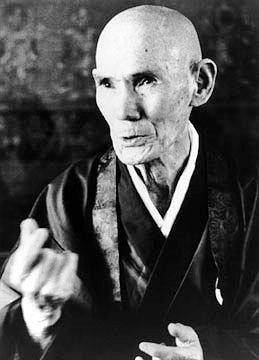
Abb.: Hakuun Yasutani Roshi, ca. 1974
[Bildquelle:
http://www.highzen.com/lineage.html. -- Zugriff am 2005-06-06]
Hakuun Yasutani Roshi (18885 - 1971) besucht erstmals
die USA. Yasutani hatte sich 1943 in einem Buch als übler japanischer
Imperialist und primitiver Judenfeind geoutet. Seine amerikanischen und
europäischen Schüler sahen in ihm aber einen großen Weisen und legen Wert
darauf, in seiner "lineage" eintreten zu stehen.
| "HAKUUN (Weiße Wolke) YASUTANI ROSHI (1885 - 1973)
Seisaku Yasutani wurde am 5.1.1885 geboren. Da seine Mutter eine
fromme Frau war, wollte sie, dass er Mönch würde, und gab ihn im
Alter von fünf Jahren in einen Tempel. Dort wurde er als
buddhistischer Mönch erzogen, besuchte daneben aber auch die Schule
und verbrachte schließlich vier Jahre an einer
Lehrer-Bildungsanstalt. Nominell Mönch, arbeitete er ab 1914 in
Ermangelung eines Tempels als Schullehrer, heiratete mit 30 Jahren
und wurde Vater von fünf Kindern.
Seit seinem 15. Lebensjahr hatte er Zazen geübt, spürte aber,
dass ihm ein wirklicher Meister fehlte. Mit 40 Jahren fand er ihn.
Es war Harada Roshi. Daraufhin gab er seine Schullaufbahn auf, wurde
Tempelpriester und besuchte regelmäßig Harada Roshi's Sesshin im
Hosshin-Ji. 1927 wurde ihm Kensho bestätigt, 1938 beendete er sein
Koanstudium unter Harada. Im Jahr 1943 erhielt er Inka und wurde zum
DharmaNachfolger seines Meisters ernannt.
Von da an widmete sich Yasutani Roshi intensiv der Lehrtätigkeit.
Er verfasste in diesen Jahren fünf Bände von Kommentaren zu den
Koan-Sammlungen. Außerdem leitete er regelmäßig Sesshin und Zazenkai
in allen Gegenden Japans, vor allem aber im Großraum von Tokyo.
Dadurch entstanden unter seiner Führung allmählich ca. 25 Zengruppen.
Eine von ihnen war das sog. Kamakura Hakuunkai, das am 23. Mai 1953
begann und die Grundlage für das spätere Zendo von Yamada Roshi in
Kamakura werden sollte. Was die Übungsweise betrifft, so hatte er
Haradas Schulungskonzept mit den 600-700 Koans übernommen und nur in
Kleinigkeiten abgeändert.
Am 8. Januar 1954 wurde die Sanbo-Kyodan-Linie - ein Name, unter
dem Yasutani seine Gruppen in ganz Japan organisiert hatte - von der
Soto-Schule unabhängig und als eine eigene Linie offiziell vom Staat
anerkannt. 1960 gab Yasutani das Siegel der Bestätigung an Kyozo
Yamada und bestimmte ihn zu seinem Nachfolger. Zwei Jahre später
unternahm Yasutani seine erste Reise in die USA und hielt in vielen
namhaften Städten Sesshin ab. Sechs weitere Reisen dorthin folgten
im Lauf der nächsten Jahre, und auch in England, Frankreich und
Deutschland hielt er Vorträge über Zen. Daneben schrieb er zwischen
1967 und 1972 einen fünfbändigen Kommentar zu Dogen Zenji's
Shobogenzo und - in chinesischer Sprache - ca. 1500 Gedichte.
1970 trat er als Oberhaupt der Sanbo-Kyodan zurück; Yamada Koun
Roshi rückte nach. Im gleichen Jahr noch gab Yasutani Inka unter
anderem an Hakuyu Maezumi und an Akira Kubota, das heutige Oberhaupt
der Linie. Im März 1973 starb Yasutani, 88-jährig."
[Quelle:
http://www.willigis-jaeger.de/deu/publikationen/aufsaetze/sanbo_c.html.
-- Zugriff am 2005-06-06] |
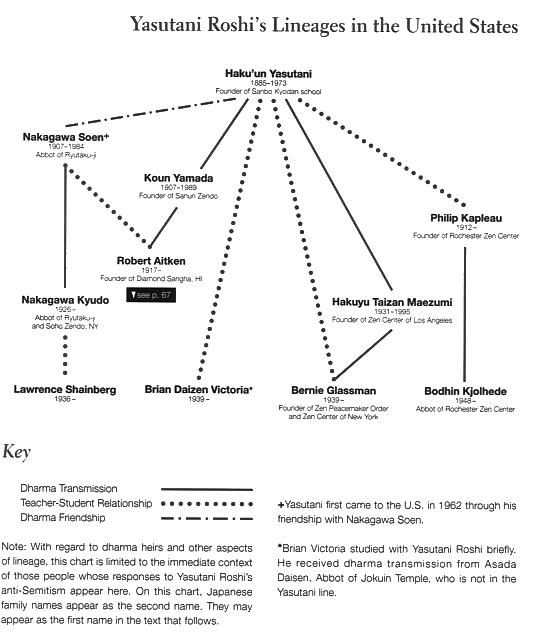
Abb.: Yasutani Roshi's lineage in the USA
[Bildquelle: Tricycle : the Buddhist
review. -- ISSN 1055-484X. -- Vol. IX, No.1 (Fall 1999). -- S.
61.]
1962
Gründung des San Francisco Zen Center unter der Leitung des
Soto-Zenmeisters Shunryu Suzuki Rioshi (1904-1971).
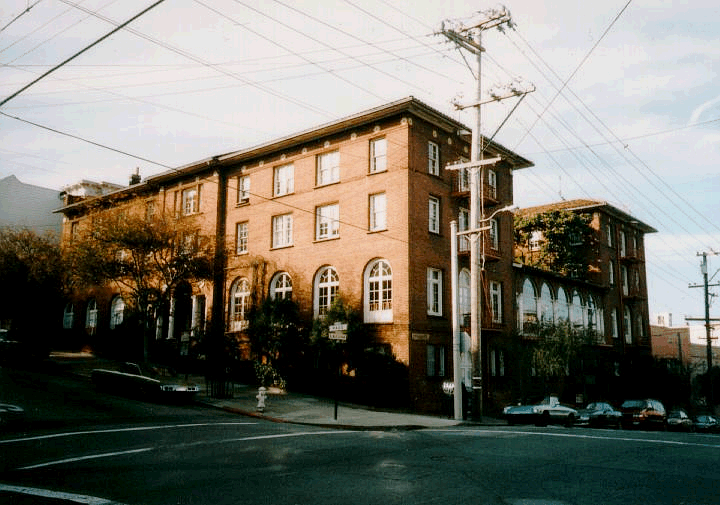
Abb.: San Francisco Zen Center
[Bildquelle:
http://www.ne.jp/asahi/bodhipress/way/news/way18/naganosf.html. --
Zugriff am 2005-04-28]
Webpräsenz:
http://www.sfzc.com/. -- Zugriff am
2005-04-28
| "Abbots of San Francisco Zen Center
Shunryu Suzuki-roshi, a Japanese Zen
priest belonging to the Soto lineage, came to San Francisco in 1959 at
the age of fifty-four. Already a respected Zen master in Japan, he was
impressed by the seriousness and quality of "beginner's mind" among
Americans he met who were interested in Zen and decided to settle here.
As more and more people of non-Japanese background joined him in
meditation, Zen Center came into being and he was its first abbot. Under
his tutelage, Zen Center grew into City Center, Green Gulch Farm and
Tassajara Zen Mountain Center. He was undoubtedly one of the most
influential Zen teachers of his time. Some of his edited talks have been
collected in the books Zen Mind,
Beginner's Mind and Branching Streams Flow in the Darkness: Zen Talks on the Sandokai.
Suzuki-roshi died in 1971.
Zentatsu Richard Baker-roshi
was second abbot of Zen Center, serving from 1971 until 1983. He was
instrumental in the purchase of Tassajara Zen Mountain Center and Green
Gulch Farm. He was also the leading force in setting up Zen Center's
financial base of support, including Greens Restaurant at Fort Mason and
Tassajara Bakery in San Francisco. Although the circumstances leading to his
resignation as abbot in 1984 were difficult and complex, in recent years,
there has been increased contact; a renewal of friendship and dharma
relations. In his teaching, Baker-roshi emphasized Zen's yogic teachings and
the relevance of Zen to contemporary philosophical and social issues. He is
presently the spiritual head of Dharma Sangha, with locations in Crestone,
Colorado, and the Black Forest of Germany.
Dainin Katagiri-roshi came
to the United States in 1963 after training at Eiheiji Monastery and working
with Soto Propagation and Research Institute and then for the Soto
Headquarters Office in Tokyo. He practiced and taught at the Zenshuji Soto
Zen Mission in Los Angeles, later moving to Sokoji Soto Zen mission and then
to San Francisco Zen Center, where he assisted Suzuki-roshi. In 1972 he
became the first abbot of Minnesota Zen Meditation Center in Minneapolis. He
returned as abbot of San Francisco Zen Center betwen 1984 and 1985, then
returning to Minneapolis. His book Returning to Silence was published
in 1988 (Shambhala, Boston & London, 1988). Katagiri-roshi died in 1990.
Tenshin Reb
Anderson was born in Mississippi in 1943 and grew up in Minnesota.
He came to Zen Center in 1967 and was ordained as a priest in 1970 by
Suzuki-roshi, who gave him the name Tenshin Zenki ("Naturally Real, The
Whole Works"). He received dharma transmission in 1983, served as abbot from
1986 to 1995, and is currently senior dharma teacher. He lives with his
family at Green Dragon Temple (Green Gulch Farm).
Sojun Mel Weitsman began practice at
the old Sokoji Temple in San Francisco in 1964 with Suzuki-roshi. He
received priest ordination from Suzuki-roshi in 1969 at Berkeley Zendo which
he founded in 1967 with Suzuki-roshi's blessing. He was shuso at Tassajara
in 1970 with Tatsugami-roshi and director of Tassajara in 1972-1973. In
1984, he received dharma transmission from Suzuki-roshi's son Hoitsu. In
1985, he was installed as abbot of Berkeley Zen Center; in 1988 he was
installed as co-abbot of San Francisco Zen Center. His tenure as abbot ended
in January 1997. He is currently a senior dharma teacher.
Zoketsu Norman Fischer began his Zen
practice under Sojun Mel Weitsman at the Berkeley Zen Center in 1970. He
enrolled as a student at Tassajara Zenshin-ji monastery in 1976, lived there
for five years, and then practiced for twenty years at Green Gulch Green
Dragon Temple and Farm. Ordained by Zentatsu Richard Baker in 1980, he
received Dharma Transmission from Sojun in 1988. He served as co-abbot of
Zen Center from 1995 to 2000.
A poet and writer, he is the author of
numerous Buddhist essays, a memoir, and nine books of poetry, the latest of
which is Success, (Singing Horse Press, Philadelphia, 2000). In
2002 Putnam Penguin published his Opening To You: Zen-Inspired
Translations of the Psalms.
In February of 2000 Zoketsu began the
Everyday Zen Foundation:
http://www.everydayzen.org, dedicated to "Changing the world and being
changed by it and sharing Zen teaching and practice as widely as possible
and in a variety of formats".
Zoketsu now lives with his wife Kathie in
Muir Beach, near Green Gulch Farm. They have two grown twin sons, Aron and
Noah.
Zenkei
Blanche Hartman began sitting in 1969 at the Berkeley Zen Center
with Sojun Mel Weitsman and in San Francisco with Suzuki-roshi. She was
priest ordained in 1977 by Zentatsu Baker-roshi and received dharma
transmission with Sojun Mel Weitsman in 1988. Zenkei became abbess of San
Francisco Zen Center in February of 1996. She is married to Shuun Lou
Hartman. They have four children and five grandchildren.
Jiko Linda Cutts came to San Francisco
Zen Center in 1971, where she practiced with Suzuki Roshi, Zentatsu Richard
Baker, and Tenshin Reb Anderson. She was ordained as a priest in 1975, and
has lived at Tassajara and the City Center. Married to Steve Weintraub, she
and her family have lived at Green Gulch Farm since 1993. She received
dharma transmission from Tenshin Reb Anderson in 1996 and became co-Abbess
of Zen Center in February of 2000. From Belfast, Northern Ireland, Paul Haller left home in 1971, lived
in London for a year, then traveled throughout Europe, the middle east,
Russia, and Afghanistan. He ended up in Japan, where he lived for a year and
was introduced to Zen. Then he traveled throughout southeast Asia. He was
ordained a Buddhist monk in Thailand, where he spent six months sitting in a
remote cave.
Moving to Tassajara Zen Mountain Center in 1974, Paul was ordained as a
priest by Zentatsu Richard Baker in 1980, who gave him the name Ryushin
Zendo, "Dragon Heart, Zen Way". In 1993 he received Dharma Transmission from
Sojun Mel Weitsman.
Founder and formerly Director of Outreach at
SFZC, Paul is interested in finding ways of expressing our practice in
society, both as compassionate service and making it available to as many
people as possible."
© 2002 San Francisco Zen Center
All rights reserved. "
[Quelle: http://www.sfzc.com/. --
Zugriff am 2005-04-28] |
1962-07-21
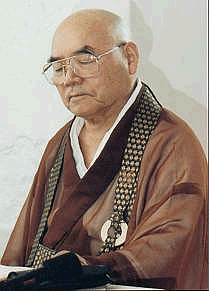
Abb.: Joshu Sasaki Roshi
[Bildquelle:
http://www.bodhidharmazendo.net/Genro.html. -- Zugriff am 2005-06-21]
Kyozan Joshu Sasaki Roshi (1907 - ) kommt auf Einladung
von Dr. Robert Harmon and Gladys Weisbart
nach Los Angeles. Das erste Rinzai-ji-Zendo wird
in einer Garage eingerichtet. 1968 eröffnet er Cimarron Zen Center
(jetzt Rinzai-ji Zen Center) in Los Angeles.
Webpräsenz:
http://www.rinzaiji.org/. -- Zugriff am 2005-06-21
| "Denkyo Kyozan Joshu Sasaki, Roshi Japan
Joshu Roshi was born into a farming family near Sendai in Miyagi
Prefecture, Japan, April 1907. At the age of 14 he traveled five
hundred miles to Sapporo in Hokkaido, northern Japan, to become a
Zen student under Joten Soko Miura Roshi at Zuiryo-ji. Joten Miura
would later become head of Myoshin-ji, one of the preeminent Rinzai
temple complexes in Japan and bring his students with him. Joten
Soko Roshi was instrumental in Sasaki Roshi's coming to America.
Joshu Sasaki was ordained an Osho (priest) at the age of
twenty-one, receiving the name Kyozan. Between the ages of 21 and
40, Joshu Roshi lived as a priest at Myoshin-ji in Kyoto. In 1947 at
the age of forty, he received his authority as a Roshi and became
abbot of his own monastery.
In 1953, Roshi was assigned to become the abbot of Shoju-an in
Iiyama, Nagano Prefecture. Shoju-an was an abandoned temple founded
by Hakuin's master Dokyo Etan. The temple was in disrepair, and
Roshi set about restoring it. Roshi taught at Shoju-an until he was
sent to the United States in 1962.
AmericaDr. Robert Harmon and Gladys Weisbart, both
members of the Joshu Zen Temple in Little Tokyo, Los Angeles, had
been independently trying to bring a Rinzai Zen monk to Los Angeles.
Once they found out about each other's efforts, they began a united
campaign. In Joshu Roshi, Dr. Harmon found an interested candidate.
After working out the details by correspondence, the Kancho of
Myoshin-ji, Daiko Furukawa Roshi, formally requested Joshu Roshi to
begin teaching Zen in the United States.
Roshi arrived at Los Angeles International Airport on July 21,
1962, where he was met by his sponsor, Dr. Robert Harmon. Both men
remember that Roshi, who had but a rudimentary command of English,
carried with him both Japanese-English and English-Japanese
dictionaries.
Roshi began living initially in a garage at Dr. Harmon’s house.
Dr. Harmon later rented a small house on Mariposa St. in Gardena,
where Roshi took up residence. With few furnishings or amenities at
first, the house was Roshi's residence by day and a Zendo at night.
He conducted Zen meetings on weeknights and Sunday mornings, as
well as weekly meetings at the homes of some of his students. Roshi
served as Jikijitsu, Shoji and Tenzo, while also giving Sanzen and
leading the chants at the beginning of each meeting.
In November 1963, Roshi and his Zen students incorporated the
Rinzai Zen Dojo Association. Over the next few years, as Roshi's
reputation spread throughout Southern California, he led group Zazen
in homes in the Hollywood Hills, Laguna Beach and Beverly Hills.
When the Mariposa Zendo outgrew its quarters in 1966, the group
started holding Zazen in office space donated by Harmon.
Establishing Rinzai-jiThe intensity of Roshi's teaching has never
wavered since he first arrived in California more than 40 years ago
on a mission to bring Zen to Americans. As Roshi has brought his
teaching to thousands of students, a sizeable network of training
centers and urban Zen organizations has grown up to facilitate
practice and preserve the tradition he represents. Ironically, when
he came to these shores Roshi did not expect to build a large
organization.
"I had thought of having five or six students who really lived
the life of Zen and that would be it," he said in an interview last
year. "I would die in America. I had no plan to create temples or
centers."
In July 1967, Roshi decided to commemorate his fifth anniversary in the
U.S. by conducting his first seven-day Dai-sesshin in the mountain
village of Idyllwild, California. In January 1968 Rinzai Zen Dojo
Association changed its name to Rinzai-ji, Inc., and purchased its
first property, Cimarron Zen Center at 2505 Cimarron Street, Los
Angeles.
A complex of buildings surrounded by high walls, Cimarron Zen
Center needed extensive renovation before it was formally dedicated
on April 21,1968.
Roshi took up residence there along with a group of students.
Cimarron Zen Center now is known as Rinzai-ji and is the main temple
of the Rinzai-ji organization. It features also a dormitory,
Gentei-an, which allows for residential Zen practice.
Training CentersThree years later, 1970, Rinzai-ji's main
training center, Mt. Baldy Zen Center was opened high in the San
Gabriel Mountains east of Los Angeles. Located in the middle of the
Angeles National Forest, Mt. Baldy Zen Center operates under a
99-year lease from the U.S. government. Formerly an abandoned Boy
Scout camp, the pine-shaded property has been refurbished to
accommodate resident monks and nuns, as well as visitors attending
Dai-sesshin. When Roshi is not in residence the center hosts groups
and workshops.
Mt. Baldy Zen Center has gained a reputation in American Zen
circles for its rigorous practice, which includes 19-hour-a-day
sesshin schedules. Most of Rinzai-ji's monks and nuns have received
some or all of their training at Mt Baldy Zen Center.
With the establishment of the Rinzai-ji and Mt. Baldy Zen Centers
in the late 1960s and early 1970s, Joshu Roshi had laid the
groundwork for a corps of ordained monks, nuns, and priests to help
him carry out his work.
When a Mt. Baldy student named Michelle Martin asked Roshi to
come to New Mexico to conduct a Dai-sesshin, he playfully replied, "You
find hot springs, I come." After she returned to New Mexico, Martin
and a friend found an old Catholic monastery for sale in Jemez
Springs. They invited Roshi to inspect the facilities to see if they
were appropriate for a Zen community, and, in 1974, Jemez Bodhi
Mandala was founded, now known as Bodhi Manda Zen Center.
Bodhi Manda became Roshi's second training center, offering daily
Zazen and communal work practice. Like Mt. Baldy, Bodhi Manda's
setting is magnificent. The property borders the Jemez River, in a
dramatic, steep-walled canyon. The facility includes dormitories, a
communal dining hall, and a small guest house. Bodhi Manda residents
have extensively renovated the property over the past two decades,
expanding the hot pools, piping geothermally heated water through
the living quarters to provide heat, and planting an orchard and an
extensive garden, which provide fresh vegetables and fruit for the
residents.
Financially, the center draws income from hosting Dai-sesshins,
renting the guesthouse, and leasing the entire facility to various
groups for retreats and workshops. Bodhi Manda passed a major
milestone in the fall of 2001, when it paid off its mortgage.
Summer Seminar on the Sutras
Another important component of Joshu Roshi's work in the United
States has been the Summer
Seminar on the Sutras series, begun at Mt. Baldy Zen Center in
1977. Over the past 16 years, the seminars have drawn Buddhist
scholars from the US, Japan, and elsewhere to examine the
fundamental principles of Buddhism. The seminars have been held at
Bodhi Manda Zen Center since 1985.
Joshu Roshi has traveled extensively to conduct Dai-sesshins,
both in the US and abroad. He has conducted Sanzen with students in
Canada, Poland, Norway, Austria, Germany, Spain, Belgium, and New
Zealand. For a period of nearly 10 years, he held regular
Dai-sesshins for Trappist monks at St. Joseph's Abbey in Spencer,
Massachusetts.
Meanwhile, Roshi's students have established Zen centers in
places as diverse as Redondo Beach (California), Vienna (Austria),
San Juan (Puerto Rico), Vancouver (Canada), Ithaca (New York), Miami
(Florida), Mt. Cobb (California) and Princeton (New Jersey).
Much of this information was compiled from The
Zen of Myoshin-ji Comes to the West: 25 Years of Joshu Roshi in
America 1962-1987 and Zen Master Joshu Sasaki: The Great
Celebration"
[Quelle:
http://www.rinzaiji.org/about/abbot.html. -- Zugriff am 2005-06-21] |
1963
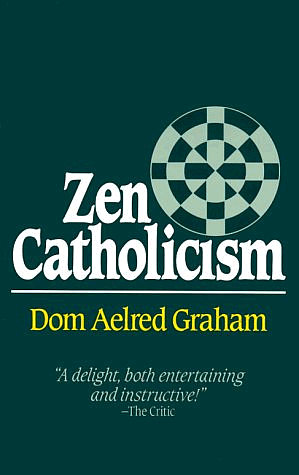
Abb.: Einbandtitel des Reprints 1994
Graham, Aelred<1907 - 1984>: Zen Catholicism : a suggestion. -- New York
: Harcourt, Brace & World, 1963. -- 228 S.
Graham ist ein britischer Benediktinermönch, der sich zeitweise in den USA
aufhielt.
"Friday, September 26, 2003Zen Catholicism
Excuse me while I go all Catholic Geek on you. In a little
burst of serendipity, I came across my latest favorite book,
called
Zen Catholicism at a discount
book sale. Yes, Zen
Catholicism. Both I and the sales
clerk did a double take at the title.
Now you might suspect, as I originally did, that this book
might just be another fluffy “New Age” spin aimed at Catholics
who are slightly embarrassed at the stodginess of their boring
faith and want to try on something trendier. You know, the kind
of book that
this papal document is aimed at. But I looked inside the cover and was surprised.
Imprimatur by Archbishop Cardinal Spellman of New York. Written
in 1963, *before* Vatican II. Blurb on the cover from Thomas
Merton.
The guy sets out right away saying he’s just trying to show
the compatibility of Catholicism,
pre-Vatican II Cathoilicism, with the Zennist approach to the
teachings of the Buddha. I’m reading the first chapter (very
dense material!) in conjunction with Gaudium et Spes as a
cross-reference since the topic concerns the nature of man and
God.
Now, I am hardly a stickler for orthodoxy. But every once in
a while I find it’s good to get a bearing on where I stand in
relation to the core teaching of the faith community I call
home. Keeping an “open mind” about religion these days is quite
fashionable, but I find that for many the “open mind” attitude
is not afforded back to the established orthodoxies. Mea Culpa
there more than I’d like to admit.
So I decided I would take some time to triangulate my
position in relation to Traditional
Catholicism. I am surprised to find I’m a lot closer – at
least in the basic topics I’ve studied so far – to being
traditional than I thought.
I suspect that, while
Zen Catholicism is not a Buddhist spin on
Catholicism, it is definitely a
Catholic spin on Buddhism. Dom Aelred
Graham picks and chooses among competing teachings in the
Buddhist traditions the ones that are most compatible with
Catholic theology. Case in point the differing teachings on the
existence of the individual human ego.
Graham conveniently cites the original Buddha’s refusal
to make definitive metaphysical statements, leaving him free to
choose whatever conclusion is most convenient.
Well, I’ve never made any bones about being a “Cafeteria
Buddhist.” But, if you’re a newbie at the Buddhist buffet, and
all the dishes are described in Chinese, it’s nice to have
someone along who knows the language to show you which dishes
are good and which will make you a bit queasy.
Which reminds me of something funny I read a while back:
“Buddhism in America is like surfing in America. Few people
want to actually do it, but they do want to listen to the music
and wear the clothes.” |
1963
Soka Gakkai of America eröffnet ihren Hauptsitz in Los Angeles und
hält die erste Versammlung in englischer Sprache ab.
1965
Der Immigration Act 1965 beendet das nationale Quotasystem und
bewirkt eine neue Welle der Einwanderung von Asiaten in die USA.
| "The Immigration Act of 1965 (also known as the
Hart-Celler Act) abolished the national-origin quotas that had
been in place in the
United States since the
Immigration Act of 1924. Immigrants were to be admitted by their skills and
professions rather than by their nationality. An annual limitation of 170,000 visas was established for immigrants from
Eastern Hemisphere countries with no more than 20,000 per country. By 1968,
the annual limitation from the
Western Hemisphere was set at 120,000 immigrants, with visas available on a
first-come, first-served basis.
The
House of Representatives voted 326 to 69 in favor. The Senate
passed the bill by a vote of 76 to 18.President
Lyndon Johnson signed the legislation into law.
The Act was influenced by the
Civil Rights Movement.
The Act also began the rejuvenation of the
Asian American community in the United States by abolishing the strict quotas
that had restricted immigration from Asia since 1882. Increased
numbers of Asian immigrants then began arriving, renewing Asian
communities that had nearly died out."
[Quelle:
http://en.wikipedia.org/wiki/US_Immigration_Act_of_1965. --
Zugriff am 2005-04-28] |
1966
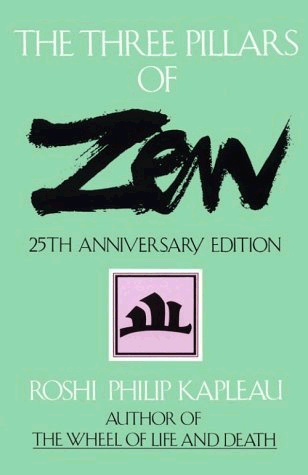
Abb.: Einbandtitel der Jubiläumsausgabe, 1989
The Three pillars of Zen: teaching, practice, and enlightenment
/ Compiled & edited, with translations, introductions & notes, by Philip
Kapleau [1912 - 2004]. Foreword by Huston Smith. -- [1st U.S. ed.]. --
New York : Harper & Row, [1966, ©1965].
-- 363 S. : Ill.
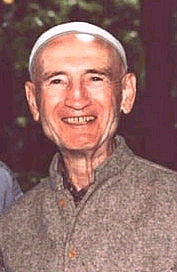
Abb.: Philip Kapleau [Bildquelle:
http://www.librosbudistas.com/autores/KAP.htm. -- Zugriff am 2003-06-23]
Philip Kapleau (1912 - 2004) gründet das Rochester Zen Center
[Webpräsenz: http://www.rzc.org/. -- Zugriff
am 2003-06-23]
| "Philip Kapleau (1912 - 2004) was an American teacher of Zen
Buddhism in the Harada-Yasutani tradition, a blending of Soto and
Rinzai schools. He was a student of
Daiun Harada and
Soen Nakagawa and was a disciple of
Haku'un Yasutani. Kapleau was born in New Haven,
Connecticut, where he studied law and became a court reporter. In 1945 he was
chief court reporter for the
Nuremberg Tribunals and later covered the
Tokyo War Crimes Trials. While in Japan he became interested in Zen Buddhism.
After a return to America for studies at
Columbia University with D.T.
Suzuki, Kapleau moved to
Hosshin-ji monastery in Japan in 1953.
After thirteen years of study under three Japanese Zen masters, he
was ordained by Haku'un Yasutani in 1965 and given permission by him to
teach. Kapleau transcribed Zen teachers' talks, interviewed lay students
and monks, and recorded the practical details of Zen Buddhist practice.
His book, The Three Pillars of Zen, was published in 1965 and has
been translated into twelve languages.
During a book tour in 1965 he was invited to teach at a small
meditation group in
Rochester, New York. In 1966 he left Japan to create the Rochester Zen Center.
For over twenty years, Kapleau taught at the Rochester Zen Center and
provided dharma transmission to several disciples. He also introduced
Western modifications (such as chanting the Heart
Sutra in English rather than Japanese) to Zen tradition which may have
contributed to his ultimate alienation from Yasutani.
Kapleau was an articulate and passionate writer. His emphasis in
writing and teaching was that insight and enlightenment are available to
anyone, not just austere Zen monks. Known for his views on
vegetarianism, peace and compassion, he remains widely read.
Kapleau is a notable influence on Zen Buddhism as it is practiced in
the West. Today, his dharma heirs, descendants and former students teach
at Zen Centers around the world.
On 6 May
2004, he
died from complications of Parkinson’s Disease at the Rochester Zen
Center."
[Quelle:
http://en.wikipedia.org/wiki/Philip_Kapleau. -- Zugriff am
2005-04-27] |
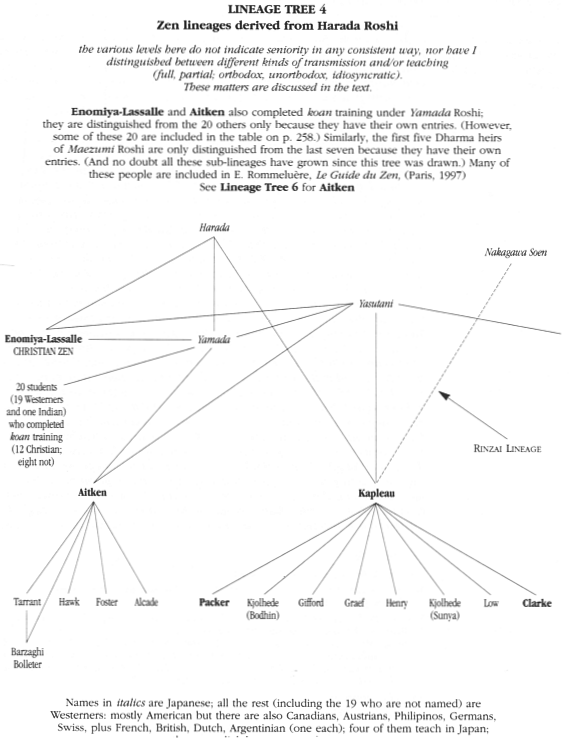
Abb.: Traditionslinien, in denen Kapleau steht
[Quelle der Abb.: Rawlinson, Andrew <1943 - >: The book of enlightened
masters : western teachers in eastern traditions. -- Chicago : Open Court,
©1997. -- xix, 650 S. : Ill. ; 25 cm..
-- ISBN: 0812693108. -- S. 316]
1966
Daisetz Teitaro Suzuki (1870-1966) stirbt
1966
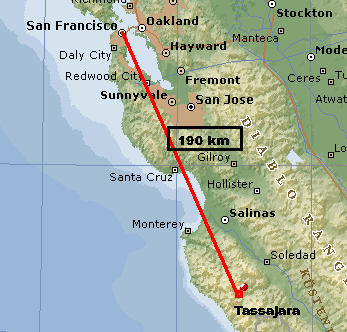
Abb.: Lage von Tassajara (©MS Encarta)
Das San Francisco Zen Center gründet das Tassajara Zen Mountain Center
im Los Padres National Forest. Es ist das erste Zen-Kloster in den USA.
Webpräsenz:
http://www.sfzc.org/tassajara/. -- Zugriff am 2005-04-28
| "Tassajara Zen Mountain Center, also known as Zenshin-ji (Zen Mind
Temple), is a Soto Zen Buddhist monastery established by Suzuki Roshi and
the San Francisco Zen Center in 1966.
Set in the rugged Ventana Wilderness, approximately 27 miles inland
from Big Sur, Tassajara Creek and its mineral-rich hot springs have been
in use for hundreds of years, first as traditional ceremonial grounds of
the Esselen Indians before the road and original resort were built in the
1860s.
From September to April, Tassajara is closed to the public while the
resident community immerses itself in the 1,000-year-old tradition of
monastic zen training.
From May through August, Tassajara opens its gates to welcome and serve
guests from all over the world, here to enjoy workshops, retreats, guest
practice, work-study programs, and the quiet, peaceful solitude of our
mountain valley.
Please keep in mind that reservations are absolutely required, even for
day guests."
[Quelle:
http://www.sfzc.org/zmcindex.htm. -- Zugriff am 2003-06-22] |
1967
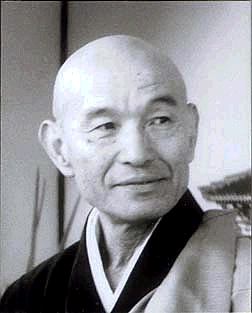
Abb.: Hakuyu Taizan Maezumi Roshi
[Bildquelle.
http://www.zencenter.org/texts/roshi.htm. -- Zugriff am 2003-06-22]
Der japanische Soto-Zenmeister Hakuyu Taizan Maezumi Roshi (1931-1995) gründet das
Zen Center of Los Angeles (ZCLA).
Webpräsenz:
http://www.zencenter.org/. -- Zugriff
am 2005-04-28
| "Maezumi Roshi was ordained as a Soto Zen monk at the age
of eleven. He received degrees in Oriental Literature and Philosophy
from Komazawa University and studied at Sojiji, one of the two main
Soto monasteries in Japan. He received Dharma transmission from
Hakujun Kuroda, Roshi, in 1955. He also received approval as a
teacher (Inka) from both Koryu Osaka, Roshi, and Hakuun Yasutani,
Roshi, thus becoming a Dharma successor in three lines of Zen.
In 1956, Maezumi Roshi came to Los Angeles as a priest at
Zenshuji Temple, the Soto Headquarters of the United States. He
devoted his life to laying a firm foundation for the growth of Zen
Buddhism in the West. In 1967, he established the Zen Center of Los
Angeles. Its honorary founder is Baian Hakujun Daiosho, who headed
the Soto Sect Supreme Court and was one of the leading figures of
Japanese Soto Zen.
Maezumi Roshi established six temples in the United States and
Europe that are formally registered with Soto Headquarters in Japan.
In addition to ZCLA, these include Zen Mountain Center in Mountain
Center, CA; Zen Community of New York (Tetsugen Glassman, Abbot);
Kanzeon Zen Centers of Salt Lake City, Utah and Europe (Genpo Merzel,
Abbot); and Zen Mountain Monastery in New York (Daido Loori, Abbot).
Affiliated centers also include the Zen Community of Oregon (Chozen
Bays, teacher); Jo Ren Zen Center in San Diego (Jikyo Miller,
teacher); Centro Zen de Mexico, Coyoacan (Tesshin Sanderson, teacher),
and Centro Zen de la Cuidad de Mexico. In addition, there are over
fifty groups in the Americas and Europe that are affiliated with
ZCLA.
In 1976, Maezumi Roshi established the Kuroda Institute for the
Study of Buddhism and Human Values, a non-profit educational
organization formed to promote scholarship on Buddhism in its
historical, philosophical, and cultural ramifications. The Institute
serves the scholarly community by providing a forum in which
scholars can gather at conferences and colloquia. The Institute also
publishes a book series with the University of Hawaii Press devoted
to the translation of East Asian Buddhist classics and presentations
of scholarly works from its conferences. Maezumi Roshi also founded
the Dharma Institute in Mexico City.
Maezumi Roshi founded the White Plum Asanga, named after his
father Baian Hakujun Daiosho. He transmitted the Dharma to twelve
successors:
- Bernie Glassman,
- Dennis Genpo Merzel,
- Charlotte Joko Beck,
- Jan Chozen Bays,
- John Daido Loori,
- Gerry Shishin Wick,
- John Tesshin Sanderson,
- Alfred Jitsudo Ancheta,
- Charles Tenshin Fletcher,
- Susan Myoyu Andersen,
- Nicolee Jikyo Miller, and
- William Nyogen Yeo.
These twelve successors have further transmitted the Dharma to a
number of "second-generation" successors. In America, Maezumi Roshi
ordained 68 Zen priests and gave the lay Buddhist precepts to over
500 people.
As a major contribution to the transmission of Buddhist teachings
to the West, Maezumi Roshi was instrumental in bringing to
realization the formation of the Soto Zen Buddhist Association (SZBA)
of American Soto Zen teachers. Maezumi Roshi also promoted exchange
programs among priests and lay practitioners between the United
States and Japan. He had published commentaries on major Buddhist
works, and his collected works will be published posthumously."
[Quelle:
http://www.zencenter.org/texts/roshi.htm. -- Zugriff am
2005-04-28] |
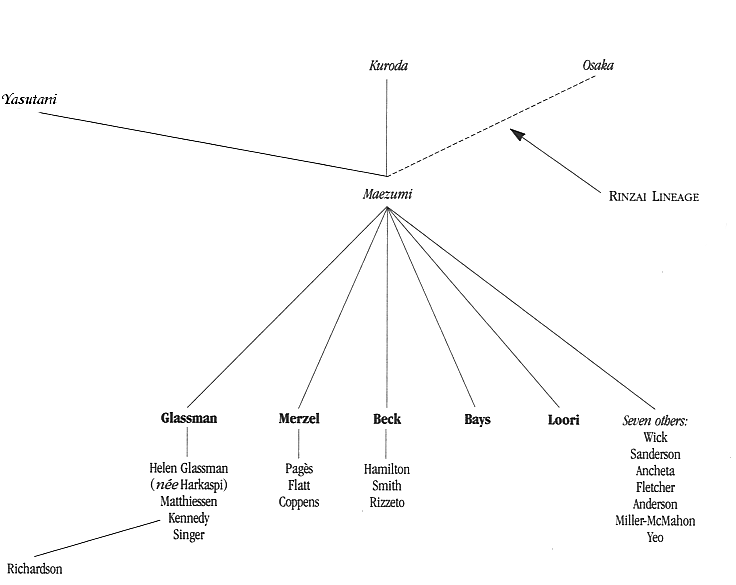
Abb.: Traditionslinien, die von Maezumi ausgehen
[Quelle der Abb.: Rawlinson, Andrew <1943 - >: The book
of enlightened masters : western teachers in eastern traditions. -- Chicago
: Open Court, ©1997. -- xix, 650
S. : Ill. ; 25 cm.. -- ISBN: 0812693108. -- S. 317]
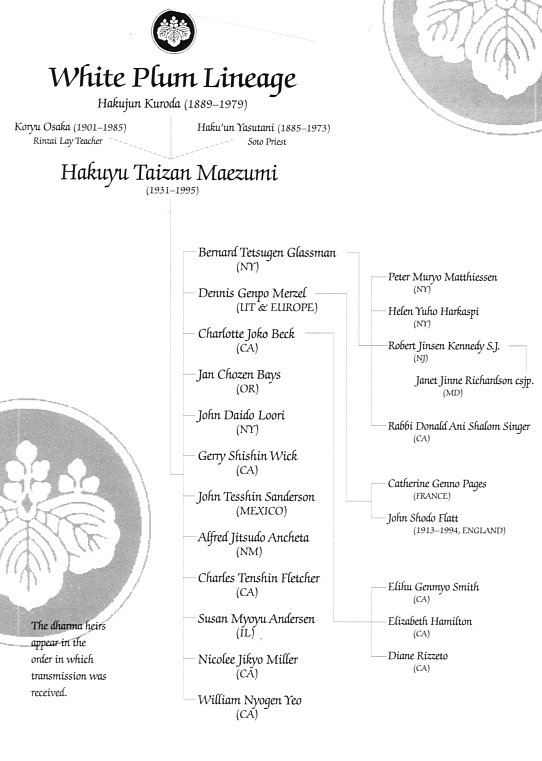
Abb.: White Plum Lineage
[Bildquelle: Tricycle : the Buddhist
review. -- ISSN 1055-484X. -- Vol. V, No.1 (Fall 1995). -- S.
28.][
1969
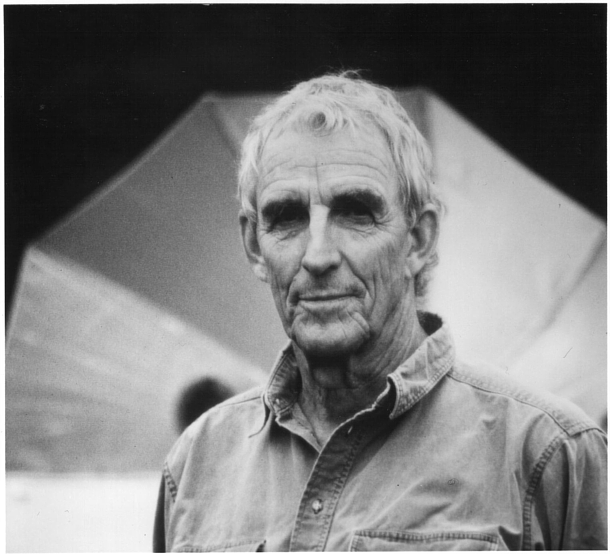
Abb.: Peter Matthiessen
[Bildquelle:
http://www.library.ucsb.edu/administration/development/matthiessen.html.
-- Zugriff am 2005-06-14]
Der Schriftsteller Peter Matthiessen (1927 - ) beginnt bei Soen
Roshi und Eido Rohi mit Zenstudium.
| "Peter Matthiessen, born in New York City on
May 22, 1927, is a novelist, short story writer, and nonfiction
writer who bases the majority of his writing on his personal travels.
He writes about vanishing cultures, oppressed people, and exotic
wildlife and landscapes, combining scientific observation with
lyrical, intellectual prose that connects the world of art and the
world of the natural sciences. “In fiction and in nonfiction, Peter
Matthiessen is one of the shamans of literature,” says John L. Cobbs
in Dictionary of Literary Biography. “He puts his audience
in touch with worlds and forces which transcend common experience.”
Matthiessen wrote his first novel, Race Rock (1954) while
living in Paris. It established him as a serious, disciplined writer
of perception and imagination with a penchant for description. While
in Paris, he founded the Paris Review along with Harold L.
Humes and was its first fiction editor.
Upon returning to the United States in 1954, he settled in Long
Island and worked for three years as a commercial fisherman and as
captain of a charter fishing boat. It was during this time that he
published his second novel, Partisans (1955).
In the late 1950s, Matthiessen began his series of travels that
have informed and shaped his career and life. Between 1956–1963,
expeditions to Alaska, Canadian Northwest Territories, Asia,
Australia, Oceania and wilderness areas of South America, Africa,
and New Guinea resulted in three books of nonfiction: Wildlife
in America (1959), which is still in print and considered a
classic of its form, The Cloud Forest: A Chronicle of the South
American Wilderness (1961), and Under the Mountain Wall
(1962). In addition, he published his third novel, Raditzer
(1961).
With the publication of his fourth novel, At Play in the
Fields of the Lord (1965), which was nominated for a National
Book Award, Matthiessen received considerable critical recognition.
William Styron referred to At Play in the Fields of the Lord
as “fiction of genuine stature, with a staying power that makes it
as remarkable to read now as when it first appeared.” In 1991 the
book was adapted into a film directed by Hector Babenco.
A year after his election to the National Institute of Arts and
Letters (now the American Academy of Arts and Letters) in 1974,
Matthiessen published his fifth novel, Far Tortuga. Widely
considered to be his most inventive work of fiction, it is
experimental in form, consisting mainly of dialogue with varied
typographic formats. It relates the doomed voyage of a group of
sailors who leave the Cayman Islands to hunt turtles in the
Caribbean.
Matthiessen returned to nonfiction with the publication of
The Snow Leopard (1978), winner of a National Book Award.
Written out of his increasing interest in Zen, The Snow Leopard
recounts his trip to the remotest parts of Nepal with the naturalist
George Schaller in search of the Himalayan blue sheep and the rarely
seen snow leopard. In bittersweet remembrance following the death of
his wife, Matthiessen confronts the beauty, mysteries and often
violent world of the Himalayas and his own equally strange and
difficult feelings of life and death. W. Ross Winterowd called
The Snow Leopard “a magnificent achievement, having all the
power of a great novel . . . ”
During the 1980s Matthiessen wrote both fiction and nonfiction
works. In Sand Rivers (1981), which received the John
Burroughs Medal and the African Wildlife Leadership Foundation Award,
Matthiessen describes an extended trek into the Selous Game Reserve,
one of Africa’s largest remaining wilderness areas. With In the
Spirit of Crazy Horse (1983) and Indian Country (1984), he
turned his attention to the history, culture, and political plight
of American Indians. Nine-Headed Dragon River, Zen
Journals 1969–1982 (1986) tracks his practice of Zen Buddhism
to his ordination as a Zen priest. Men’s Lives: The Surfmen and
Baymen of the South Fork (1986) is an elegy for the
deteriorating conditions of the fishing industry in eastern Long
Island. In 1989, his first collection of short stories, On the
River Styx, was published. And in 1990, he published his sixth
novel, Killing Mister Watson, which won the Ambassador
Award, English-Speaking Union. Continuing the experimental technique
used in Far Tortuga, Matthiessen uses ten different
narrators to tell this fictionalized account of a mysterious
execution of a man in a tiny coastal village in the Everglades in
1910.
Matthiessen’s most recent works include Baikal: Sacred Sea of
Siberia (1992) where he recounts his visit to Siberia and Lake
Baikal, the oldest and deepest lake on the planet, Shadows of
Africa (1992), which includes his essays on Africa from South
Sudan to Zaire combined with drawings by artist Mary Frank, and
East of Lo Monthang: In the Land of Mustang (1995)."
[Quelle:
http://www.albany.edu/writers-inst/matsnsa.html. -- Zugriff am
2005-06-14] |
Zu 4.3.2.: Chronik des japanschen Buddhismus
in den USA seit 1970


































































